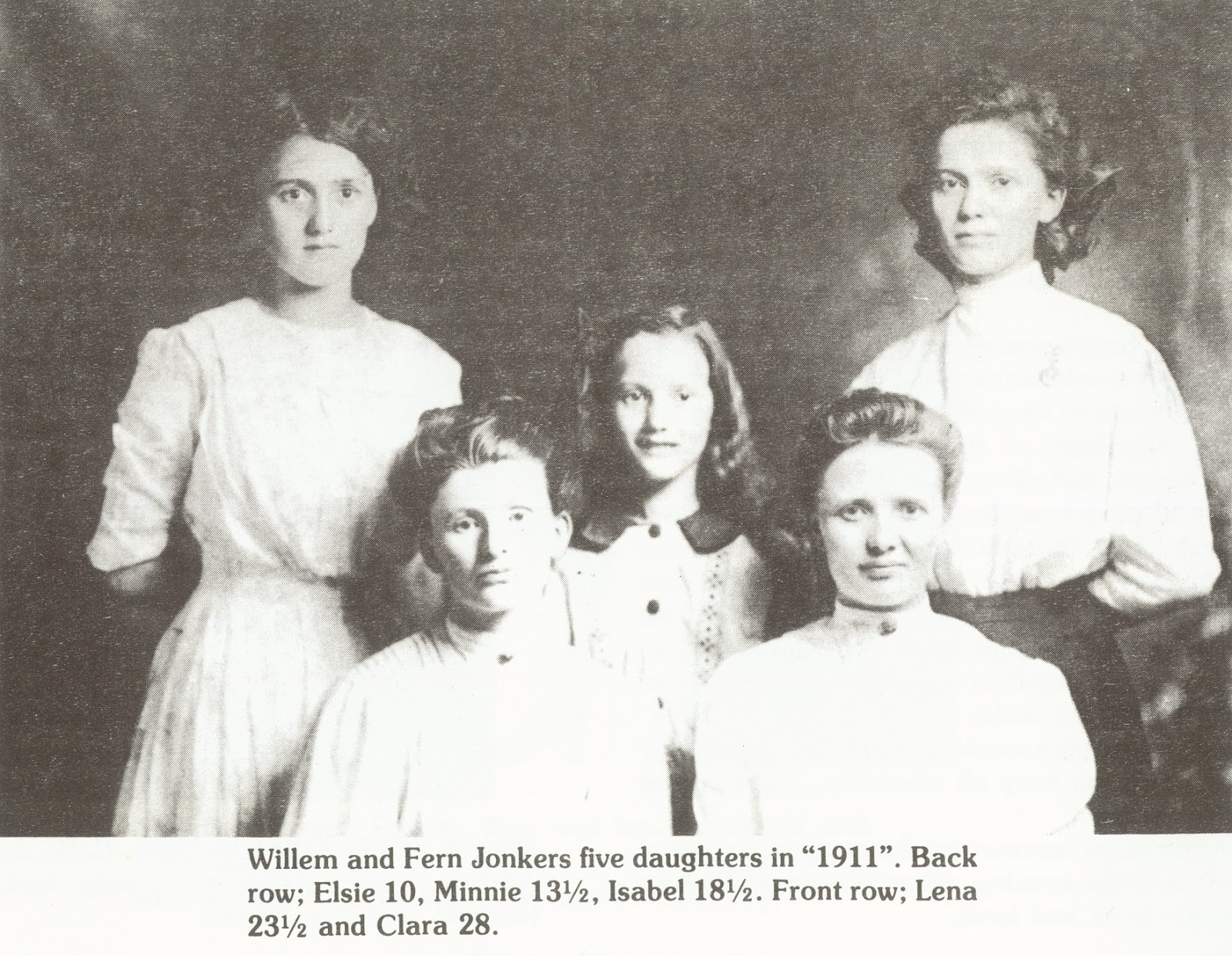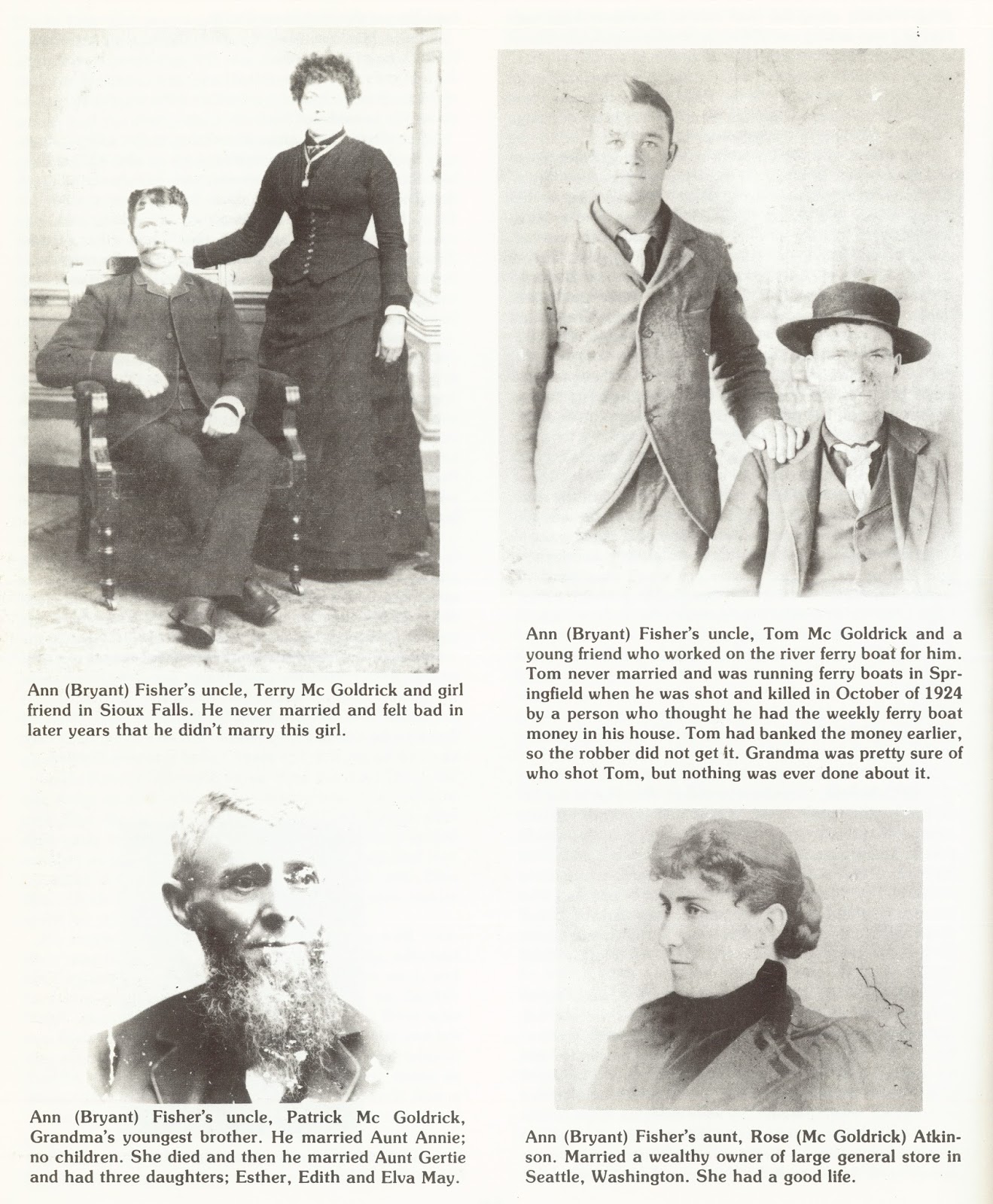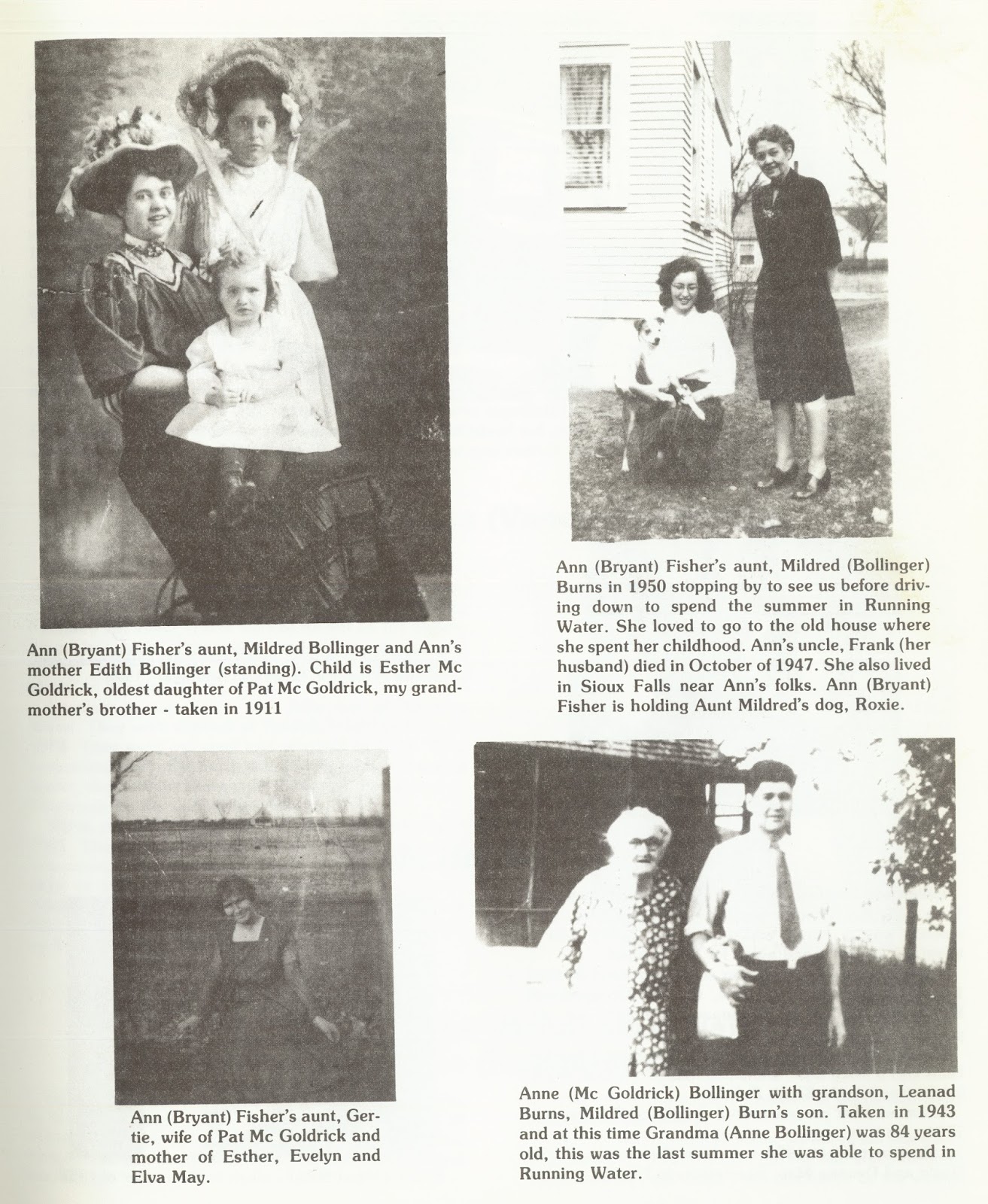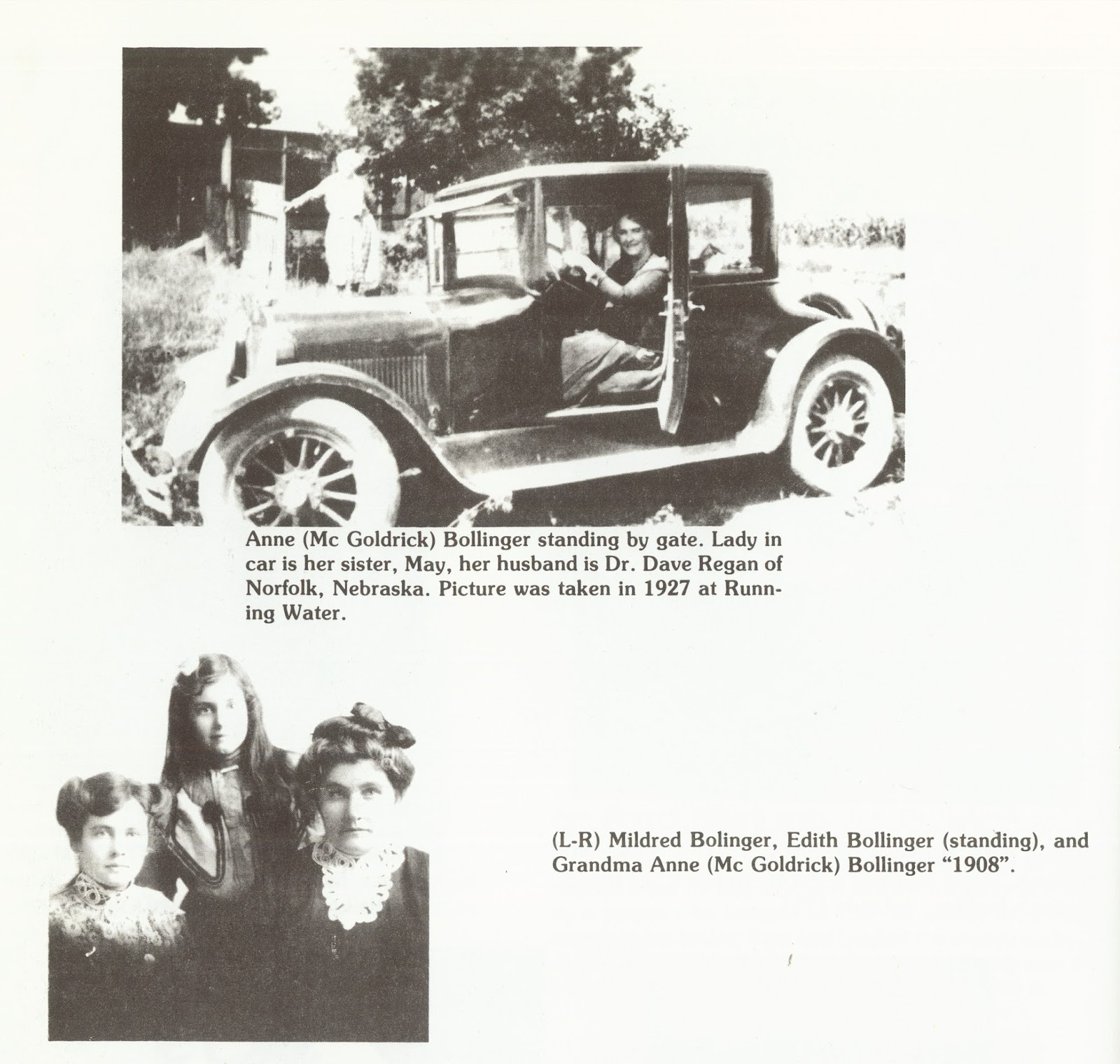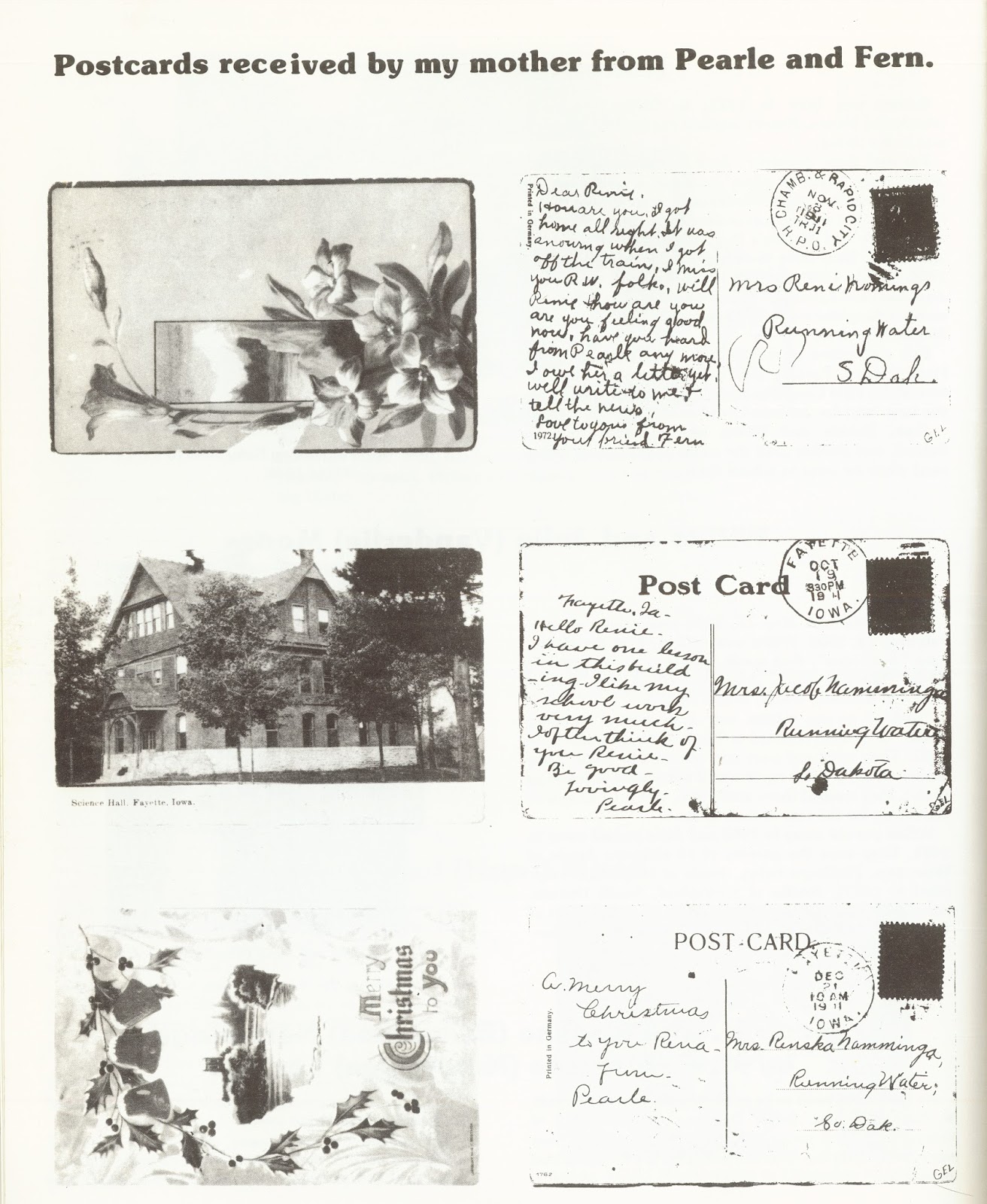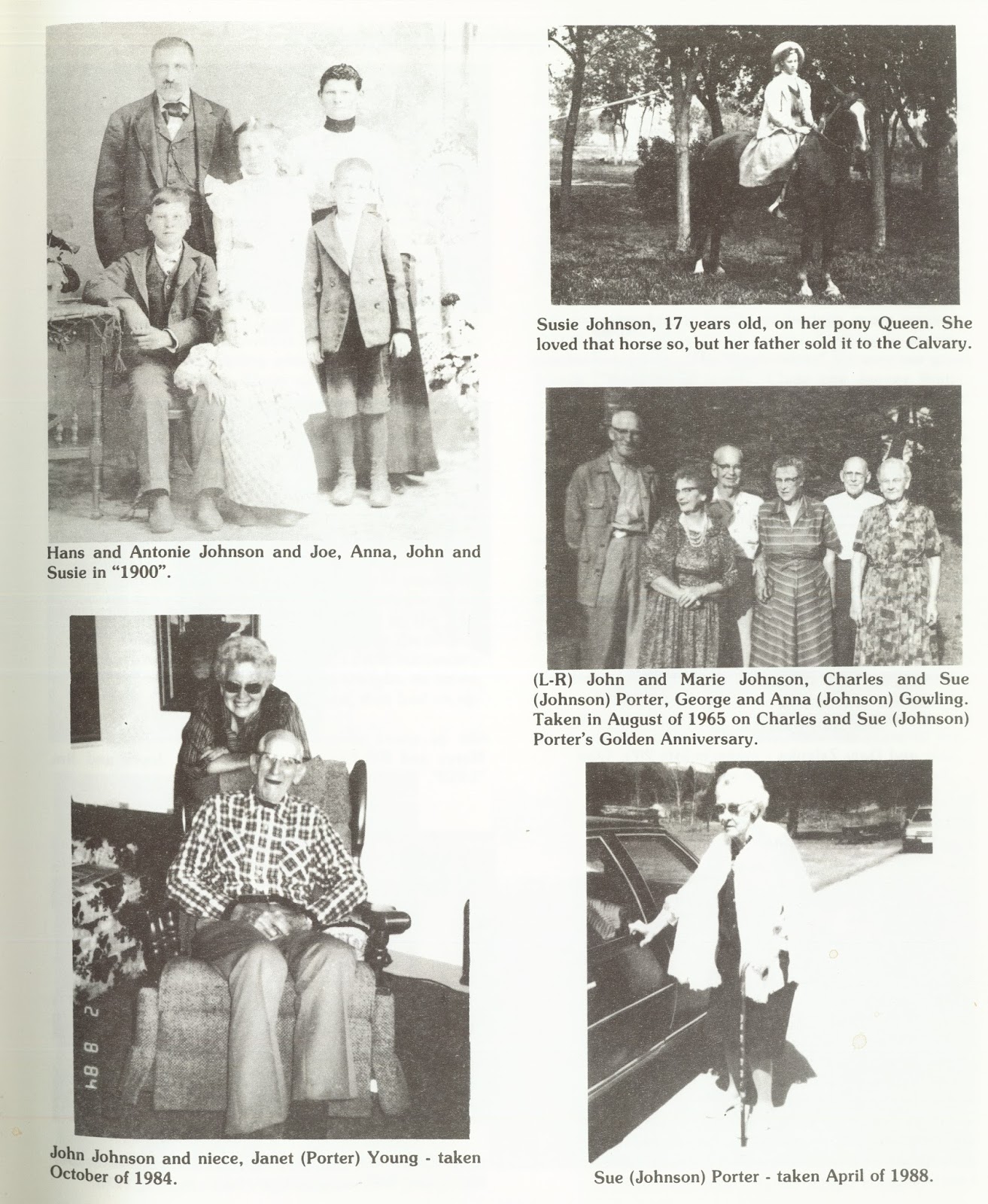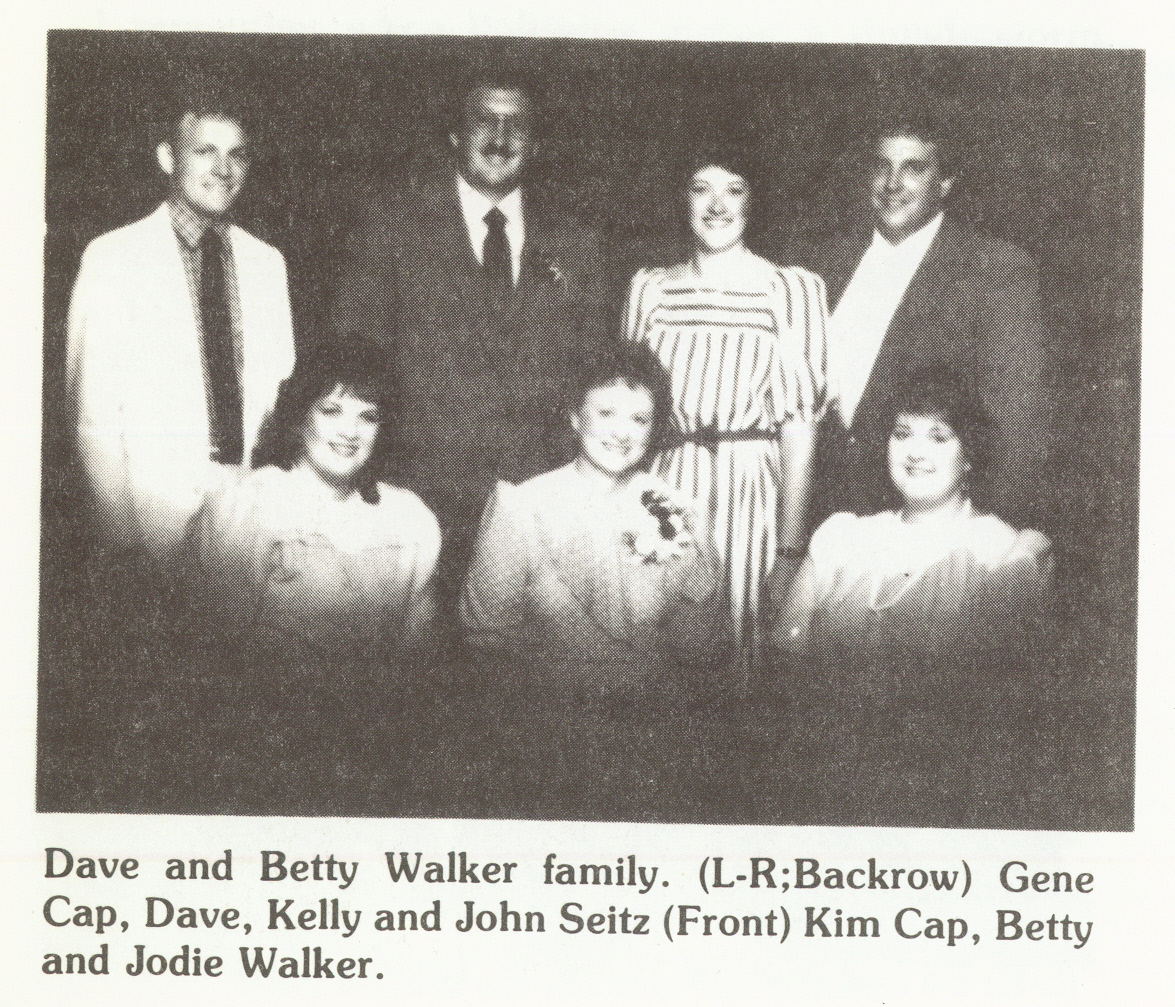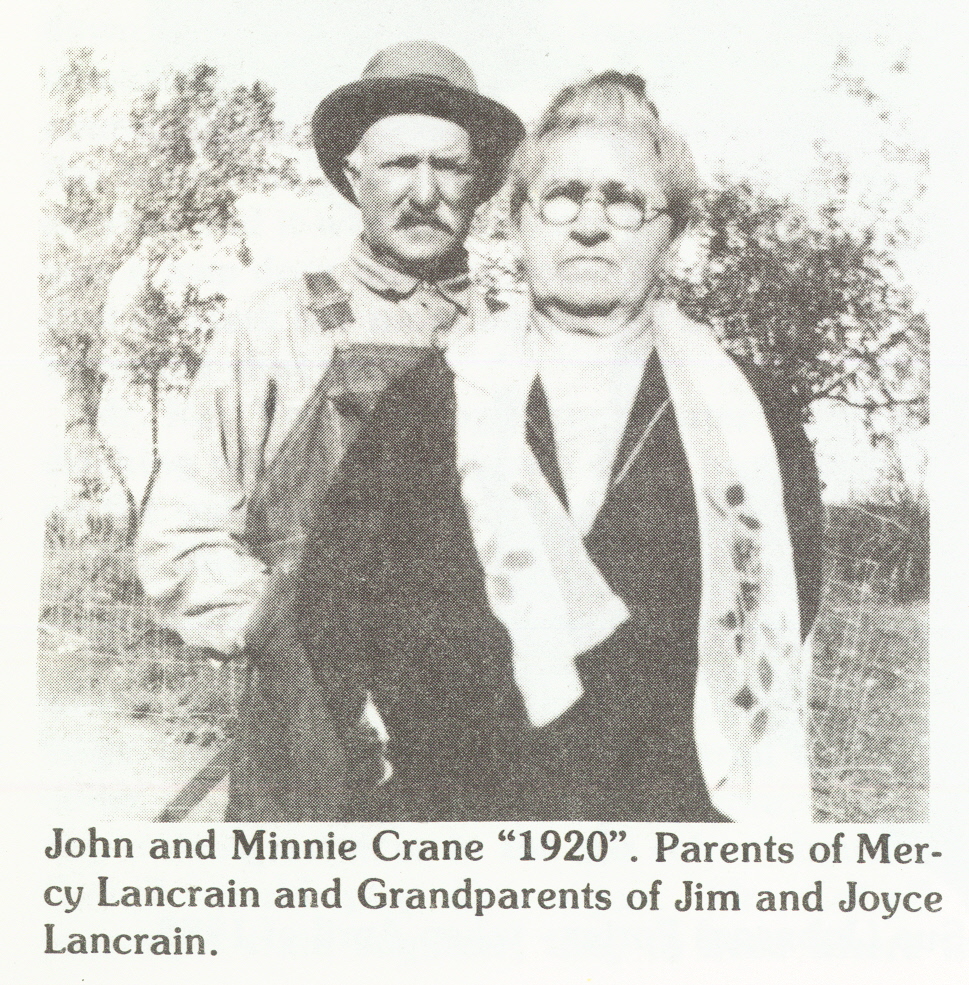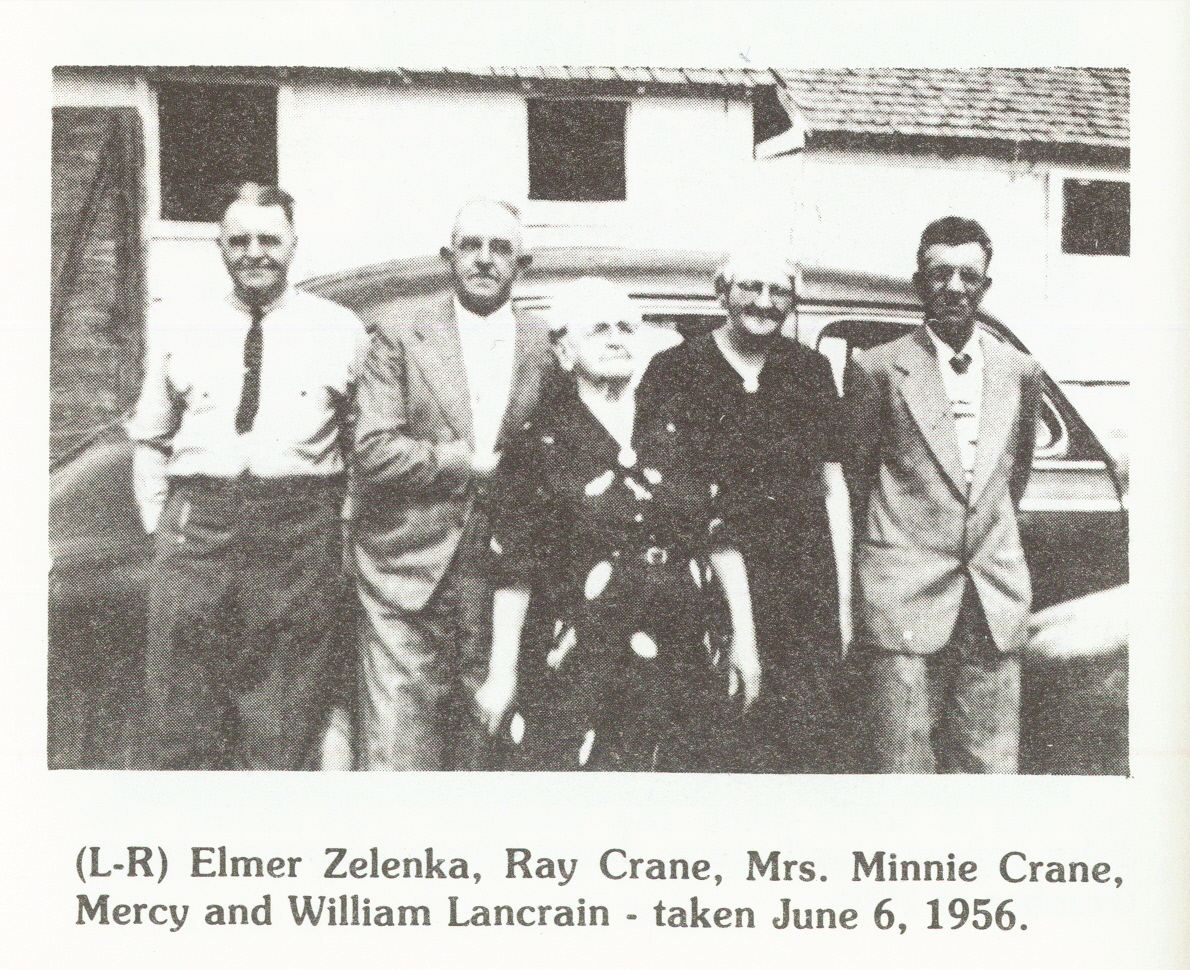

| search engine by freefind |
- Home Page
- Biographies
- Obituaries
- Marriages
- Queries
- Newspaper Clippings
- Photos
- Maps
- Local Contacts
- Online Resources
Ivan Echelberger worked for the Northwestern Public Service Co. for several years. He recalls many things about Running Water. The first line to Running Water was put in 1929, electricity to the homes was the following year (not many home hooked up).
Ivan remembers one year, several people from Running Water took their cars across on the ferry boat to tour around Niobrara, when they came home the hill from the ferry was wet and no one could make it to the top, so the Gowlings used a rope from the ferry and tied it onto their car that was at the top of the hill and pulled everyone to the top.
Peter and Dora (Vanderlie) Dykstra lived one half mile north of Running Water. They moved there in 1924. There children are Andrew, Annie, Jayson, Jessie, Marie, Mable, Ruth, Raymond, Donald, and Darwin. The children all attended the Running Water School.
Peter farmed and Dora was a homemaker. Deceased family members are Raymond in 1982, Peter (father) in 1972, and Andrew in 1965.
Frank and Lena Oorlog DeRoos were married March 19, 1903. They made their first home on a farm east of Tyndall. Later they moved to a farm north of Running Water, and from there to Perkins, where he operated a blacksmiths shop. Moving from there to ar farm near Springfield. He retired from farming in 1931 and moved to Running Water living there until his death February 13, 1949.
They were the parents of 13 children: Cora, Hattie, Jennie, Grace, John, twins George and Nick, Frank, Clarence, twins Pearl and Oscar, Frances, and Robert.
Several of their younger children attended the Running Water school. George, Nick, and Clarence worked for John Fitch on the ferry. Clarence recalls on days when there were no cars to cross he got 25 cents a day, when there were 10 cars he got 50 cents a day.
Six of the grandchildren were born at the grandparents home here in Running Water.
As teh oldest grandchild I remember going to Grandpa and Grandma's house for Christmas and Thanksgiving dinners, and also on Sundays quite often. The may uncles, aunts, and cousins would come too, making quite a house full. The children were fed first and then the adults. Grandma's chicken and dressing were the best.
Many times my cousins and I would ride the ferry boat (free).
by Leona Ruppelt
Clarence DeRoos moved to Running Water with his parents, Frank and Lena in 1931.
He was in the 8th grade and the teacher was Margaret Malone. He and some of the other members of his family along with the Williams girls put on a play in the town hall.
Winter days were fun days for us kids when we could sleigh ride down Running Water hill onto the ice. I also helped John Fitch put up ice. John would saw the ice part way then Clarence would finish the cutting, they put it in the ice building that was located west of John's home. John sold ice to many, one he could remember was the Dutch Church.
Clarence also worked on the ferry and was also a janitor for the Congregational Church for 3 years. He rented the little Hunt home for a few year where he had some cows, pigs, and chickens.
Running Water was home for him until 1940. Clarence is staying in Yankton at the home of one of his daughters for the winter (Duane and Deanna Hill). Before leaving their home Clarence made a comment that seems to be the feelings of many that I have talked to.
"Running Water! Everyone who lived there was your "family," you were in touch with them everyday."
Bob DeRoos moved to Running Water with his parents, Frank and Lena in 1931. He was the youngest of 13 children. He attended the Running Water School. Many of his memories were good and some sound a little mischievious, so we would like to share some of them with you.
Like the time Bob and the Gowling boy would sleigh ride down Running Water hill and one time they couldn't make the corner at the boom and they tore out the fence of Malones (Bob didn't say who fixed it).
His one friend, "Stinky" Sherman, came by his nickname for a reason. Stinky came to school one day with some rotten cheese (fish bait) stuck on the bib of his overhauls and he smelled BAD!
Bob and Doug Williams tried to lower themselves down the chalk rock bluffs one day, as to get inside the cave (no luck).
He also remembers playing on a steel hull from one of the galvinized life boats that was below their place. In latter years the river washed it away.
He and a friend also rolled tires down the hills and one of them hit the apron on the ferry and broke thru and broke the apron on the other side. (Someone bet he couldn't do it. Well, he did!)
Mr. Adam Billman from the General Store is someone he knew well. He would often play checkers with him, Bob never won because Billman always cheated. He recalls Mr. Billman as being a great horticulturist. For about 4 years he had an apple tree peach tree in the back yard of the store.
Mr. Hunt was also everyone's friend. Bob and his friends would often visit with him. He remembers Mr. Hunt as telling them at one time Running Water had 10 saloons.
After graduating from Running Water School he then attended Springfield High School, then he worked in California. Until going into the service, he served 3 years in the European Theatre, 7 years with the Armored Division. He then married Lorraine Halsey on June 12, 1947. He operated the DeRoos Gargage in Springfield for 26 years, then taught a Springfield College until its closing.
My parents were Paytrus and Dora (Bakker) Logterman. When I was 17 years old my folks moved to a farm 1.5 miles north of Running Water (the place that Gerald Tjerdsma now owns), that was in 1927.
Adelia and her dad both worked at the Running Water elevator, she was the bookkeeper and also helped in loading of the box cars. One day a belt came off of the motor located under the floor, and she was scared to death, because of the badger holes and what ever else may be down there. This was the elevator that was next to the round house.
One of Adelia's best friends was Lottie Durphy, they would often run on top of the box cars. Lottie's parents lived in Running Water.
I can also remember helping to get ice out of the river, and putting it in Bollingers ice house, then we shared it.
When Adelia and Jake DeBoer got married on March 12, 1931, they had their wedding reception in the Running Water hall. They had a two man band, she thinks one of their names was Case Konall.
She also played the organ at the Congregational Church for Mrs. Anson Young's funeral in Decmeber of 1930.
Ed and Ardith Davis - In 1983 we purchased Lot 18, Block 12, where the dance hall was located, and then in 1984 we purchased Lot 17. We discovered the smaller trailer tucked away in some trees and weeds when we were up at Running Water helping some friends moved into their house.
After we found out who owned the property with the small gray trailer on it. We purchased that lot (18) and trailer, cleared the land and fixed the trailer up and used it to stay in. IN 1986 we purchased a larger trailer house and placedin on Lot 17.
We have two sons and five grandchildren (so far).
Ed's in the restaurant supply business and Ardith is a secretary.
J. P. Cooley purchased the land where our house is in 1893 from George Snow. W. R. Cooley took over the ranch in the spring of 1912. He retired in February 1958, moved to Yankton and died July 23, 1973.
Carvel Cooley has lived on the ranch all of his life. He became acquainted with Inez Knutson in Vermillion and they were married in 1946. God gave them two healthy sons and this perfect place to raise them.
In all our travels we have never found more beautiful scenery then our chalk rock bluffs and Nebraska hills - a beautiful yellow cottonwood tree in autumn or a viberant red sunset, and of course, the rainbows after a shower.
Our sons, David and Jim are now grown and married, living far away, but we know their hearts are still here with us. We treasure their "home visits."
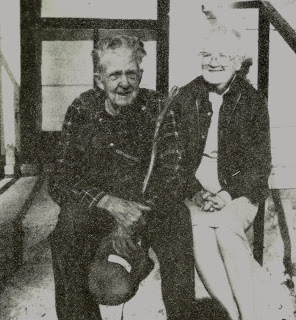
Otis & Ada Cogdill ~ 1988
We moved to Running Water the fall of 1970. We had operated the "Sally Ann" ferry boat, when Otis decided to retire. We bought a house from Dave Einrem.
We have 5 children, 4 daughters, 1 son, 15 grandchildren, 7 great grandchildren.
There were just a few families living here when we came. Running Water has grown. We enjoy living along the banks of the Missouri River with its beauty, peace and quiet.
Lewis Billman's parents were Mr. and Mrs. Adam Billman, who owned and operated the General Store in Running Water, South Dakota. They bought the store from Charles Dunn in 1914.
Lewis was appointed post master in Running Water in 1934. He sold the store and contents in August of 1939 to a Mr. Smith of Tyndall, who was his mail carrier.
Lewis and his wife reside in Sioux Falls, South Dakota.
Frances was born January 18, 1905 to Dorr and Annie Billick. Frances had 2 sisters and a brother, the brother and one of the sisters are buried in Yankton, South Dakota, the other sister died when she was a little girl in 1918 while they were living in Colorado.
When Frances lived in Running Water with his parents, they lived in the west end of Main Street, on the south side in a big two story house. The living room floor was of black walnut, salvaged from a wrecked steam boat on the Missouri River.
Frances died October 1, 1986, in Escondido, California, his wife, June, still resides there.
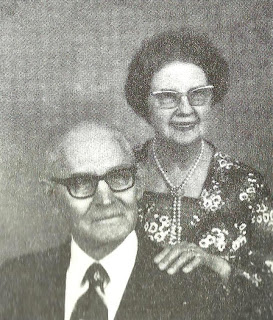
William & Alys Beltman ~ 1972
My parents were Ulbe and Mieke Eringa. There were six children in our family: Grace, Dora, Jessie, Pierre, Thyrza and Alys. I was born in 1909 and lived 1.5 miles north of the ferry boat landing with my parents until 1926 when I moved to Iowa. All of us attended the Running Water School.
I remember many people and happenings in the town of Running Water. The first home on the west end of teh town was Hannah and Bill Malone. Neither one ever married, Bill was a good carpenter. If I rode my horse to school on cold days I would keep him in Bills barn. Margaret Malone was their niece, she stayed with them during teh week to go to school, she went home to her parents farm on the weekends. She and I were the same age, often at noon after I had eaten my cold lunch I would go to get Margaret and Hannah would always have a dish of jello with whipped cream for me. What a treat!
The Jess Bradbury family lived on the south side of the street, they had two daughters: Alice and Carol. The Brays had two sons: Howard and John. In 1900 these boys were in their upper teens. Mr. Bray was a depot agent.
Adam Foster was the baggage man on the passenger train. They say Mrs. Foster danced at the town hall until midnight and that following morning gave birth to twins.
Mr. and Mrs. Bert Walker were the next house and they had four daughters: Alice, Ruth, and twins, Ruth and Helen. Mrs. Walker was the daughter of Hans Johnson.
Next was John and Ella Fitch. Their children were: Lester, Sylvia and Robert. Before them the Billick family lived there. Mr. Billick was also a good carpenter. Both families that lived there were captains of the ferry boat.
Next place was the Brooks Hotel, later the Sabins owned it and about 1916 in burned down. In later years John Terpstra moved the old school house onto the hotel lots and remodeled the school into a home and rented it out to railroad families. I can't recall their names, but one had a niece living with them by the name of Lillian Coombs. She attended Tyndall High School when LIllian Hunt, John Judd and I did, they took the train back and forth each day, but I boarded in Tyndall and came home only on weekends. The train fare was 66 cents.
Next was the post office run by Mr. and Mrs. Anson Young and their son, Ray. They had an invalid daughter named Allie. Ray had a horse named Harry that pulled a cart with barrells so Ray could deliver river water. The Youngs also had a cow or two and they supplied milk for many families.
The next home was Mr. and Mrs. Hans Johnson, he was the keeper of the round house. He made sure the train engine was in good running order. Mrs. Johnson always had a beautiful flower garden. They were the parents of Mrs. B. Walker, Mrs. Annie Gowling, Sue Porter and John Johnson.
The next place set on a higher level. The depot and train track were just below Mr. and Mrs. Ira Cottrell lived here, she was one of our good customers when we had apples to sell.
Then there was a little shack where in my early years a Mr. and Mrs. Jake Messmore lived, she came from the deep south and she smoked a pipe, so we children were scared of her.
Then on the next house it was built into the hill with the top story level with the ground and the south lower level was also on ground level. Mr. and Mrs. Kramer and son, Stanley, lived there. Stanley had a job in the County Court House. Kramers were the parents of Mrs. Zelenka. This was the last house on the southeast end of town.
On the Northwest end was a newer house the first family that I can recall was Werman, then later Mr. and Mrs. Crews, these were all railroad people. Later the Guslafsons, they had a set of twins. Mrs. Guslafson's sister was Lillian Kunz, she taught the Running Water school. She later married Gerrit Dykstra.
Next house was John and Marie Johnson.
Next house was the Captain Leach home, in the earlier years. Later a family by the name of Hills lived there, some of their children's names were Ward, Lois and twins Ona and Olis. There werwe two other children, but I cannot recall their names.
Next was the General Merchandise Store run by Frank Brooks and later by Charles Sunn and his wife, Mandy. After that a Mr. Hornstra bought it and his sister and brother worked with him. Then Mr. and Mrs. Adam Billman from Milwaukee bought it and operated it for a long time. They lived above the store, she had it nicely furnished. In the summer of 1912, my sister, Dora and I took care of the store while Mr. and Mrs. Billman went on a two week vacation and we lived in their home. They had a son, Lewis.
Next was the town hall, where all public meetings were held. Our school had its programs there. We also had Basket Socials there. Voting was there and lots of public dances because of teh beautiful dance floor.
Farther east was Mrs. Bollenger's home, her daughter, Mildred Burns, and her little son lived there. Mrs. Bollenger was a sister of Mike and Pat McGoldereck, who ran the ferry boat in Springfield, I think in the summer of 1921 or 1922. Pat was murdered by an Indian.
Now on the next street north on the west was the Durfey family, their children went to school with me. They were Elmer, Edith, Clarence and Lottie. They had a team of horses, some pigs and chickens.
Next to them was the Catholic Church and just east of it across the road south was the school house. We had a large playground, but no play equipment.
Next to the Catholic Church was the Congregational Church. When the post office burned down in 1916 the Young family moved into the church and Mr. Young operated the post office from there. An offering was taken in the community to help the Youngs build a new home where the old post office had been.
Next was the Congregational Church Parsonage, since no minister occupied it after the Rev. Priestly family. It was rented out to different families. Mr. and Mrs. Hurlbut and two daughters lived there for awhile. He was a conductor on the train. Later a family lived there and the wife was an invalid, her husband had to carry her up the steps to bed. They had a house keeper by the name of Kate White. Their daughter went to school and her name was Evelyn, I think.
Next house was where Grandma and Grandpa Hunt lived.
Next house was where Mrs. Leona Anderson lived with her three children: Annie, Levi and Mae. She was a sister to John Fitch who ran the ferry . Joe Long whose wife was in a mental institution boarded from her.
From there on the town stopped growing. The first school house was north of Mrs. Anderson and on the Joe Zelenka land. Mr. and Mrs. Joe Zelenka lived on a farm east of the school, their children were: Frank, Elsie, Helen and Vern.
There were a few families who lived along the tracks by the depot, they were Mr. and Mrs. Walter Judd. John and Charles lived in a box car converted into a cozy home. The Coynes also lived down there and another family by the name of Pompey, their children Frances and Mildred went to school with me.
Some of the other children that attended school when I did were Walt and Daisy Warrington and the boys of Nick DeVries, they were Tony, Abe and Clarence. Others who lived towards the Cooley Ranch were Sanford and Henry Sell, children of B. Sell, also children of Nick Van Asperen and two boys by the name of Marion and Blaine Covington who lived on the Cooley Ranch where the Jacobs later lived.
I forgot to mention the Wayne Hunt family who lived in the Captain Leach home. AFter the Hills moved out, Mr. and Mrs. Hunt kept rooms. "Baldy" Falling Ramp had room and board there he was the engineer on the train he stayed with them for several years. Pearl Noble (later Mrs. Jim Hubregtse) roomed there while she taught school, she was my eighth grade teacher. The Hunt's parents lived east of teh Congregational Parsonage.
I have many memories of my life in Running Water and I was happy to share them with others. My husband, William and I live in Alton, Iowa. We have three sons Norman, Brian and Dennis.
by Alys Eringa Beltman
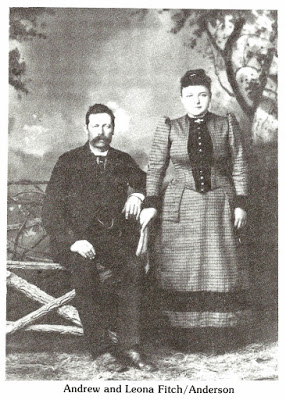
When Andrew Anderson passed away, Leona (Fitch) Anderson and her three children moved to Running Water in 1912. Their children are Levi, Ann and Mae.
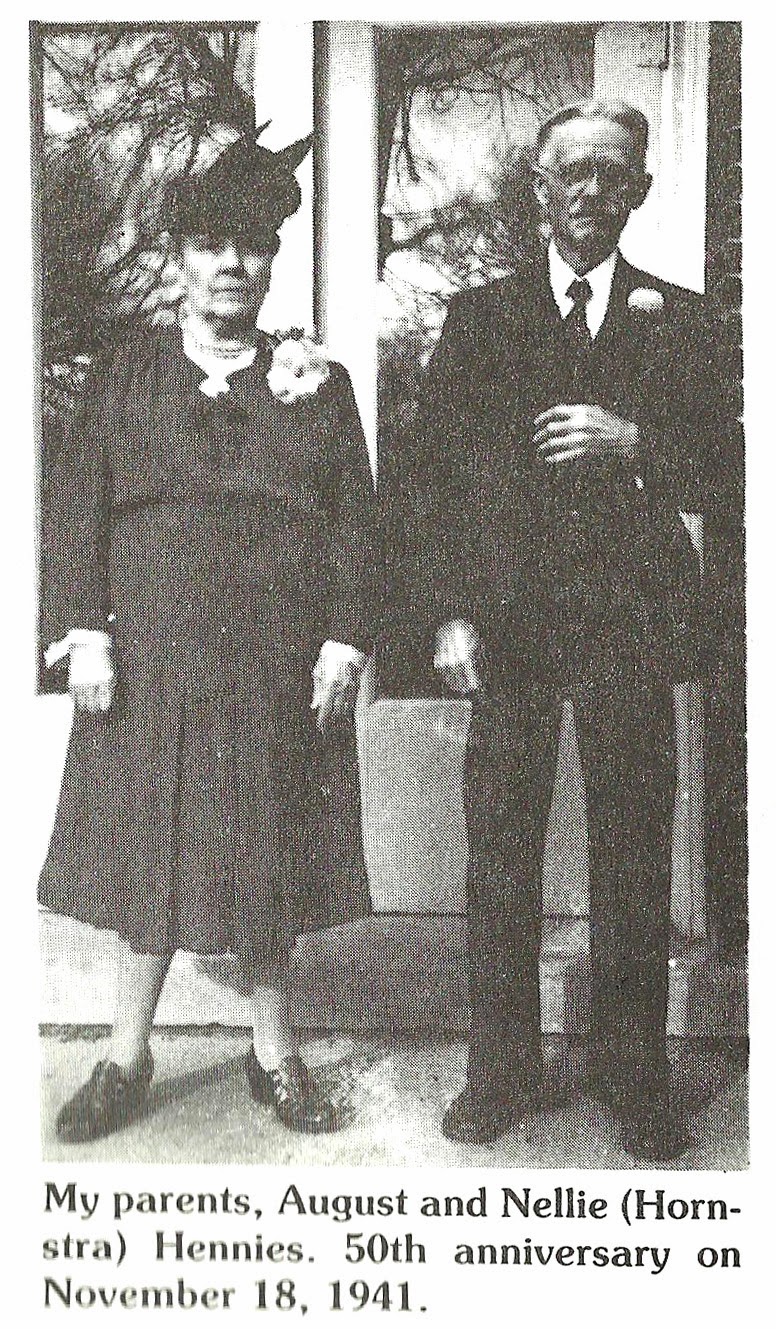
As I sit in my warm kitchen and listen to the weather report it sounds like this winter will be very cold. January came in below zero and now the month is half gone and not many hours have been above zero, this means I will be in teh house an dI will jot down things that I remember and have heard from my parents and relatives, maybe it will be interesting for my family and generations to come. I am seventy-years of age so please excuse the grammar and punctuations. In 1989, seven years have passed and I am now 82 and as Mary Lou (Einrem) Livingston is compiling a book on Running Water, I will add other happenings I have been thinking of.
Running Water was an interesting little town by the Missouri River where the ferry boat would cross to Niobrara, Nebraska. My father, August Hennies, helped build many of the buildings there, the post office, the school, a church, these I remember him talking of. He was on the election board for many years. The hill going north from the town seemed long and steep when we were young and we worried that the car wouldn't get to the top. We lived to cross the river to Niobrara. In the winter several men would haul ice that they cut from the river. We had an ice house and in the summer the ice was good to make ice cream and to keep the ice box cold. My father August Hennies was born in 1869 in Kemma Germany and at th age of 17 he had to decide between Compulsory Military or go to America. He and a cousin decided to go to America and make a life of their own. They had very little money, but had communicated with Americans on the Keegan Ranch doing carpenter work and ranch work. He saved his money and homesteaded on an 80 acre just east of the Keegan Ranch. My mother came with her parents were John and Winifred Gertrude Weimstra Hornstra, she was born Nellie Hornstra in Sheboygan, Wisconsin, 1871. Later they moved to Bon Homme County in South Dakota, where they lived on the farm that is still the Hornstra Farm. Mrs. Fred Hornstra (Ruby) lives there.
My mother's father was married four times, his first family was Cornelius, Freddi, Peter and Egbert born in Holland. His second family was Rachel and Flora. His third wife had no children. His fourth family was Garrett, Hudson, Nellie (my mother) and John. In 1891 my mother and father were married. They lived on the small farm where my father built a small house. He farmed and did carpenter work. Mostly in Running Water, seven miles away. He walked those seven miles when he could do carpenter work. My mother had two little boys, Albert and William (Dutch) and she was afraid to go in the house before my father came home, she and the boys would sit on a bench till they saw my dad walking home. Albert was born in 1893. William (Dutch) in 1896, Arthur in 1903, I was born in 1906, Winefred in 1909, and Helen Florence in 1915, she died in 1917 of dyptheria. We all grew up on the farm. My father made the house bigger as the family got bigger. Working conditions were not easy. My mother had to carry water from the well which was nearly 1/8 miles east of the house. Later a well was drilled closer to the buildings by Dirk Dykstra and it was a soft tubular well, 440 feet thru the sand rock, that must have been around 1915, about the time my father bought his first car, a Ford that had to be cranked. He broke his wrist shortly after we had it when the crank recoiled.
World War I was in 1917 and my brother Albert and Dutch went in the service. Albert joined the army and was in office training first at Camp Dodge and then Camp Fuonston in Kansas. Dutch joined the navy and was in Great Lakes training in Chicago. In 1918 the war ended and they came home. My dad had a hard time keeping the work done on the fram, but he managed to get help. Art was 14 and too young to go to war. He and a neighbor boy would pal around and they wanted to be beig so they started smoking. One evening when he was getting the cows home to milk he stopped behind the straw stack and the match lit the straw and it burned to the ground. When the boys came home from the war my dad had Albert and Dutch's friends to help build a big bar, they made beds in teh corn crib. At night they would go to dances. One night they went to Springfield, one tire came off and rolled ahead of the car.
My sister Winnie and I would help my mother cook. The threshers had their bunk house, but we had to cook their meals. We baked cakes for their coffee times. When the barn was finished we had a big barn dance. My sister was 10 or 11 and I was 12 or 13, that's when we started dancing. We served sandwiches, cake and cookies on the lawn. What a crwwod! My brother Albert played the drums with the Hornstra Brothers Orchestra, Ernie Hornstra played violin, Edgar played clarinet, George played the harp and they also had a piano player. They played for many barn dances and also in the Perkins Hall. Many memories of the days in the 20's and everyone remembers the 30's when it was so dry and the dust was so bad you had to drive with the lights on. Then came the 40's and in 1941 my last child was born and my folks celebrated their 50th in the Congregational Church in Springfield. In 1949 my father was 80 and my mother was 77. They left the farm to retire in California. They lived there for 16 years. My dad passed away in 1962 at age 93, my mother passed away in 1964 at age 92. I reside in Yankton.
by Pearl (Hennies) Balfany
My parents were Paytrus and Dora Bakker/Logterman. I was one of six children - Adelia, Henrietta, Alice, Janet, Thelma, and Calvin. The four youngest went to school in Running Water. Miss Magret Malone was one of our teachers, she taught for several years. Her parents lived one mile north of our farm, we lived about 1.5 miles north of Running Water.
I remember the Billman Store as being huge! Billmans lived above the store, he also had a gasoline pump for selling gas to customers. The post office was across the street and a little to the east. It was run by Ray Young, he lived with his mother and sister in the back of the building. There was a large dance hall near the school, my two older sisters held their wedding receptions there.
Between the dance hall and the school was an open lot and Mr. Billman had a garden there, he would plant some sunflowers, and one day the 8th grade boys jumpbed the fence and took a large head. We older girls joined them, we all ate teh sunflower seeds. Mr. Billman complained to the teacher, and we were all punished by staying in at all recesses for the rest of the week (thank goodness it was near the end of the school year). You can rest assure we didn't do that anymore.
The DeRoo's Fitches, Louis Billman, Irma and Bob Gowling and all of us enjoyed many fun times together, such as a picnic out on the sand bar or a moonlit night sledding down the long hill, leading into Running Water. Many times in the winter all would gather around the Old Stove in Mr. Fitch's shed near the ferry singing songs.
My dad and a group of townsmen would cut ice for our ice boxes. Dad dug a big hole in the ground, packed the ice in straw and built a cover over the ice pit, so we would have ice for a long time. A big home made batch of ice cream was really a treat.
In the summer we would go wading and swimming in the old, muddy Missouri, and to our surprise come winter it was hard to believe the ice could be so clear.
by Janet Logterman/Abraham
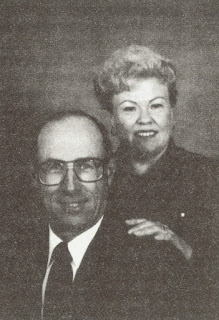
Darlene and I, along with our daughter Carolyn and her husband Tom Moore bought the property in Running Water in 1977. We built the new cabin in 1978 and sold it to Harlen and Carol Ferwerda in 1987. We had some great times there along with some very sad times with the sudden death of our son-in-law, Tom, in 1980.
The river home was a place to relax and enjoy the beauty of the outdoors. Carolyn and Tom lived in Sioux Falls, South Dakota and Darlene and I lived in Des Moines, Iowa. We would meet at the river home almost every weekend from April to November. After I retired, Darlene and I lived there two summers. We would work, fish, hunt, and just relax and enjoy ourselves. We spent many happy days with Carolyn and her girls, Nikki and Kathi. Our granddaughters also enjoyed boating and fishing and riding in the trailer that I built to pull behind my snapper lawn mower.
The fall of the years was such a special time of the year because of the golden colors of the cottonwoods, and the ducks, gulls, and pelicans flying over the river.
We reside in Texas now and Carolyn and the girls live in Sioux Falls.
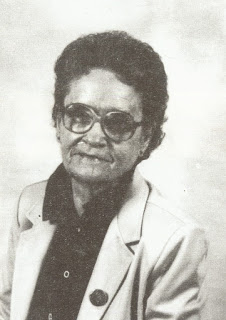
We moved to Running Water March 1, 1947. We bought the John McPeek residence. Our new neighbors to the west of John Terpstra, Mamie Walker, her daughter, Helen, and her son, David. Harold and Ann Kibble lived on the far west end. Across the road from us was Mildred Burns, this was only a summer home for her. East of us was Joe and Katie Zelenka, beyond them was William (Slim) and Mary Jacobs, north of them was Mrs. John Crane, and her son Ray, and Elmer Zelenka. For a short time Vern and Viola Zelenka lived in the small house behind Mildred Burns.
These neighbors became very dear to me. It was so nice to have close neighbors as most winters were cold and blizzards closed roads for days at a time. One could always walk to a neighbors for a cup of coffee or a game of cards to pass the time. I also became active in the Congregational Church Ladies Aid, (at Running Water). They had services there a few times after we moved there, but it was mainly used for social gatherings and Summer Bible School until it closed for good.
Marcleen, Charles, and Mary Lou attended the Running Water School, our oldest daughter Joyce was in high school in Springfield and she was living there.
Carl was a hired man for several farmers. He also did some farming of his own land, along with all that he was a commercial fisherman. In later years he worked at the Kingsburg Elevator and the Springfield Elevator.
I was a busy housewife with a big garden for canning and selling. In later years I went to work for the Southern State College as a cook, then I worked at the Merit Jane Rest Home in Springfield. I also went into homes and helped the sick and disabled.
Carl and I moved into Springfield in 1976. Carl passed away on October 25, 1977. I moved into the Marion Creek apartment in Yankton in 1981, and this is where I still reside.
I have many good memories of Running Water that will never be forgotten. My father was a well driller and I remember him drilling a well for several people living in Running Water, one was my uncle John Fitch, Joe Zelenka, (when they lived on their farm to the north of us) and William (Slim) Jacobs. He drilled many wells in his working years, but I do remember the ones in Running Water. My mother and my uncle, John Fitch, were brother and sister. Uncle John ran the ferry service here for many years.
Before Carl and I married I use to come here to dances, (in the big dance hall). We also shopped at the Billman General Store, and often visited with the Youngs, who ran the Post Office. My mother's oldest sister, Aunt Leona (Fitch) Anderson, also lived here and my folks would often come here to visit. I can also remember visiting with Grandpa and Grandma Hunt who lived in the little house to the west of Aunt Leona. They were such dear people to everyone.
Carl, Joe, and Dave would cut ice along the Missouri River and would sell it for 6 cents a cake. Some of the farmers refused to pay that much, they said it was too expensive. While cutting the ice one day Carl fell through the ice, his brothers were able to get him before the current took him under.
I can't remember whose house it was that my dad moved out here, but Mr. Johnny Blayer bought it and they moved it on his land near Chateau Creek. My uncle, John Fitch's, house was moved to Niobrara, Nebraska and the others I don't know, but these two dad moved.
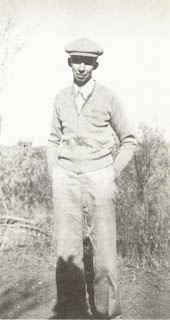
Peter was one of eight children born to Einer and Johanna (Erickson) Einrem on February 12, 1894. He and his brother, Joe, farmed the parental homestead. He also was employed as a salesman for the Watkins Co. for several Years. He bought the John Terpstra home in Running Water in the early sixties. In about 1967 or 1968 he went to Merit Jane Nursing Home in Springfield, later to the Tyndall Good Samaritan Center. He died July 31, 1971.
He was a collector of antiques and was especially interested in Indian Artifacts. He found most of the arrowheads by walking in the Norwegian Hill Area.
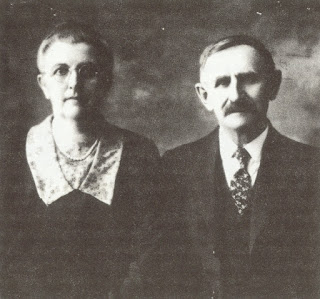
Ulbe and Meike Eringa came from the Netherlands in the early 1890's. They settled in the Running Water area. They had six children: Grace, Dora, Jessie, Pierre, Thyrza, and Alys. The children attended the Running Water School.
Pierre was born July 11, 1902, to Ulbe and Meike Eringa at the home farm near Running Water, South Dakota. He attended the Running Water School He married Lillian Walking September 4, 1924. They resided on the home farm and took over the farming for his father. They lived on the farm until 1969. Herb DeJong rented the farm until Pierre's death.
Pierre and Lillian had 2 children, Urwin and Anita. The children attended the Running Water School, Urwin for 8 years and Anita for 1 1/2 years. Anita finished her schooling at the Donnely School. In 1963 their daughter, Anita and her husband Robert Tjeerdsma moved onto the home place and started farming. The year of 1968 a new farm home was built by Alfred Stockholm.
Harlan and Carol Ferwerda purchased their Running Water home in August of 1987 from Jim and Darlene Egli and Carolyn Moore.
Carol's mother, Mrs. Jennie Odens, was born in Running Water. Jennie is the daughter of the Late Frank and Lena DeRoos. The DeRoos has 13 children. The DeRoos lived in Running Water for several years. All of their thirteen children spent some of their childhood years in Running Water.
I was only 4 years old when my Grandpa DeRoos passed away and then my Grandma sold their home in Running Water and moved to Springfield, but I have some precious memories of all my family getting so excited about going to visit Grandpa and Grandma's house in Running Water, as did all the other DeRoos grandchildren (there were many of us!). I guess that's what drew me back to Running Water and to want to buy some property there. It's just a little extra special to me and my mom and family feel the same way.
Harlan, Carol and 16 year old daughter, Terri, enjoy Running Water every chance they get as do their other children, sons, John and Cindy Jochims of Brandon, Dennis and Darla Jochims and son Jason Stohlecker of Springfield, Richard and Lynda Jochims, Rosanna and Krystal of Valley Springs, South Dakota, daughter Barbra and Loren Gregerson and Justin and Jessica Gregerson of Chamberlain.
Harlan, Carol, and Terri recently moved from Springfield to Yankton where Harlan is employed as a manager with Alumax Extrusions, Inc. Carol has started her own cleaning business and Terri is a 10th grader in Yankton Senior High School.
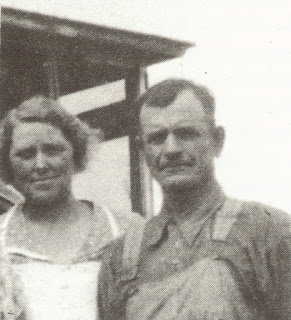
John B. and Ella (Hartman) Fitch and their family lived in Running Water. Their children were Lester, Sylvia, and Robert.
John operated the Ferry Service across the Missouri River for 25 years. He had a succession of 3 ferris: The "Little Pearl," "Falls City," and the "L.S. Robert". He offered ferry service from 1915 to 1940.
John B. and Ella (Hartman) Fitch and their family lived in Running Water during the late teens through the thirties. Their children were Lester, Sylvia and Robert. Those days as a growing boy were a lot different than 60 years later.
I think Running Water had a population of around one hundred. I don't believe it was ever incorporated. We had an elementary rural school of eight grades, which all three of us children attended. Robert was the only one of us that was born in Running Water.
The population was made up mostly of railroad employed people. It was the end of the Chicago, Milwaukee and St. Paul Rail Road Line, that ran to Marion, South Dakota. There was passenger service daily that left Running Water each morning, except Sunday, and returned in the evening. The train was made up of a steam engine locomotive, a mail car, an express baggage car and three or four passenger cars. Then, as I remember, the freight train leaving Running Water would go to Marion one day and return the next day. This was the main transportation moving people, livestock, grain, and mail and other freight merchandise. A lot of this business came from Nebraska.
The railroad company maintained a good depot, round house, coal shed and water tank. This is where the steam locomotives were taken care of each night. The engine would be put on the turn table and turned around. This was done by hand. Then backed into the round house where it was checked and serviced. It would take on a supply of coal and water for the next days trip.
There was a grain elevator and stock yards at the foot of the hill, on the river bank. The elevator burned down and the stock yards were torn down as the river eroded away the land. There was a great tract of land that is all eroded away now.
My dad owned and operated the Ferry service across the Missouri River to Niobrara on the Nebraska side. He also had the mail contract between the Running Water Post Office and the Niobrara Post Office in connection with his ferry service. He operated a bus service for passengers between the railroads, also. The Northwestern Rail Road was from Norfolk, Nebraska to Winner, South Dakota. Students would come down on the Winner Line to go to school at Springfield.
During the twenty-five years that my dad operated the ferry he had three ferry boats, first the "Little Pearl" then the "Falls City" and the "L.S. Robert". This one he had built at Running Water and named it after his three children. He had a carpenter who lived in Running Water named Bill Malone, (he and a sister lived together and I think the house is still there). They had to use steam to bend some of the planks to form the front bow of the boat, etc., to keep them from breaking when bending. It was 65 feet in length and approximately 30 feet wide on the deck. It was powered with a single cylinder gas engine, with two fly wheels that measured five feet or better in diameter. A heavy 12 inch belt conveyed the power from the bow to the stern paddle wheel. The ferries had to be inspected each spring and a licensed operator had to be on board each trip. He operated the "L.W. Robert" until the fall of 1940 when it was ruined in the severe blizzard of November 11.
Many exciting experiences happened during those years on the ferry of transporting horses and buggies, old Model T's without any brakes, herds of cattle, circuses, horse trading Gypsies, Hobos, bootleggers, etc. We were very fortunate that we didn't have any bad accidents or tragedies.
There were lots of times when the engine would stop or the wind would blow the boat onto a sand bar. During the winter the ferry had to be pulled out of the river onto the bank.
Winter time's occupation changed to putting up ice for the next summer. There were no electrical refrigerators during those years, no electricity. Ice was stored in ice houses, packed generally in saw dust. Ice on the Missouri River would get two to three feet thick. It was sawed mostly by hand or horse drawn ice plow, that procedure made uniform size cakes of 18 inches by 36 inches. Ice was hauled by wagon and team from the ice field to the box cars. It was shipped to various towns along the railroad. This operation took from twenty to thirty men, and lasted a ceks. Farmers with teams would earn extra money in the winter by helping. Someone would slip and fall into the cold water at times.
I recall an incident that Elmer Duffy had a two ton model A Ford truck and he went looking for wood one day, driving down the river on the ice. He came upon some thin ice and the truck went through into the river. He got out okay. Later the truck was gotten out some way but I don't remember how.
Entertainment was lots of dances held in the dance hall and in other communities. Occasionally there would be a first fight. There were card parties, picnics, and coasting down hill on a sled in the winter snow was fun.
Billman's Store was the gathering place for local farmers and men around town each evening after supper, to swap tales and discuss events of the day. Saturday night, farmer's night, most everybody would make a trip to Springfield for shopping, business places always stayed open. Mother generally had eggs and some cream to take in to trade for groceries. We always had a cow and a team of horses. My chores were to help take care of them.
I remember when Highway 37 was built down the hill, a lot of dirt was moved with dump wagons pulled with three mules. Some people felt that the mules were very much abused. When the road was completed if you had a car that would make the hill in high gear you had a good car.
Another memory was that mother cooked some evening meals for people staying over night at the hotel, railroad people, and then the school teacher stayed at our house. We had a player piano and people would sit by the hour and pump it.
I think I started to school in about 1918. Eight years there in Running Water and then drove back and forth to high school in Springfield for four years. I graduated there in 1930. Blanch Buck from Springfield, as I remember, was my first teacher.
I attended school at the normal for one year, taught school for 3 years, spent 4 years in the army and spent about 25 years in the banking business. I am now retired and living in Niobrara, Nebraska. For 50 years or more we have been working to get a bridge built across the Missouri River and I am still working on it.
Sylvia Fitch left Running Water in the late thirties and went to California. She married George DeRoos and had one daughter. Sylvia still lives at Pleasant Hill, California. George died in 1988.
Robert Fitch graduated from Niobrara High School. He never married. He was employed at Tom's Music House in Norfolk, Nebraska until his death in 1982.
The Deddo Gelling family lived in the Running Water vicinity from 1942 until 1947. They lived about 2 miles north of Running Water on the George Genant farm. Deddo and Theressa (Rienstra) Gelling were the parents of 6 daughters. They also cared for Mrs. Gelling's mother, Mrs. Feikje Reinstra, who lived with them. Frieda, the oldest daughter, was already in high school, but the rest of the Gelling girls attended Running Water School. They were Minnie, Tiena, Janette, Annie, and Willma.
Deddo Gelling passed away on July 15, 1959. Mrs. Theressa Gelling now resides in Avon Meadow View Manor at Avon, South Dakota. Frieda (Mrs. Ken Van Deursen) lives in Shelbyville, Illinois; Minnie (Mrs. Clayton Wittmeier) at Avon, South Dakota; Tiena (Mrs. Henry Zondervan) at Raymond, Minnesota; Janette (Mrs. Les VandenBerg) deceased on May 17, 1976; Annie (Mrs. Robert Peterka) at Sioux Falls, South Dakota; and Willma (Mrs. Robert Wissink) at Canton, South Dakota.
Memories of Running Water recalled by the Gelling girls were, of course, the school. They remembered that since it was during the war years, they were, as a school project, encouraged to collect and sell old scrap iron. They remembered that one teacher, Mabel Wynia, occasionally used an hour of their school time to take the students out to pound up an old furnace in a vacant building and sell the scrap iron. As an extra reward, the school received a gold colored eagle with little flags attached to it. As individual projects, they were encouraged to collect bones which were gathered from the pastures. The bones were also sold. They also recalled having the opportunity of going into the old Hunt Hotel. One daughter remembered nothing of the interior of the rooms except the large water basins and pitchers in each bedroom, which really fascinated her. Other memories were the pie or basket socials, sometimes held in the school or church there. Also recalled was a chalk rock house or cave, somewhere in teh vicinity west of where the ferry landing was recently located. Also of some of the residents; John Terpstra, who had the skill to make decorative carved cans; Joe Zelenkas; John McPeeks, etc. They have regrets of not recording more of the events that took place during the years they lived there.
The Larney Malone farm located one and one half miles north of Running Water consisted of 275 acres plus about 80 more on river bottom extending south from the ferry landing. On this land stood the round house where the train engine was turned around and also a small stockyards where cattle and hogs were loaded on train cars. In later years, this land all washed away by the river.
Larney Malone had a wife and two children, Harold and Margaret. Two unmarried brothers and a sister lived in a one story house on the west edge of Running Water which is still standing. Two of them taught school and the brothers also did carpenter work.
The Malones, Martins, Donnellys, and Foleys to the north were all of Irish decent and came to South Dakota from Canada originally.
In 1912 Larney constructed a new two story house on his farm. It was a precut structure that Sears and Roebuck sold. He raised hogs and cattle.
Most of the farmers in the area would get their mail in the Running Water Post Office, often in the evening, where they would visit in the store. Sometimes when politics were discussed, there were some heated arguments. One evening in the mid-thirties, he came from from Running Water, walked into his house and dropped dead on the kitchen floor.
They had a mortgage on the farm with the Federal Land Bank which was greater than the farm was worht, so the Land Bank took possession. His son Harold continued to farm the land and also operated a restaurant in Springfield which is part of Springfield Hardware now. In the meantime Harold's sister Margaret died of cancer and his uncles had moved from Running Water to Murdo, where they had a large wheat farm.
In the spring of 1941 George Genant from Orange City, Iowa was visiting relatives at Springfield and was told land was selling for $20 per acre. Therefore, he contacted the Federal Land Bank at Yankton. They still had the Malone farm and George bought it for $6000. The farm yard consisted of one lone tree, the house, a large barn, corn crib, garage and chicken coop, also a well with a windmill on it. The terms of sale were $1000 down with the balance to be paid in thirty-three years. The interest was 4% and taxes $95 per year. He bought the place with immediate possession and became Harold's landlord. The land was then planted to barley and corn. George had a job in Iowa and did not plan to farm immediately. In the later part of November 1941, he received a phone call from Harold Malone who said, "If you want your share of the corn, you will have to pick my share too! I'll pay you 10 cents a bushel, supply a team and wagon, also board and room."
So, George, the landlord, headed for South Dakota the next day to pick his tenant's corn by hand which was flat on the ground with lots of sandburrs and cockleburrs. There was no elevator and the corn had to be scooped into the crib by hand. The crop was not very good and it wasn't possible to pick more than thirty bushels daily.
Then one day, a man, his wife, and six girls came to the field where George was hand picking and said would like to rent the farm. His name was Deddo Gelling. George wanted someone to live on the place so rented it to him. He could apply for a loan from the government on the condition that he farm with horses, not a tractor. They lived on that farm until the spring of 1948 when they moved to another farm near Kingsburg. Finally they purchased their own farm southwest of Springfield.
In June of 1947, George was married at Orange City, Iowa and moved in march of 1948 to the former Malone farm.
A very interesting family were the Homers living in the hills one quarter mile west of Running Water. They occupied a large two story house. The children were quite musically talented and they had a piano. In 1948 they sold their farm and purchased another at Bell Fourche. Anyway, the first week in March the neighbors came to have a farewell party at the Homer place. George Genant was batching a few months because his wife had to finish teaching in Iowa, so the neighbors asked George to come along to the party. Driving through the winding hills was a beautiful experience that night. One could see the lights of farm houses and the town of Niobrara across the river. The Homers were in the process of loading some possessions on one of Fred Dawe's trucks. A good time was had by all visiting and reminiscing. The brought-in lunch was served and enjoyed. Mrs. Homer stated that they didn't know what to do with the piano as there wasn't room for it on the truck. It was a smaller size in mahogany in pretty good shape. They used it for many parties and dances in their home. So for $50 George Genant purchased the piano and over forty years later, the instrument is still being used almost daily by the Genants in their new home in Springfield. It has been tuned only once by John Matuska of Yankton who also put on new ivories for $50.
The land now owned by George Genant including the Malone farm has seven different places where at one time stood buildings or houses. Most of these places were small and usually the father of these families worked in Running Water or on the railroad.
John Terpstra came from Holland in the early 1880's. His parents were poor and his father worked for Ryne Talsma. That first summer he became overheated and died. John's mother later remarried and lived two miles north and one half miles east of Running Water. This 80 acre hilly farm later came into John's possession. Being unmarried, he advertised for a wife and one came from North Carolina. They adopted a girl whose name was Pearl. Later she married an older man, a Mr. Young, the postmaster of Running Water and took off for the West Coast.
George became acquainted with John in 1943. He had retired in Running Water. When a new school was built, John purchased the old one and used the lumber to build his house which is still being used today, the one Otis Cogdill's bought and lived in at first. John had a fondness for the river and Running Water itself. In the early 1950's George would visit John and listen to his stories of pioneer days. the Running Water road (hill) to the north used to be much steeper. To bring loads of grain with horses and wagons took a great deal of skill. Occasionally there were mishaps and injuries.
One of John's stories concerned a seventeen year old boy who lived with his parents in the east end of town. He had younger brothers and sisters. The father worked for the railroad and part-time in one of the four elevators. In those days, when one could read and write, it was considered to be enough education. A seventeen year old was considered a man and was needed to help the family. The particular boy did odd jobs in the Running Water ares. He got acquainted with some horse traders who took him along across the river to the southeast in Nebraska to steal one or two horses. There was a good market for horses in Charles Mix and Douglas Counties. Anyway, they stole a horse in Nebraska and the two horse traders and the boy were caught by a group of vigilantes before they could cross the river. Now, justice, if you could call it that, was quick in those days. Horse thieves, if caught, were hung, unless the sheriff caught them first, then there was a trial. As the rope was placed around the neck of that seventeen year old boy, he begged to be shot, not hung like a dog, as he put it. He is probably buried on the side of the hill north of Running Water.
In 1895 the body of a Mr. Scott, the treasurer of Holt County, Nebraska, was discovered under a bridge south of Spencer, Nebraska. Scott had taken county money, was caught by vigilantes, and hung there. The rope was still around his neck.
John Terpstra was a skilled craftsman and carved wood like chains. He whittled cats and dogs from pieces of wood. He also chiseled stone. George has a piece of limestone on which John chiseled 1900, the year he built a barn. In stature, he was a tall slender man. His wife was a big woman. They are both buried in the Springfield Cemetery.
George and Vivian, Bob and Hazel Gowling, and their sister Erma (Gowling) Johnson, came to Running Water on Sunday, August 31, 1986, to see, and reminisce about their early childhood days. They stopped by our home and shared many of their memories with Ray and I. Nothing looked like it did back in the 20's. But, the memories never changed. They had happy memories of friends and relatives, who also lived there at that time.
Their parents were George and Anna (Johnson) Gowling, their grandparents were Hans and Antonie Johnson.
George sketched a map of what Running Water was like when they lived here, so I would like to share that with you.
George and Vivian live in Minnesota. Bob and Hazel live in New Jersey. Irma lives in South Dakota.
by Mary Lou Livingston
We moved to Running Water in 1971, where we operated the "Sally Ann" ferry. We purchased 3 lots in the River side of the road, from where we could see both the South Dakota and Nebraska crossing flags.
Our children Paula age 10, Troy age 12 and Guy are 13 also helped with the business. All learning to load and unload vehicles, as well as tieing u pth eterry. Our sons became quite good at operating it as well. It was a great experience for us all to be working together.
After 3 years Paul decided to go back to his former employment as a captain on the barge lines and the ferry was sold. Since he flew back and forth to work we were able to continue living in Running Water.
It's a beautiful place to live. There was very few people there and we were able to have horses, dogs and et. after purchasing more property. Little by little the town is again growing, mostly with weekenders and summer people.
We found Running Water to be a good place to raise our children. It's beautiful year round. Always something to do. Boating, swimming and skiing in the clear and clean Missouri River. Good places to hunt, hike and bike. Also winter sledding and ice skating. I am really thankful for the country and the great people.
I purchased part of lot 4 (west part of Running Water) from Joe Holy on March 15, 1963.
Also purchased all of Block 8 from Ralph and Nancy Mord on November 11, 1968 for proposed homesite. I did not build until approximately 10 years later when a basement "A" frame cottage was constructed by myself.
I work road construction most of the year throughout South Dakota.
The main reason I lived here is for the recreation provided by the Missouri River and the easy access to it at Running Water.
In 1961 when I first came to Running Water, a Mr. Roy Blacknik was a commercial fisherman here and lived alone near the ferry landing. John Gretchman ran the Missouri River Ferry and lived just north of the ferry landing. At the base of Spuce Street (south of Block 30) lived Helder Thompson. David Einrem (the Walkins man) and Carl Einrem (Mayor of Running Water) lived at the far east end and Mac McCollum in a small house (the remains are still standing).
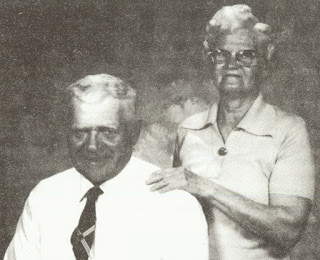
Joe was born in October of 1906 and Elsie was born in October 1912. They have a son, Jim, and a daughter, Mae.
They purchased land at Running Water from Nick Wynia. They then purchased the Donnelly School and moved it onto their land and made it into a cabin. They enjoy gardening and their orchard along with fishing with their son and grandchildren. Their son, Jim and Sharon's children are Karla, Karen, and Joe. Their daughter, Mae's children are Pamala and Marie.
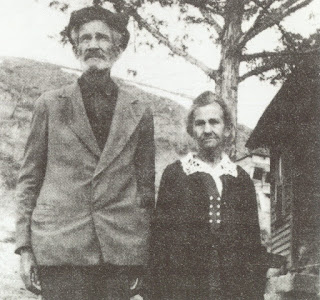
William & Ellen Homer ~ 1925
They lived west of Running Water in the hills, in the former home of his parents, William and Ellen, Ben's father built the house, his brothers, Frank, Otto, Boyd, Charlie, and sisters, Edna and Ellen, all lived there. Ben married Iva Sell and lived there with their family until 1947 when they then moved to the western part of South Dakota.
Ben was born in 1889, Iva in 1896. Their children are Dorthy, who married Gordon Ferwerda and they had 5 children; Vivian married George Stark, he passed away and she then remarried, Vivian and George had 3 children; Wayne married Clara Reid they had one son, Kenneth; Maxine married Harold Johnson, they had no children, she remarried to Robert Burns and they had 10 children; Darlene married Louie Dell, they had 3 children; Bill married Barbara Horton, they have one child; Donald married Rita Horton, they had 2 children, Donald also has 3 stepchildren.
Ben and his brother, Frank, were killed in an accident in 1957. Iva passed away in 1979, also Dorthy and her husband Gordon, their daughter Elizabeth, Wayne's son Kenneth and Don's daughter, Debra. The grandparents, William and Ellen are buried in Springfield Cemetery and Ben and Iva are buried in Belle Fourche, South Dakota.
Ben and Iva were well known as well as Ben's brothers for their musical talents. They played for many house dances. Several of their children attended the Running Water School. Their son Bill worked on the ferry boat for John Fitch.
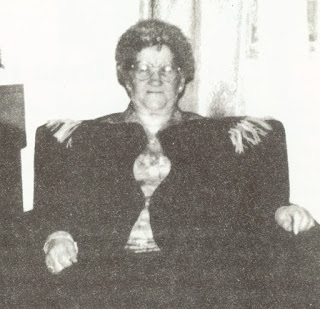
Charles and Thresa Osburn/Durfey moved to Running Water with their family in 1914. Their home was located 1 block north of the Billman General Store. My father was a dray man hauling freight. He passed away in April of 1921. Mother lived there and raised us children, in May of 1940 she passed away.
Ellen Durfey Farris, married Stone Farris and they also lived there after they married until 1931. Stone worked on the section and also worked at the round house. Ellen passed away in McMinnville, Oregon in 1985.
Elmer Durfey worked on the section and farmed for several years. He married Elaine Johnson, they lived in Avon for a few years. Elmer passed away in November of 1985 at Lynwood, Washington.
Edith Durfey Thomas, taught school near Oldham, South Dakota, she passed away August of 1940.
Clarence Durfey worked for farmers, he served in the Army during the second World War. He passed away in 1962.
Lottie Durfey Hoyer, my brother and I were in the first grade at the new Running Water School. I married Hans Hoyer in Oldham, South Dakota in 1932. We farmed near Arlington, South Dakota, until Hans' death in 1981. I now live in Arlington, South Dakota. My grandson and his wife live on our home place.
I have some fond memories of this little town and so do the rest of the sisters and brothers. We take a tour every year and sometimes more when family comes home. We are all excited and glad to hear that they are being included in the Centennial Year celebration.
It was a small town but mighty, with common, plain, kind folks ready to help their friends whenever the need occurred. I grew to young womanhood and left the community when I married in 1948. Some of the things that were small then still remain with me as well as the rest of the family.
The old school house was good sized and in winter so cold that teachers would set desks all around the furnace and our lunch boxes to keep them from freezing in the cloak rooms. Highlight of the school years was the Christmas program, but what made it so special was we held it in the church across the street, where there was a "stage" and we pupils thought we were doing things in a big way. I'm sure this was all added work for our teachers and they were glad when it was over. Our Christmas trees were always large and decorated so pretty and the gifts we made at school for our Moms and Dads were wrapped and under it.
Some Sundays we girls would walk to Running Water and cross and ride the ferry all afternoon, enjoying the beauty and the water.
Sunday evenings in summer jot down again to attend church services in the evening, where Reverend Warner would commute back and forth.
Our grocery store was another nice little place folks would sit and visit after picking up their mail and a few groceries. You could always buy something with our few pennies.
The old dance hall stood south of school, my sister and myself were quite young but we'd watch and try to dance, we liked the lunch counter best with those good hamburgers which was an open door concession stand.
Some of my memories are the winters, sliding down the hill that led tot the ferry. In the warm evenings the children and adults played "Run Sheep Run." I loved to play the piano that Fitchs had, and watching the men cut ice out of the river and putting it in the ice house packed with straw, also taking my pennies or nickels to the Billman store to buy candy, and going to the post office in the evenings for the mail. I would also walk to Zilenka's farm for some milk and cream.
One of our teachers was Margaret Malone. Everyone went to the dances and the Box social that were held at the dance hall. I can also remember helping my grandma Johnson with the alter work and taking flowers there. I also attended the services at the Congregational Church.
These years were in the middle twenties. My parents were George and Ann Johnson Gowling. My grandparents were Hans and Antonie Johnson. I have two brothers, George and Robert.
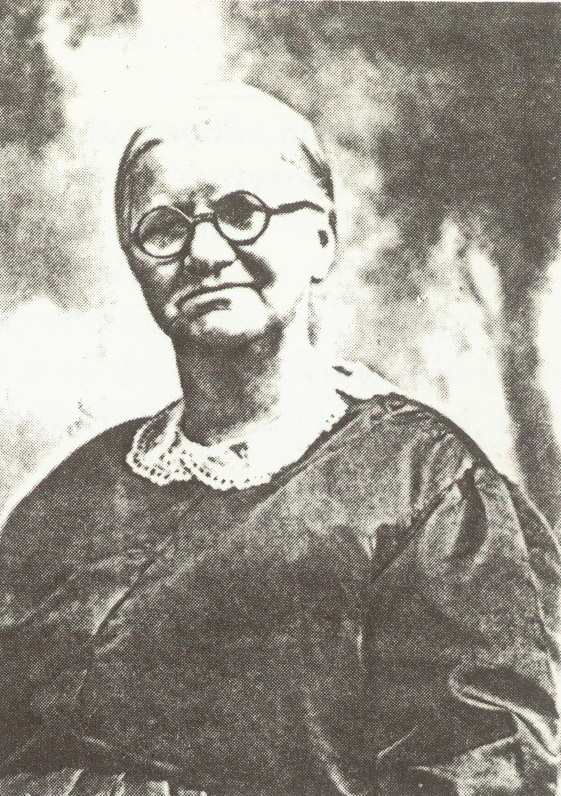
Femmigje "Fern" Jonkers Talsma
The Willem and Femmigje Jonkers family came to America from Wolvego, the Netherlands in the fall, October of 1904, to Running Water, South Dakota. Their children included: Henry 23, Gerard 19, Lena 17, Koendert (Karl) 15, Isabell 11, Minnie 6, and Elsie 3. The older boys picked corn for area farmers including Hartman and Maarsingh, as I recall.
In 1905 another daughter, Clara, her husband, Mike Blom, and small son, Jake, joined the family. Mike also was employed by area farmers until they moved to Charles Mix County. they also immigrated from Wolvega (Friesland), the Netherlands.
The house was so small and with all these people, that during the day they would hang the chairs on nails on the wall to make more room. They also froze to death that first winter with so few provisions.
Submitted by Mrs. Gertrude Crouse, daughter of Gerard & Agnes Jonkers
Copied from a letter to me by my Aunt Isabel DeVries, Belvidere, South Dakota, in February, 1985.
Yes we came in 1904 to Running Water and in March of 1905 we moved to a place by the river south of the Hartman place.
In September, Shaver came to us to rent their 80 acres as her girls were ready for high school (they just had 2 girls then) but they wanted to moved as they did not want to have the place stand empty. This was nice for us as we had to go to school too. the land lay next to Rein Talsma to the south. Shaver had oats that year so they had that harvested, we had corn on the river we could pick that fall. So from September 1905, we rented the Shaver place.
Then on April 2, 1906, when Willem drowned in the Choteau Creek the Blom's worked for the Hento brothers in Charles Mix County; Henry and Gerard farmed a bigger place north of Avon.
Rein Talsma later married our mother Femmigje (Fern) Jonkers.
The Shavers belonged to the Dutch Church which was about 2 1/2 miles east of Rein's place. This is directly east of the Hornstra school.
Wayne Krisl from Slaine County, Nebraska, came to work on the Gavins Point Dam after his discharge from the Army in 1952.
In July of 1955, he met Joyce (Einrem) Lutz. Joyce had graduated from springfield College that spring and began teaching school at Dante, South Dakota, that fall. They married on April 2, 1956. Wayne and Joyce had two children, Bernadine and Larry.
Many happy weekends were spent at the family home of Carl and Grace Einrems, located on the bank of the Missouri River in Running Water.
Fishing was an important part of the memories, fishing with Carl was a fun time as well as educational and the stories of his fishing days are ones he will always remember. Grace was always making food that everyone liked, my favorite was the baked duck and sauerkraut, although no matter what she made it was enjoyed by ALL.
I still reside in Yankton, Joyce died in 1974, and in 1979 I married Sandy Jensen.
Children: Marie (Mrs. Woodrow Johnson), Leonard, Lucille (Mrs. Charles Morton), Edith, Rosada (Mrs. Alan Nelson), Viola (Mrs. Dale Meyer), Leslie, Betty (Mrs. Harold Snoozy). All the children are deceased except Rosada and Leslie. Both parents also.
The house has been gone for many years. It was just north of the highway. It was the first house west of Joe Zelenka, it was across a field from his farm. Just south of the road was Vern, Ruth and Margie Zelenka. I think the house is there yet.
We moved there in the spring of 1932 and moved in October 1934 to Springfield.
D worked for Bill Martin on his farm as a farmhand. He stayed there during the week.
We all went to Running Water school except Betty, Leslie and Marie. It seems there were at least 30 kids and probably more since our family had 5 kids enrolled. We had one teacher for all grades and I don't think she had any outside help.
Some of the people I remember who lived there were the McBrides, who lived just west of us. There was a creek right by them where Leonard and Rex had a road for a wagon they road down the bank. I don't believe it ever had water in it. Our cousins moved there after we did. They were the Bert Williams family. They lived on the river side of the highway. DeRoos lived on the corner northeast where the road turned north then south to the ferry boat. The store was run by Billmans. They had a grown son. Lucille used to help Mrs. Billman in her house. Margie Zelenka lived there and we played with her a lot. her and I used to make paper dolls and clothes for them from school paper. Dykstras lived on a farm north of us across the field. They had about 7 kids. Violat used to play with mabel, Marie and I were same age and Lucille and Jessie were good friends. Alice Jacob lived a mile east on a farm and Lucille and her were good friends.
When we moved to Springfield all us kids hated it. Marie, Lucille and Leonard drove a team of horses pulling a hayrack load of hay with a cow tied behind it to Springfield.
There were quite a few families in Running Water when we lived there. There was a small post office where the mail came in each night about six. We walked there to get our mail.
When my parents bought the home of John McPeeks in Running Water I was 9 years old. It was truly one of the nicest homes I had ever seen. The old muddy river was just beside out home, the school was only one block away (if you crossed the field). My first teacher here was Betty Wynia. Erwin Eringa, Janette, Annie, and Willma Gelling, Joyce Lancrain and Darwin Dykstra were the only ones attending the school, so when we moved here Mrs. Wynia got three more, my sister Marcleen, Charlie and me. My sister, Joyce, was in high school and she lived in Springfield. Coming here to a small school was different for us as we had always attended larger schools. In early spring of 1948 the George Olson family moved here. They moved into the house just west of us. They had four children, Carolyn, Gary, Gayle and Jennie. Then Helen Walker moved here and she had a son, David, so our town's population seemed to be changing and the school was getting bigger. The George (Swede) Olson family moved here because of the ferry boat, George's father, Henry, owned the ferry "Bertha" so George came here to help.
Other neighbors in Running Water were John Terpstra, Mamie, Helen Walker and Helen's son David, Harold (Bud) and Ann Kibble, Mrs. Mildred Burns, who came here just for the summer months, Joe and Kattie Zelenka, William (Slim) and Mary Jacobs, Vern and Viola Zelenka. So we had several close neighbors. School was seldom closed due to the weather as we were all within a walking distance. Our teacher the second year was Harold (Bud) Kibble, that was a real treat as we learned how to ply marbles, jump rope competitions and if you didn't have a dog at home you had one at school, Mr. Kibble had 2 coon dogs who were in attendance at school every day. One of them always layed by my desk, the other one by Mr. Kibble, or in the cold of the winter they would lay around the big black stove. One day in the spring of the year the dog laying by me got sick and vomited green grass all over the floor, Mr. Kibble picked it up with the coal scoop and went on with school like nothing happened. The only one who knew different was my stomach, the dog and the smell stayed for the remainder of the day. Mrs. Walt Einrem (my cousin's wife) was my teacher for the next 2 years. Then Mr. Don Tjeerdsma, that was my last year of grade school and the last year of school for 2 years. They reopened the school but only for a few months, then it was closed permanently.
Some of my good memories of school days were the field days hiking the hills, the competition ball games with other schools (even though we lost), also the Christmas programs and the school picnics at the end of the year, especially the picnic we had in the Niobrara park. My dad was a commercial fisherman and a farmer, and often my brother and I would be up early to go check the nets with Dad and help clean fish if needed, so if it got warm in the school you could usually tell where the Einrem kids were sitting. Rotten cheese (for fish bait) and the wet fish smell seemed to cling to ones hands. Need I say more.
Winters were often very long, but we usually found something to do, if the neighbors were not at our house we were at theirs. Monopoly was a game we all had, as well as the marble game that our dads made us. Cards were something we all loved to play even the adults, night and daytime sleigh riding was also a fun time for all of us kids, with all the big hills around us. We didn't have very many sleds so we made some out of trunk lids and we also used old tires. My cousin, Walt, made all of us skis out of a board and tin, and could we ever go on them. One year we had lots of snow and the fences were covered so we could start out at the far hill, north of the school and ski all the way down to our place. One big challenge was to see who could stand up in the trunk lid and go over the highest snow drift on the hill and still be standing when you go to the bottom. Well, guess who always won? Everyone would bet money that it couldn't be done, and now that I think of it I never did get the money, (Hmm).
Pancake Days in Niobrara, Nebraska, was another big time, as Dad would drive the 1929 Chevy on the ice and we would stay over there for the day, many times when it was time to come home the ice had melted enough so we melted so much Dad had a hard time getting the car to Niobrara for groceries. Dad put the groceries in a gunnie sack and tied it to the sled. We would both carry a stick to test the ice that we weren't sure of, before we would walk on it.
Summer time here was like every place else "HOT." Dad and Mom owned property all over in Running Water, so if Dad wasn't farming the land he had cattle on it in the day time. When the cattle were in the pasture by the ferry landing, that was always a good time for a swim (even though we didn't know how) and then bring the cows home. My brother, Charlie, and I always had set lines in the river so while the cows were getting a drink of water we would check the lines. One summer eve as I went over to the pasture to bring the cows home a covered wagon of Gypsies were also going to the river and camp, as the ferry was docked for the evening so they set up camp at the landing. There were always lots of Gypsies with their covered wagons passing through here, they were usually not friendly but these were, so I went over and started talking to them, it was an old man and woman. I was a little nervous because my folks had often told stories of how the gypsies would steal anything even children, so we were told to come right home if any of them came around. anyhow I knew no one would take me, they were so friendly. The lady asked me if my mother would have any soap she could buy, I told her I would ask. But! I told her my mom didn't have boughten soap, only homemade lye soap. "Oh!" she said "I will even pay more for that, because that's much better than store boughten." So home I went with the cows, and to tell Mom I had been visiting with the gypsies and they wanted to buy some of her soap. WELL! Mom told me in a "BIG" way I shouldn't have talked to them they were bad people, she gave me some soap and told me to give it to the lady, not sell it to her as we wanted to stay on the good side of them, so they wouldn't come steal from us come dark. So away I went with 2 bars of lye soap, the lady was fixing pancakes for their supper when I go there and I HAVE NEVER IN MY LIFE SEEN SUCH BIG PANCAKES! They asked me to eat with them, because they were so happy for the soap they wanted to share their meal with me, I assured them I wasn't hungry, the lady then asked if I could write, I said "No but I could print", she wanted me to write a letter to her daughter for her. It was getting dark out so the lady lit the kerosene lantern and inside the covered wagon we went. That was kind of scary, I will never forget it. their bed was in the front with piles of clothes, a big trunk and some wooden boxes, she hung the lantern on a hook in the middle of the wagon, then she got a sheet of paper and a big round pencil out of the trunk and gave it to me. I was still a little nervous, so I told her maybe I could see better if I sat on the tongue of the wagon, so I did. She told me what to put down and then I went to the river with her while she washed clothes. The next morning when I took the cows to the pasture they were still there and the clothes were hanging on the barbwire fence, I told them good-bye and that was the last time I saw them.
One other afternoon when I went after the cows the sheriff's cars were blocking the road going to the ferry, so I walked up there to see what was going on, they explained to me that a man who killed lots of people was headed this way to cross on the ferry and they were planning to catch him if he came. They were walking around with their guns in hand ready to shoot if they needed to . I didn't bother them too long as they were very friendly to me and answered all my questions best as they could, so I skipped along after the cows and we never heard any shooting so the criminal must not have shown up.
Mrs. Burns was a very dear friend of mine, she lived across the road to the north of us, she usually came in the spring and stayed till early fall. She paid me $1.00 a week to haul her a pail of water from our cistern each day. I often stayed and visited with her and her dog, Rocksie. Many evenings she would invite me over and she would play her old pump organ and I would sing. The organ had a shelf on each side to put the kerosene lamps on, she also had a picture of her boy on there. The organ was beautiful, Mrs. Burns often said when she no longer could play it I could have it. She said she bought it from one of my relatives, however I have often wondered what happened to it, I never got it.
This is just a small part of what life was like for me as a child growing up here in this little valley. The June floods were one of the bad times here, we were usually fortunate to recover after them, many weren't. I do have good memories of friends, relatives, and everyday happenings in this little village. Only just yesterday I talked to someone who once lived here as a kid when I did. I asked if they would like to share their memories, they replied "What memories there was never anything here." So life is just what one chooses to make of it.
Many years have past since my childhood, I married Delbert "Ray" Livingston in 1954, we have lived in Yankton and Running Water always. In the early 1970's we bought my folks place here at Running Water. Ray and I still enjoy the river, we spend many hours hunting and fishing. We own Modern Body Shop in Yankton, so our time is divided between homes. We have four sons, Ronald R. is married to Ruth (Matteson), they live in Springfield, South Dakota, Darrell C. is married to Nancy (Cwach), they have three children, Mary Beth, Jennifer and Carl (C.J.), they live in Yankton, Alan (Cork) R. is married to Gail (Weisser), they have 2 girls, Lindsay and Jessica, they live in Yankton, Kevin L. is not married, his "love" is "Sail Boards" (as yet), he lives in Yankton. All our children and grandchildren have spent their childhood and adult years here at Running Water, they all share good memories with us.
I work as a Bailiff for Yankton County, and also do the bookkeeping for our body shop, along with that we are members of Trinity Lutheran Church and I belong to the Arickara Chapter of Questers, and my bridge club that have been together for over 25 years. This is what makes ones life so busy and memorable.
In 1952 I graduated from Burke High School in South Dakota and came to Springfield to attend trade school at S. S. T. College. I chose to learn to be an auto body repair man, which had been my career for 36 years.
I met this tall blonde Norwegian girl that was so neat and genuine and cheerful. I took her to a prom at the college, she said I would have to take her home out to her parents place at Running Water after the dance. I had no idea where that might be, but eventually we came to this long hill, and I thought I saw a reflection from the headlights of my "41" Chevy on the water, about that time she said turn here. I was going too fast to turn, but I remembered that reflection and instantly not knowing how close the water was I turned, I used up all the road and probably part of the ditch to make that turn, but Mary Lou Einrem was home safe and sound from her first prom date with that kid from west river. There must have been an attraction there or something unexplainable as I have loved the blonde and the river ever since.
We have raised four sons and the river in the Running Water area has given us all countless hours of recreation and enjoyment.
Some of my favorite memories are of my father-in-law, Carl, and I going up to Greenwood and putting his boat in there and running his fish nets on the way down to Running Water. I learned a lot about the river and fishing from him. When we got back it was usually afternoon and we really had an appetite, then my mother-in-law, Grace, would have a feast prepared that would accommodate a threshing crew.
We have always lived in Yankton where I have my business, Modern Body Shop Inc. Mary Lou helps me with the book work and she also is a Bailiff in the Yankton County Court System, (and she researches and writes historical books.) So on weekends and holidays or anytime off we head for our place up river. I have several friends who have moved to the sun belt and they always ask why we don't move south or to the coast, my answer is "THAT ALL THOSE PLACES ARE SURE NICE BUT THEY ARE TOO FAR FROM RUNNING WATER."
If my memory serves me correctly, as told by our folks, two creeks were named by our forefathers. The first was Coffee Creek which was about 9 or 10 miles west of Springfield where Grandpa Wynias first lived in a log house. Later when our folks were married they lived there and Grandpa moved to the place 3/4 miles north of where Petersburg used to be. This creek got its name because the Indians used to stop by the Wynias and they would often trade coffee for blankets that the Indians got from the government. So it was called Coffee Creek.
The other creek was Mule Creek. It was about one mile east and one mile north of Running Water. It happened that our Dad and 2 sisters, Bertha and Jennie, were coming home from Running Water when a wall of water (result of a cloud burst) came rushing towards them as they were crossing this ravine. Somehow they were saved and the one horse they were driving with was a mule, but the mule drowned and so it was called Mule Creek.
On November 14, 1981, Allen, "Brute", and Alice Marek bought their Running Water cottage from Everett C. Thompson and Betty J. Wittrock, a brother and sister of the late Helton Thompson who owned the house.
The first two summers were spent remodeling and extensively reconditioning the house. Once the house was modernized with an up to date kitchen, new plumbing, electric heat, new wall and floor coverings and new windows, it was time to start on the grounds. Some outdoor changes including removing most of the surrounding forest, looking for the grass underneath an over vegetation cover, digging a new well pit and the installation of a boat dock, used mainly for sunbathing , fishing and dry landing to put on your skis before jumping into the water.
Most of the work on the weekend hideaway was done by us along with the help of our daughter, Trudy, her husband, Douglas, and their three ever ready to help children: Aaron, Amanda, and Allison. We hired some outside help for some of the specialty projects, but most of the sweat was on the family brows, which makes our riverside cottage something very special to us.
Running Water has a less than ten population during the week, but by 9:00 p.m. Friday evening, there will be more than ten boats tied up to docks along the South Dakota shoreline. The little city's size grows considerably on the weekends. Some come to fish, some come to ski, some come just to enjoy being with family and soaking up some of that warm summer sun. Whatever the reason, it's just a nice quiet place to come to and get away from the hustle and bustle. Just a nice quiet recreation spot on our Missouri River in the state of one hundred years, South Dakota. Stop in and see us!
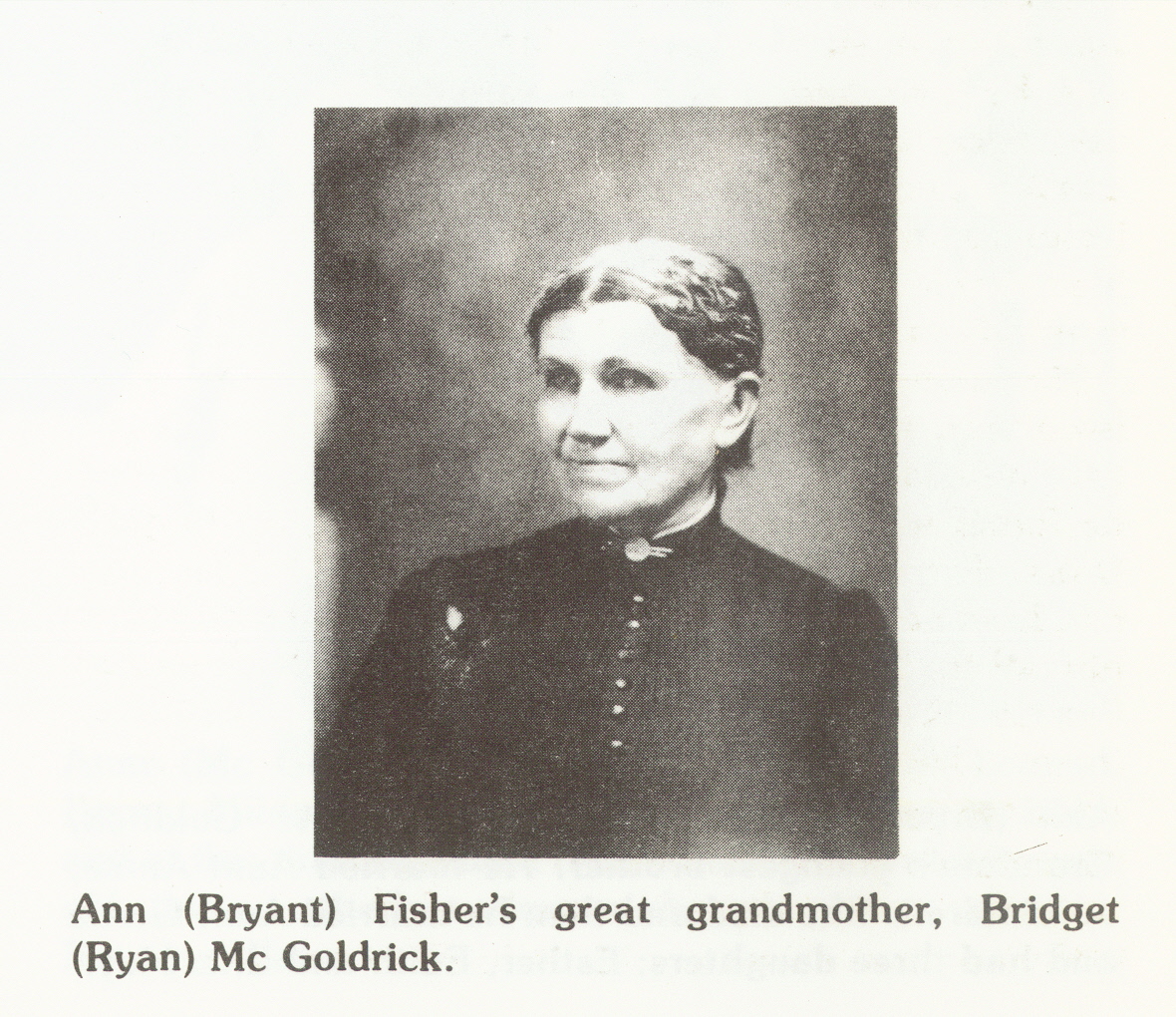
When I was a child, everyone told me I was the image of my maternal grandmother, McGoldrick Bollinger. I couldn't see it then but now that I am sixty-four, I see my grandmother every time I look into a mirror. She was hardy Irish stock, touch to the end of her eighty-six years. I thank her for her healthy old genes. When I walk the streets of Running Water this summer, I will feel like a ghost from the past.
The last twelve years of her life my grandmother lived with my Aunt Mildred and Uncle Frank. But every summer till she was eighty-two, she went to her old house in Running Water all the summer months. I was a high school girl during the last three trips to her beloved house, and I stayed with her to help. It was during these warm summer evenings in 1941-1943, as we sat on her screened porch watching the moon rise over her beautiful river, that she told me these stories about the early years.
The history of our McGoldrick family (as far back as I know) started with the famous Potato Famine in 1846. There had been an earlier potato famine about 1812, but the people managed to survive that one. However, in 1846 they were desperate and this is the time when the great Irish immigration to American began.
My great grandmother, Bridget Ryan, was born about 1823 in Cork County. She was married to Edward McGoldrick when she was sixteen years old. Edward McGoldrick had a merry heart and a beautiful tenor voice. He loved to sing an Irish tune. They say he often danced an Irish jig while working in his barn. When the potato famine hit, my great grandmother was a young farmwife about twenty-three years old. By this time she had four small children. The decision to leave all they loved in Ireland and go on one of the crude ships to America with four small children must have been a frightening thing to face. But these people had great faith in the goodness of God and perfect trust that they could face the test. Also, there was one other thing that forced them to leave home. There was the problem of the British soldiers roaming the countryside exactly as they are today. I was told of the time my great grandmother nearly got caught crossing a field. She hid in a ditch with a small child on each side breathless and silent. They watched the boots of the soldiers marching along the road above them. My people's hatred of the English was fierce, and with good reason. For the last eight hundred years the Irish have borne the violence as they are bearing it today.
There were three other families who decided to leave Ireland with my people, they were neighbors and dear friends. The Martins, Malones and Hunts together with the McGoldricks began the hopeful voyage to America sometime in 1846 or near that date.
When the immigrant ship arrived in New York harbor, it was not allowed to dock, because a plague of some sort had broken out among the passengers. Fortunately, none of the people my great grandparents loved caught the disease, whatever it was. The ship went on to Quebec, Canada, where no one stopped them from entering there.
My great grandfather started a maple sugar farm which prospered well in Quebec. My grandmother loved to tell me about the method of gathering maple sugar and the "sugaring off" which was great fun for all the children. During the twenty-seven years (from about 1846 to 1873) while they lived in Quebec, my great grandfather built a luxurious big house for his family (which had grown to twelve kids by 1873). That big house is still standing in Quebec, or at least it was there in the 1940's, and it was a night club during the World War II years.
My grandmother was the youngest child, born on January 23, 1861, when my great grandmother was about thirty-eight years old. In 1873, when my grandmother was twelve years old, there came a great urge to go "out west" to the United States where rich land was being given just for the asking. The six older children in the McGoldrick family were all settled in the good lives in Quebec. We traced some them during the 1940's and found Uncle Tim, the oldest son, had been a quite famous lawyer in New York during his long life. My grandmother was educated in the Quebec French School and could read French well, but she never did learn to read or write English very well. While the older children were not interested in going to the United States, there were the six younger children to find good careers yet. Great grandmother and his good friends, the Martins, Malones, and Hunts, decided that this rich new land opening up in the Dakota Territory would be a wonderful opportunity for the young men to take up farms and for their girls to catch a rich farmer husband. So, after about twenty-seven good years of successful life in Quebec, they packed up again and became pilgrims heading west. My grandmother was a little girl of twelve years as they left Quebec, and the other five children were in their teens, there was Tom, Terry and Patrick nearing twenty and Rose and May in early teens, and little Anne, leaving with their parents on that fateful day in 1873. I do not know what means of travel they took, but I am sure they went by train. If they had gone by covered wagons, I am sure I would have heard some colorful stories of the journey, but grandma never said how they got out here.
They arrived in Running Water to find a wild, lawless river town in the spring of 1873. Somehow they managed to build a protective shelter before the winter came. My great grandmother would have been about fifty years old at this time, and this new life must have weighed heavy on her. They found a place just across from where the Langes lived later, and near where Roy Young's house later stood. Here they dug a shelter back into the hill as most early pioneer families did. This "cave" was surprisingly warm in winter and cool in summer. They built a small wood frame front as an entry. A short while later, they moved the small entry room down the hill to the lot on main street across from where the Einrem Livingston house now stands. The entry room became the kitchen for the house they built there. This tiny house would be home for my great grandmother for the rest of her life till 1904 when she died. She must have through many times of the beautiful big house she left in Quebec but my great grandmother was a true saint, and she took this as part of God's plan. Everyone in her life considered her a saint. When she died, the doctor said, "Her soul was in heaven before the breath left her body."
My grandmother's description of Running Water in those early years was as colorful as any roaring western movie. She told of seeing the huge, black Negro men who worked on the river boats coming up from the south. There were seven saloons (some say there were nine saloons all at one time). The saloon my grandmother remembered best was a bit one that stood on the south edge of the ravine just across from where the Einrem Livingston house now stands. it was on the west side of the street. My Uncle Tom was the best customer of the saloon, and when it burned in the 90's the owner gave my Uncle Tom the huge mirror that had hung over the bar. It still hangs in my brother's house. It is three feet by five feet of mirror encased in a thick, ornate, oak frame. This was the only beautiful thing my great grandmother had, and it hung in her tiny room for many years.
There was also a hotel uptown where my grandmother worked as a girl, and she told of seeing Wild Bill Hickock and other famous westerners of the time when they stayed at the hotel. Sometimes there were fights in the hotel and the chambermaids would hide behind a door or in a closet when the guns began to blaze. She told of the hard work involved in washing the hotel linens. My grandmother worked for the hotel until she met a nice young man who was with the railroad, named William Bollinger, she married him on August 24, 1889. He was really a Frenchman, but on one could pronounce his name. So he changed it to Bollinger. He had been a newspaper journalist in northern France. Grandma said he got into trouble for criticizing the government and had to leave France one night. Soon after they were married they were sent to Puckwana as a depot agent for the railroad. Mildred Rose was born there on October 16, 1892, and my mother, Edith Marie, was born January 16, 1897. Shortly after my mother was born my grandfather lost a leg on a rainy night while trying to rescue a bum on top of one of the box cars. The train gave a lurch and he got caught between the cars. After this accident, he could no longer hold the important job at Puckwana, and the railroad offered him a lesser job at another depot. My grandfather was a very proud man and would not take a lesser job. While he was in great mental anguish, my grandmother's sister, May, talked my grandmother into leaving him and going back to Running Water. Aunt May's purpose was to get Grandma to take care of their mother so she could go to work in Norfolk, Nebraska. I am sure God punished Aunt May for this in hell for a while. My grandfather wandered off and was never seen again. In the 1940's his two daughters were able to afford to search for him, and found had died in Minneapolis just before their search left them there. Grandma's sadness over this situation grew worse as she neared the end of her life. My mother and Aunt Mildred were reared in Running Water in the tiny house. Grandmother's two bachelor brothers, Tom and Terry, lived there also, and were drunk most of the time. It is a miracle these two children ever grew up to be normal human beings.
Coming to Running Water from their home in Quebec was a terrible mistake for the McGoldricks. Tom and Terry did not take up land as they were supposed to do. they became riverboat captains. This was an easier life than farming, and it paid very well. There are records of a summer's work in an old 1922 notebook in which they recorded for June 3rd: automobile 320, teams 217, passengers 1175. This is an accurate example of how their summers went. They also sold ice (which they cut from the river in winter months). These old records show ice was delivered for 75 cents. There is a long list of customers with the average of eight deliveries made over the summer at a $6.00 total price. I am not sure whether these records were for the whole summer of just one month. The customers included C. P. Paterson, Demster, Fitcler, Flavon, O'Donnell, A. Tucker, J. Stevens, Lon Palsma, Thomas, Jud Bolden, Lea Mitchell, Ross Crossley and twenty-five deliveries to the school. There is also a page of records which says "Work On Poals" (during January and February) showing the many days of hard work in cutting the ice or "plowing the ice" as they called it.
So, for their times, they made good money. The trouble was, they spent most of it in the saloons. I don't think Uncle Tom was ever really sober, but he was a likable guy. Uncle Terry could go for six months without a drink and then go on a binge. He was not very well liked. When my great grandmother saw that Tom and Terry could not be stopped from their wild lives, she prayed that they be stopped from their wild lives, she prayed that they would find their way back to the Church and die in a state of grace. God granted her prayer. Uncle Tom had moved his boats to Springfield in 1924. He broke a leg that summer and became friends with a priest while in Sacred Heart Hospital in Yankton, who brought him back to the Church. He was back in Springfield a short time when he was shot by someone who knew he usually kept the boat money in his little house. Tom had banked the money that morning (a day earlier than usual) so the thief got no money. Grandma said most people in Springfield had a good idea who shot Tom, but in those days there was little police work to turn to. Uncle Tom was buried November 23, 1924. My mother could not be there because I was bring born that day in Hastings, Minnesota. Uncle Terry also wasted his life, ending up with nothing. At one time he was engaged to a very beautiful girl in Sioux Falls. We have a picture of them taken in Sioux Falls. They were such a handsome pair. But Terry ran away the night before the wedding. The family always said if Terry had married that girl, his life would have been saved, but I always felt that girl was very lucky to be saved by God from marrying Terry. She probably felt terrible. Whenever my life has not gone as I wanted it to go, I think of that girl and realize God knows best. Deserting his bride bothered Terry the rest of his life. He spent his last years living with my mother and my family in Sioux Falls. He felt a little happiness there with us, probably for the first time in his life. He went to mass every Sunday, and I can still see him kneeling straight as a ramrod. He died with the full rites of the Church, thus fulfilling my great grandmother's prayer. No others in this family have ever had this problem of alcoholism.
Uncle Patrick did much better than Tom and Terry. He was never an alcoholic, so drinking was never a problem with him. He had a good wife named Aunt Annie, who died early without children. A while later he married another sweet lady, our Aunt Gertie, and they had four beautiful daughters, Esther, Evelyn, Edith and Elva May. Uncle Patrick was a river boat captain also, but he spent his money wisely, and he prospered.
My aunts Rose and May did remarkably well also. Rose married a young man from a royal family, who had left England to find adventure in the American west, and he found it in Running Water. His father, an English Duke, disowned him when he married Aunt Rose who was Irish and poor. But his mother stuck by him and left him all the money she could. He and Aunt Rose were in Seattle, Washington, when this inheritance came to them. They bought a large store there much like a Kmart of today. They also owned most of the ocean front property there at one time. They had two sons, Lionel and Einer, and a daughter, Evelyn. I think this uncle's first name was probably a name he did not like, because we only know him as Uncle "Ack" Atkinson. His listing in the family Bible is Y. H. Atkinson.
Aunt May went to work in the state hospital at Norfolk, Nebraska, and married Dr. Dave Regan, who was superintendent of the male wards. She was an early occupational therapist (except that in those days they called it the "art room" for women patients who enjoyed making lace and creating gorgeous embroidery, etc. They never had children, so we were all their children. Grandma said that during the Depression Uncle Dave could have foreclosed on most of Norfolk, because he loaned money to most of the businessmen who asked him for help. They sleep on a hill overlooking Norfolk. My Aunt May had only one failing, she always knew what was best for everyone, and she ruined several lives including my grandmother's life.
So the two little girls who were my mother and Aunt Mildred grew up in the good years of Running Water's life from 1897 to 1915. When they were grown up and ready to go out into the world, Aunt Mildred met her husband, Frank Burns and married him in 1912. He was working on the railroad in Running Water. Their only child, Francis Leonard, was born in 1914, shortly after his birth, they moved to Sioux Falls where Uncle Frank was sent as foreman of the switchmen on the Rock Island line. Even during the Depression years, Uncle Frank always had a good job with the Rock Island. He died in October, 1974, and Grandma died the spring of that year.
My mother, Edith Marie, went to work at the Yankton State Hospital in 1915 as an eighteen year old girl, and found she liked that work. She enjoyed working in the hospital at Beatrice, Nebraska and met my father, John Bryant, there. He was in charge of the music therapy which meant creating fun and parties and dances for the patients. He was an accomplished violinist and was very good at his work. They were married in Beatrice on April 2, 1922. A short while later, they went to the State Hospital in Hastings, Minnesota, and I was born there on November 23, 1924. There was a law that no children could live on state hospital grounds, so my parents decided to get out of state hospital work and they came to Sioux Falls. My dad worked as a barber at the Cataract Hotel and in spite of the Depression, he was able to start his own barber shop in the Stock Exchange Building at the Stock Yards. This little business continued to support us all those miserable Depression years fairly well. Dad enjoyed his work and did not retire until he was seventy years old. My brother, Larry, was born January 18, 1929. His real name is John Alfred Bryant, Jr., but everyone calls him Larry. I forgot to say cousin Leonard became a prominent lawyer in Sioux Falls, and brother, Larry, has been the staff artist for KELO TV from the first days of KELO's start in 1953.
There are also all the things I remember as a child visiting my grandmother in the summers during the 1930-1943 era. One night we had just arrived at Grandma's house when she called me to , "Come quick and see the train pulling in." I saw the train with its two coaches lit up running along the river side to the depot. I did not realize I was seeing one of the last trains to pull into Running Water. I must have been only five years old when I saw it, because June Henderson told me the trains quit coming to Running Water in 1929. But I can see that train with its many windows lit up in the early evening darkness as though it was yesterday.
I remember the big kettle of catfish my grandmother always seemed to have on the back of her stove. How delicious those catfish were, and the pancakes with crispy edges and sweet chokecherry jelly. There were chokecherry bushes all over the yard and in the ravine south of the house to make her wonderful jelly. There was also a line of D. B. Gurney's good cherry trees along the fence by the road. I can see Uncle Terry up on the ladder picking cherries day after day, and Grandma, with her sleeves rolled up, canning cherries in the 100 degree heat of those Depression summers. There was a garden by the south side of the house which they managed to grow. It was my job to take a pail and pick the potato bugs off the potato leaves, but I spent more time eating the peas than I did picking the bugs.
Grandma always had a big bar of pine tar soap by the water barrel outside her kitchen door. How I loved the smell of that pine tar soap and the soft feeling of the rain water on my skin. That big barrel of rain water was all she had for bathing and laundry. One year there was so little water we did not dare to use one drop carelessly, and Mother would give me only a small soup bowl of water to bathe in. We were always glad to get back to our faucets in Sioux Falls. I remember the baloney sandwiches Aunt Mildred always made to eat on our trips to Running Water. Whenever I eat a baloney sandwich today, I can still taste the hot dust from the gravel roads which we travelled on. there were no paved roads after we left Highway 16 in those days. There was a little girl just my age who lived across the street from Grandma's house for a few years, her name was Margie Zelenka. I remember how excited I was one summer when we came to visit Grandma, and she was there. There were the little Lange kids who were so sweet and shy until I finally coaxed them into playing on Grandma's big screened porch. There were the visits with Grandma's friends, the Martins. I can still see the huge, square, white farm house on the "top Road" . How grand that house was. The Martins had all taken to the land as they were supposed to do and they prospered. Also, the Malones and Hunts all prospered as good farmers. Only the McGoldrick boys went to the river.
I remember Darb Martin, home from Annapolis, so gorgeous in his white naval uniform. On a Saturday night in Springfield I can see him standing at rigid attention as the little band played the national anthem. Then he smiled and said, "Boy, they sure were playing it slow." Darb was so bright. My mother said he invented some piece of equipment they were using on ships of that era. I wish I knew more about this to tell you. It was a terrible loss when he died so young. Grandma said his father used to say to him "You're a darby," and that's how he got the nickname Darb.
All the Martins, Malones, and Hunts were at Uncle Frank's funeral and that was the one time I ever met Jack Martin. But I remember how proud my people were of Jack when he became a famous athletic coach in this state. We considered him one of our own.
My mother's only close friend during her school days was Susie Johnson. My mother was so shy all her life, but Susie was her pal. Susie and her husband and daughter, Janet, stopped once to visit my mother in Sioux Falls when Janet was about seventeen, and this was the last time they ever saw each other. Susie Johnson's mother was my Grandma's favorite neighbor. It was my privilege to get to know Mrs. Johnson well and to run errands for her and help her on the three summers I stayed with Grandma in 1941-1943.
The most fun in Running Water for me were the happy visits to Billmann's Store. I can still smell the wonderful aroma which that store had. It was the combined fragrance of exotic candies and coffee beans, I think and spicy tobacco and other things foreign to any other store in the world all creating that perfume. also had a brand of strawberry pop that I have never been able to find anywhere else. I feel sorry for all children who have not had the chance to stand drinking that pop and sniffing up the mixture of aromas in that fabulous store.
I can also remember one night Grandma called for me to come outside and listen. We could hear Indian drums and chanting going on in the hills behind us. It was an exciting sound, I will never forget. I was about ten years old in 1934 when this occurred. Aunt Mildred told of going with other teenagers to watch the Indian pow-wows.
How sad it is that all good things must end and the people who settled Running Water are sleeping now in the quiet cemetery that looks toward the beloved river. I sit beside the McGoldrick family stone and think of those joyful times. I envy the people now living here who can still be part of this place called Running Water.
by: Anne Bryant Fisher
Lillian was born on January 17, 1910, to Wayne and Tena (Wierenga) Hunt, she has a brother, Joe. Her mother was a homemaker and her father was a telegraph operator and agent for the railroad.
She attended Running Water school, grades 1-8, then 1 year at Springfield Normal, then to Occupational Phenapalish School in Kalamazoo, Michigan for two years.
Her grandparents were Fred and Edith Hunt, Grandpa Hunt was a bricklayer and stone mason. He built many brick structures in South Dakota.
Lillian and her parents moved out of Running Water in 1924.
Lillian married in 1933 and she is the mother of Etto Gayle and Deanna Mae. She resides in Florida.
Robert was born in 1917, to Willits and Julia (Vanderlie) Moore. Robert married Pat in 1945 while he was in the Army.
Pat and their daughter, Joan, came to the United States from Australia when Joan was 6 weeks old (in 1946) to join Bob on the Moore farm northwest of Running Water. Pat arrived just in time to celebrate their first anniversary and Mother's Day. They lived on the farm until 1956. They have five children; Joan 1946, Bobbie 1948, Willits 1950, Carol 1952, Gary Don 1954 (now deceased) and Lynnette 1956. After moving to Wisconsin another daughter was born, Sandera in 1958. They have 20 grandchildren.
Bob was active in the Mason, Pat belonged to the Homemakers, Eastern Star and Rebeckahs. They attended the First Congregational Church. Bob worked on the ferry boat for Johnnie Gretchman.
Joan, Bobbie and Willits attended the Donnelly School, and Bobbie used the same desk that his father used when he went to school there.
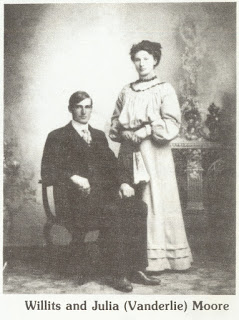
Willits was born May 18, 1882 and Julia was born February 24, 1883. Willits worked freight on the steamboat "Josephine", that made regular stops at Running Water, South Dakota. Julia worked at the "Brooks Hotel" in Running Water, South Dakota.
Needless to say Willits and Julia met at Running Water. They were married at Tyndall, South Dakota, in 1903. They went out west and returned in 1923. They homesteaded 2 miles north and 2 miles west of Running Water, they resided there until 1946, and then moved to Wisconsin for the rest of their lives.
Willits passed away in 1953 and Julia passed away in 1981. They were the parents of 10 children: James of Wisconsin, (Stillborn baby), Jessie of Montana, Arther (died in 1987), Arvilla of Springfield, South Dakota, Adeline (died in 1988), Geneva of California, Robert of Wisconsin, Dorothy of Wisconsin, Donald (died in infancy in 1923).
As I hear of a book to be written by some of our friends in Running Water, South Dakota, I reminded of things my parents spoke of as I was growing up, nothing very spectacular but none the less, they are thoughts and memories. I was one of the younger children of Jacob and Reno (Bruensma) Namminga.
After my parents passed away, we found old postcards and letters. At that time I did not feel like going through them, now as I get older, I am fascinated by the stories they tell. And as I read them I imagine the importance of some of the events in their lives. I now regret not asking them about all of this.
I've found a postcard my mother sent to my uncle Lolke, telling him they would arrive on Thursday evening or as she wrote in the Holland language "Wye Kommen on" (we are coming), the Wynias (Ulbe Wynias) will meet us at the Springfield depot.
Many times she talked of loneliness and sadness after leaving Holland and the family she left, and probably never to see again, but she often talked of friends she met here.
She could not speak English at that time at all, she worked in the Running Water Hotel, she met Pearle Miller, who became a very dear friend. She was kind and very considerate toward her, she helped her learn words in English so they could communicate. Even as Mother grew older she still talked of Pearle and another girls named Fern. Mothers duties at the hotel included helping with the cooking and baking. The American foods were somewhat different and unfamiliar to her. She also cleaned rooms and I distinctly remember her telling us, she also had to empty the "chamber pots", this was all part of her job. The hotel where she worked, later burned down.
My Dad worked for a farmer east of Running Water, he often talked of Mr. Crosby, who was good to him, and also helped him to learn about America. To us the farm is known as the Zelenka farm, the windmill is the only thing that remains there. It's located on the east end of Running Water and on the north side. My father's mother and 2 brothers, Lolke and Nammen, and a sister all lived in the Springfield and Avon area.
When my parents lived in Running Water, they lived in a small house on the east end and on the south side of the street. This is where my oldest brother, Stephen, was born.
They would often talk about the train coming in from the east and the round house, where they turned the engine around for the next days journey.
My father was born August 7, 1890 and died December 12, 1967. Mother was born August 13, 1888 and died September 6, 1971. They were married April 13, 1911. There were 7 of us children; Stephen of Illinois, Henry of Springfield, Lawrence of Springfield (deceased November 25, 1983), Florence of South Carolina, Gertrude of Springfield, Jacob of Springfield and Edith of California.
I would like to share three of my mother's postcards she received from her friends, Pearle and Fern, they are dated October, November, and December of 1911.
by Mrs. Gertrude (Namminga) Ludens
Moved to Running Water in 1948 and they lived in the Hans Johnson home, at that time it was owned by Leona's father-in-law, Henry Olson.
Leona's husband, George (Swede), and his father ran the ferry boat.
Leona (Oldfield) and George had four children when they lived in Running Water; Gary, Karolyn, Gayle, and Jennie. The three eldest attended the Running Water school.
After moving back to Rulo, Nebraska, where she resides now, she became the mother of Norman and Janelle. She has 16 grandchildren and 3 great grandchildren.
George lives in another state.
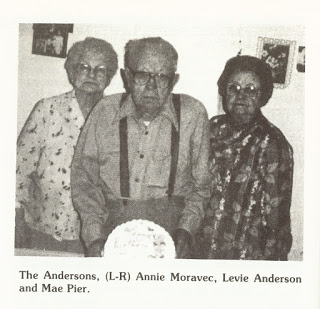
I have many fond memories of my younger years while living in Running Water, South Dakota.
I moved there in the year of 1912 with my mother, Leona Anderson, a widow, when I was four years old. My brother, Levi and a sister, Annie, joined us later. They lived some of the time with relatives.
From grades one through five I attended the one room school house between the hills, east and just around the bend from where we lived and west of the Joe Zelenka farm. One teacher in that school was Mr. Giest. He later married Elsie Zelenka. A new school house was built across from the Billman Store. My sixth grade teacher there was Blanch Buck. Pearl Nobel was my seventh and eighth grade teacher. I took my eighth grade final examinations in the Science Hall at Springfield Normal School. Someone took me to Springfield where I spent two nights at the McGoldrick's home. It was a big adventure for me.
In the spring when the ice started to thaw our teacher would take us school children down to see the ice break up and go out of the Missouri River, an interesting sight.
My classmates were Alys Eringa, Margaret Malone, Edith Durfey and John Judd. Tony and Abe DeVries were classmates for the first six years until they moved away. The Nick DeFries family lived on a farm on top of the hill just north of Running Water. Edith Durfey and Lillian Hunt were my playmates. It was fun to visit in the country homes of Alys Eringa and Margaret Malone. When the Eringas would butcher a beef or pork they would bring us fresh meat, which was a big treat.
When school was out in the spring the all school picnic was a big event to look forward to. The teacher and pupils would carry food over the hills back of the school house to a ravine. There we ate our lunch, played games and would take off our shoes and stockings and wade in the creek. The girls all wore dresses in those days. Some even had a new dress to wear to the picnic.
We had lots of fun coasting on our sleds down the steep hills in the winter time. The fame of "Fox and Geese" was played a lot in the snow in the school yard. Some other games played were pump pump pull away, tag and hopscotch. In the summer my friends and I would walk to the top of the hill back of our place and lay wild flowers on two graves of Anson young's children. The graves were marked with wooden crosses.
My Uncle John Fitch had the ferry boat for many years. He also cut ice on the river. My cousins, Lester and Sylvia Fitch and I would sit on a cake of ice and watch the cutting. In the summer the boat would ferry circus people and animals across the river. Friends and I would watch from the river bank. The circus didn't set up their tents until they reached Springfield so most of us didn't get to see the performances.
I was in the post office waiting for the mail one evening when it caught on fire. It was a sad and exciting experience for the Young family and the town people. Luckily no one was hurt.
The Walker family had four girls; Alice, Ruth and (twins) Ruby and Helen. They were tall and all about the same height and could be taken for quadruplets. They were some years older that I. It was a thrill for me when on May Day the Walker girls would bring me a beautiful May Basket filled with goodies and flowers.
Our next door neighbors to the west of us was a very dear elderly couple, Grandpa and Grandma Hunt. Grandma Hunt could make the best chocolate cake which she often shared with us.
The main events of the year for me were the Christmas programs at the Congregational Church, which I attended and at the school, also the picnic and fourth of July celebrations. The first movie I saw was "The Fat Baby", which was shown in the dance hall. When the Gypsies came into town we all stayed indoors with the doors locked.
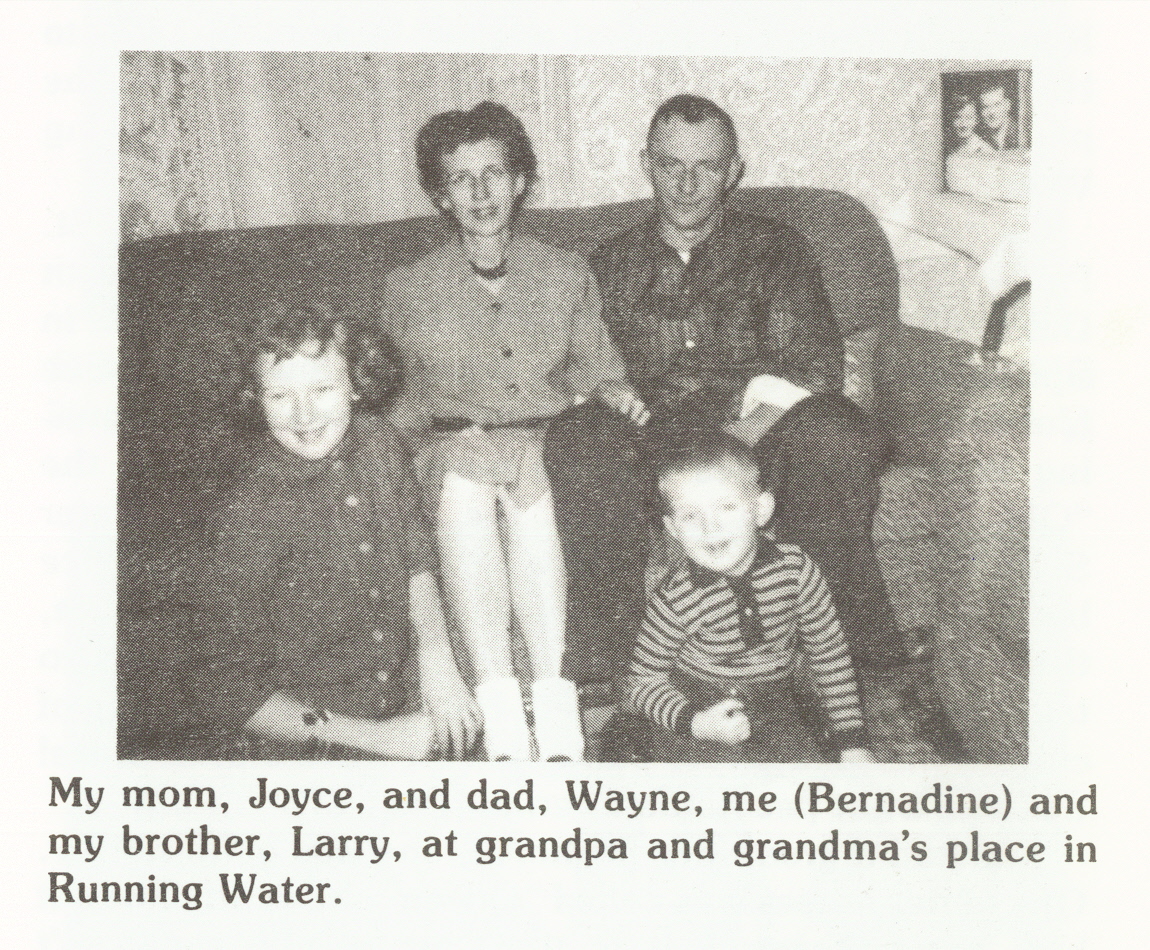
When I was born I stayed with my grandparents in Running Water. I lived with them until I was almost eight. I started school at the Donnelly School. When I went to live with my folks, we were always back to my grandparents on weekends. In the summers I always stayed there also.
The bottom road is what is clearest in my mind. It was always so pretty and interesting. You would never know what kind of wild animal would be along side of the road or in the fields. Now, that I am married and have six children, we like to take the bottom road and watch for wild animals.
On the farm there was a slope that led down to the barn and to the river. There used to be a big tree in the barn area that I would always go to, to play under while Grandpa was milking. On the days Grandpa and Grandma weren't real busy, Grandma would pack a lunch or some snacks and we would walk down to the river and fish or just watch the water flow. I can remember going to the ferry boat crossing and waiting for the ferry to come in. Quite a few times a day, I would get to ride on the ferry with the driver, Johnny Gretchman, and Grandpa. Only 4 of my children have gotten to ride on the ferry. It was really a great remembrance to me and I am certain they will never forget it either.
My cousins lived just north of our place. I had to run through an alfalfa field across the road, to get there. I ran fast as I was always afraid of snakes (or grandpa and grandma finding out I was gone). Mrs. Burns lived across the road to the east. I would stand on the slope by the road and yell at her to see if she was home or if I could go over to her place. She had a pump button organ that I liked to fool around on.
There are a lot of other things that I can remember but most of the pertain to me and my family. My boys like to fish and be near the river, so they must have gotten some of my grandpa's blood. My one daughter likes to cook, so you can tell she definitely got my grandma's blood and my mom's. There had been a 4 generation of us women to cook and work in a cafe. Grandma worked at a cafe and at the college cooking, my mom worked in Yankton at a cafe, I cooked at a cafe in Hartington, Nebraska and my daughter has been a waitress at the same cafe as me.
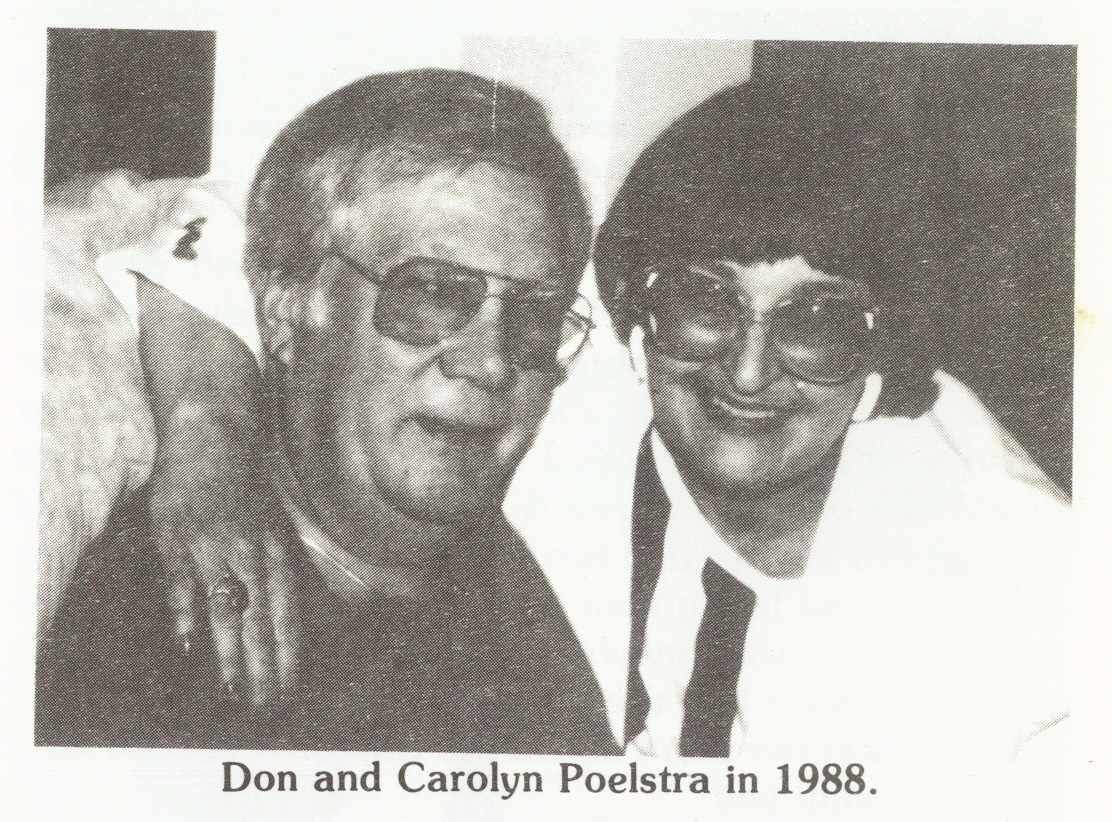
Residence in Running Water, located on Main Street upon the property of the old general store, (last known as the Billman Store). This huge two story building was one of the central gathering point when the town was bustling in the late 1800's and early 1900's.
Don's father, the late Hon. Wm. A. Poelstra, Sr., was a South Dakota State Senator and Representative and was also Mayor and a businessman of Springfield. He purchased the old store property in the mid 1940's, long after the town had vacated. His purpose was to use the fine lumber to remodel and add on to his grocery store and locker plant in Springfield. With lumber being in very short supply during the war years of the 40's, he carefully removed the material for reuse.
In 1987, Don cleared and cleaned some of the 3 lots and put on a 14' by 80' mobile home, with a 16' deck, to use as a vacation place and eventually a place to retire.
Don's brother, Wm. Jr., Father and Mother, Margaret, have all passed away, but his children live close by. Wanda Andrew in Mapleton, Iowa, Donna Krietlow, in Stickney, South Dakota, and Terry in Yankton, South Dakota.
Don, now living in Oklahoma City, married Carolyn Garrison of Oklahoma in 1984. Carolyn has two grown children, Kermit and Jill. Her mother and father also live in Luther, Oklahoma. Carolyn works for Southwestern Bell Telephone and Don is semi-retired from the insurance business.
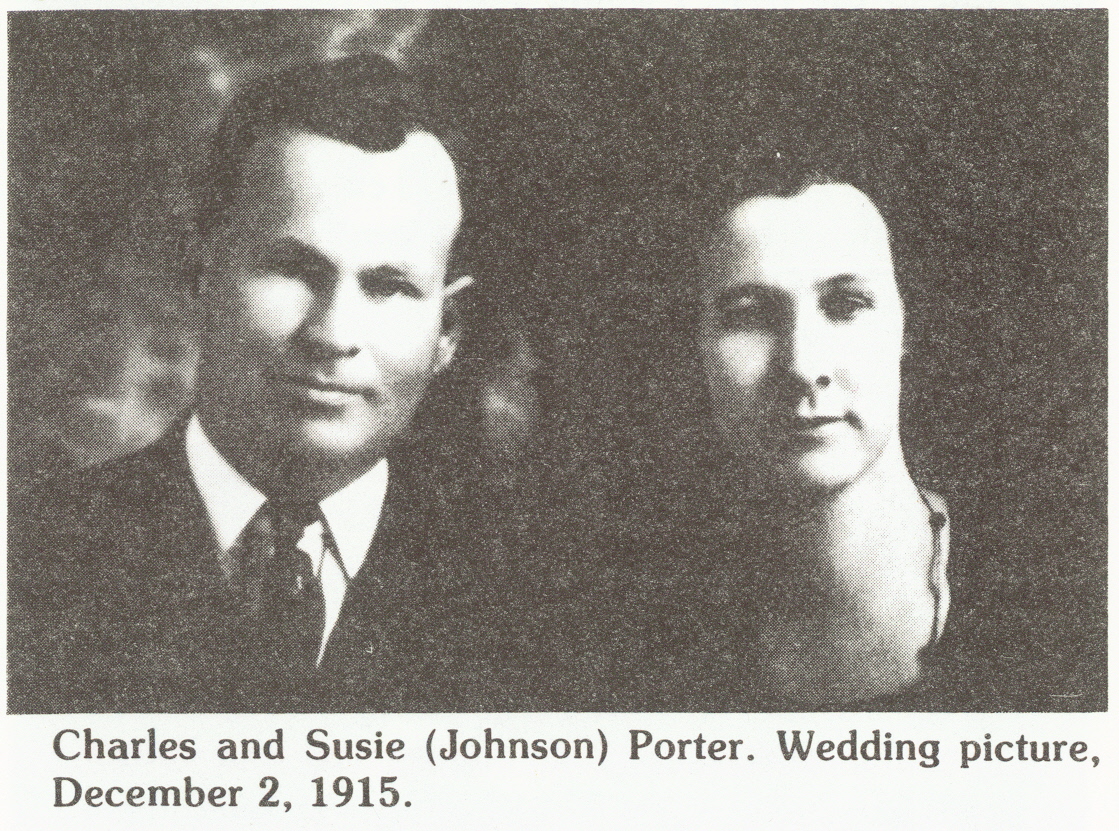
Charles and Susie were married on December 2, 1915, at Minneapolis, Minnesota, at the time of their marriage, Charles was recuperating from an accident that occurred while working, his foot was run over by a box car.
Susie is the youngest of 6 children, she was born in Running Water, South Dakota, in January of 1895 to Hans and Antonie (Petra) Johnson, they were the parents of Janet Porter, born March 1919 in Running Water.
Charles worked for the Chicago, Milwaukee, and St. Paul railroad for 47 years (South Dakota and North Dakota). Charles also ran the Texaco Filling Station in Springfield, South Dakota, during the 30's. Sue (Johnson) Porter resides in Montana, some of her Running Water memories are the many good times in the "Old Town." She attended the first Running Water burned down. The post office was so close to their house, that they watered their house, they told her parents to take out whatever they valued. Her mother took a bag of clothespins and some plants which immediately froze! Strange what people do in emergencies.
Sue had a great love for horses she was quite a rider. One of her horses was called "Queen" she dearly loved it but, her father sold it to the Cavalry - why she didn't know. Maybe got a good price.
She also tells the following about when her and Charles were courting (in the house that is still there). Charlie had worked hard and was tired and laid down on the couch and fell asleep, she sat there quietly, sewin, but she kept thinking she could hear Charlie snore and then like an echo it kind of bothered her, but she forgot to tell Charlie when he left later. The next day her mother went into the cellar (outside) and found all her canned fruit and boughten fruits had been opened or missing! In the mean time a hobo approached her father down at the railroad round house and asked him if he would like to buy some cans of fruit, Dad said "No", of course. Putting two and two together they realized it was the hobo who had gotten into the cellar that she heard snoring and it was he who ate and stole the fruit. There was a trap door into the house from the cellar and after that incident her mom nailed the trap door shut! It may be nailed shut yet!
Mr. Ray Young brought river water to their house for drinking with a horse drawn stone boat. A tin cup hung on the outside of the water pail for all to use. The ferry "Little Sue" belonged to Senior Leach, he lived in the "Big" house across the street from my sister.
One of my girlfriends, Rosy Velsck, lived in the house where the Livingstons live in now, we would sleep in the large bedroom and we had feathered quilts over and under us. I was a teenager at that time. They had Sunday evening services in the old school house and Mrs. Cotrell would play the organ. Mr. Cotrell was a passenger train engineer. They, too, lived where the Livingstons live.
She also recalls when her and Charlie bought a new Ford car and so did their neighbors, the Thorntons, one time Mrs. Thornton and Sue drove to Springfield, each driving their own car. Sue passed Mrs. Thornton and Mr. Thornton scolded her for driving over 25 miles an hour. Fun times!
Remembering other neighbors such as the Bollingers, they first lived northeast of Grandpa and Grandma Hunt's little house. It was one large room with a lean-to kitchen, this was where Edith was born. Edith and Sue were very close friends. We kept in touch through the years.
The Durfeys were another family who lived northwest of the Catholic Church in a small house. People by the name of Shacklettes lived there before the Durfeys. Mr. Shacklette was French, Mrs. was black and they adopted a white girl, her name was Josephine. Many others she remembers were the Malones, Bradberrys, Alexanders, Fitches, youngs, Zelenkas, Kramers, Crews, Leacher, Hunts, Billmans, Haskings, Gowlings, and Walkers. Her sister, Mamie, and her husband, Bert Walker lived in a nice big house across from the post office and near the dance hall. The Walkers twins Ruby and Ruth were born there. Next to Walkers house to the east, was the barber shop owned by Charlie Haskins, then next to them was a nice big home belonging to people by the name of Adkins, they were somehow related to the Bolingers. Later Frank Burns lived there, in 1902 or about then, the house was destroyed by fire. The first dance hall burned, the second hall was built much larger. It had a big stage and a lovely big piano.
Sue recalls her mother (Mrs. Hans Johnson) as being kind of like a custodian in the Catholic Church. People with money got to sit in front seats. Mrs. Johnson and her family sat in seats near the back. When the church was moved Mrs. Johnson was given some of the artifacts, Sue still has a couple statues and her daughter, Janet, was given the candle holder.
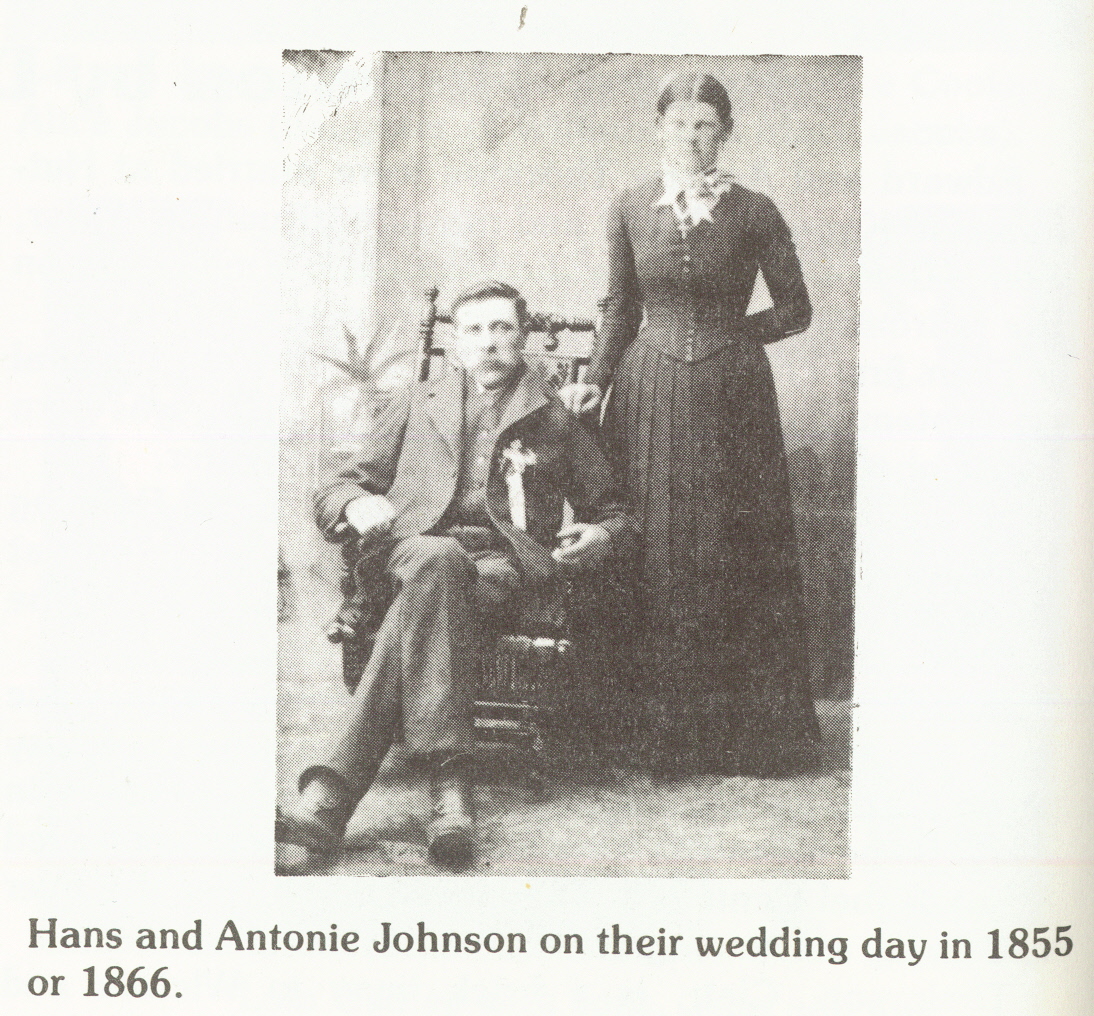
Hans Johnson (1852-1924) and Antonie Johnson (1855-1942) were the parents of Mary Katherine (Mamie) Walker. Mamie was born in Highland, Wisconsin, on December 11, 1879, and lived to be 80 years old. She passed away at Running Water, South Dakota, in 1959. Antonie and her parents originally came to America from Czechoslovakia.
Albert Morris Walker was born March 24, 1864, and died November 22, 1924. Albert was the son of Elija Walker and Eliza Flowers. Elija worked for the railroad and at the hotel in Onawa, Iowa. Elija's father was sheriff of Onawa, Iowa.
Albert and Mary Katherine, after being married made claim to land in Brule County. They then moved to Running Water where Albert cooked on the steamboats and was a proprietor of the hotel. They had four daughters: Alice who married Martin Goodwin (deceased), lives in Saugus, California, Ruth and Ruby - twins (deceased) and Helen (deceased), who married Tom Breen. Alice is their only living daughter.
Helen Walker was born January 3, 1906. She passed away January 21, 1967. She worked as a cook at Yankton State Hospital. Helen had a son, David, who was born September 8, 1937, at Running Water, South Dakota. David went to grade school at Running Water and high school at Springfield. He served 4 years in USAF. On August 10, 1959, David married Elizabeth Schramm from utica, South Dakota. David went to college at SSTC at Springfield, where he received his 4 year degree in Industrial Arts. David also received a Masters Degree in Industrial Arts from Colorado State University. He taught Industrial Arts from Colorado State University. He taught Industrial Arts at Parkston High School from August 1966 to May 1980. ni 1980 he obtained a Masters Degree in Counseling from SDSU, Brookings, and at present, counsels K-12th grade at Parkston Public School.
Elizabeth was born at Yankton, South Dakota to Arthur and Mary Schramm. Elizabeth received a 4 year Elementary Education Degree from SSTC. She taught at Highland and Armstrong Rural School District, of Springfield, South Dakota. She has taught elementary grades 2-6 at Parkston Public Schools and received a Masters Degree in Elementary Administration from SDSU, at present she teaches junior high math at Parkston Public School.
David and Elizabeth Walker were blessed with three daughters.
The oldest, Kelly, born April 28, 1960, went to Parkston Public, grade and high school. She received an Elementary Education Degree from Dakota State College, Madison, South Dakota. She married John Seitz from Madison, South Dakota, on August 7, 1982. They live in Sioux Falls, South Dakota, where John is a finance officer for Billions Company and Kelly teaches 5th grade at St. Lamberts School. They have a daughter, Jennifer Ann, born May 19, 1985.
Their second daughter, Kim, was born September 23, 1964. She attended Parkston Public, grade and high school. She then went to USD/Springfield, working towards a 2 year Art Degree. She married Eugene Cap from Tyndall, South Dakota, on June 18, 1984. Eugene joined the USAF. He was assigned to Hahn AFB, Germany, so at present they are living at Moritzheim, West Germany.
Their third daughter, Jodie, was born August 25, 1966. She also attended Parkston Public, grade and high school. She attended SDSU at Brookings, where she received a 4 year Business Degree in 1988. At present she is attending USD at Vermillion, working on a Masters Degree in Business Administration.
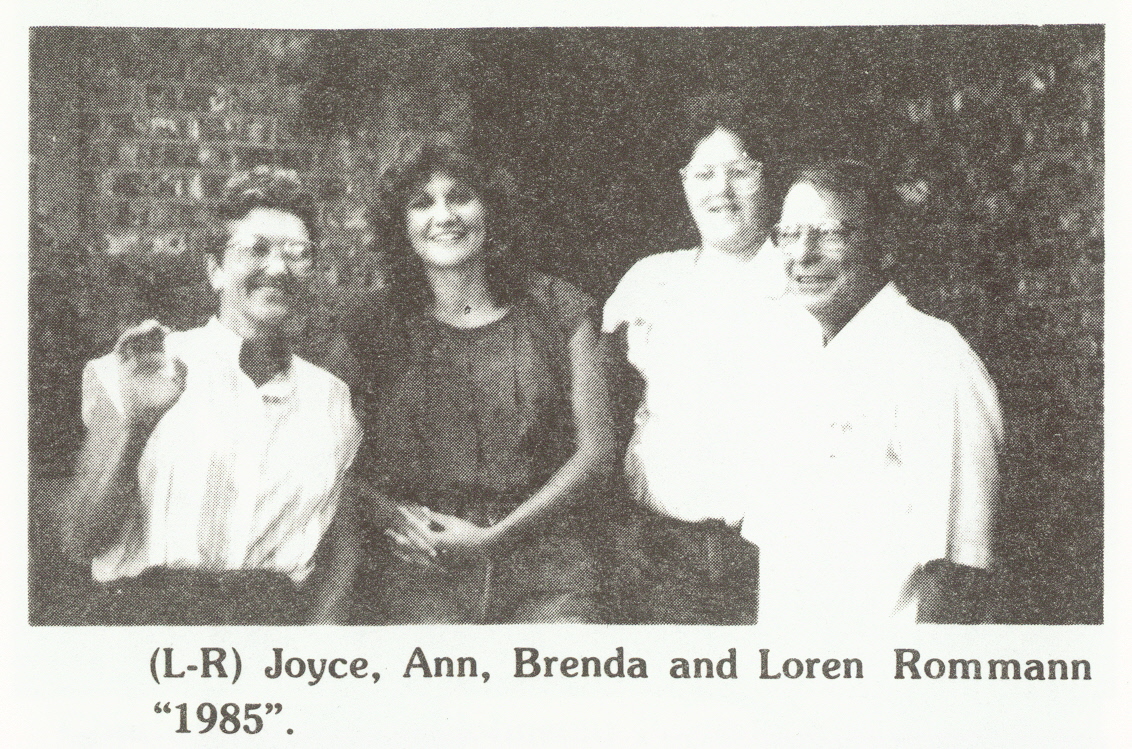
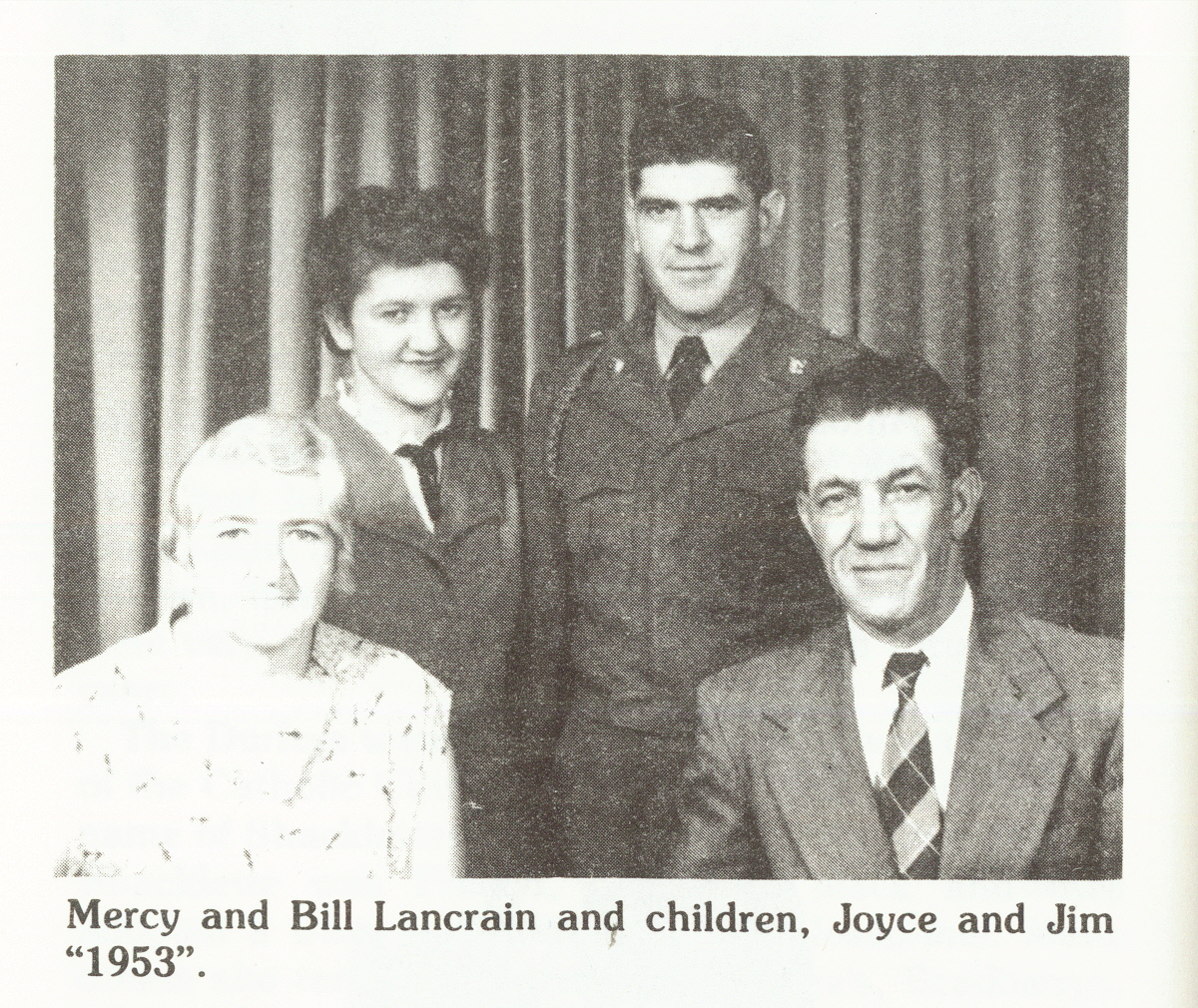
I was born in May of 1937, on the Crane homestead northeast of Running Water. My parents are William and Mercy (Crane) Lancrain.
My family moved to the bottom, east of Running Water in 1942. I went to Running Water School all 8 years, high school in Springfield, and 2 years at SSTC.
My parents moved to Armour, South Dakota, in 1955. I have one brother, Jim, he and his wife, Ann, live in Pierre, South Dakota. My husband, Loren Rommann, and I have 2 daughters, Ann and Brenda. We haved lived in Yankton, Custer, and Brookings, South Dakota and we now reside in Stillwater, Oklahoma.
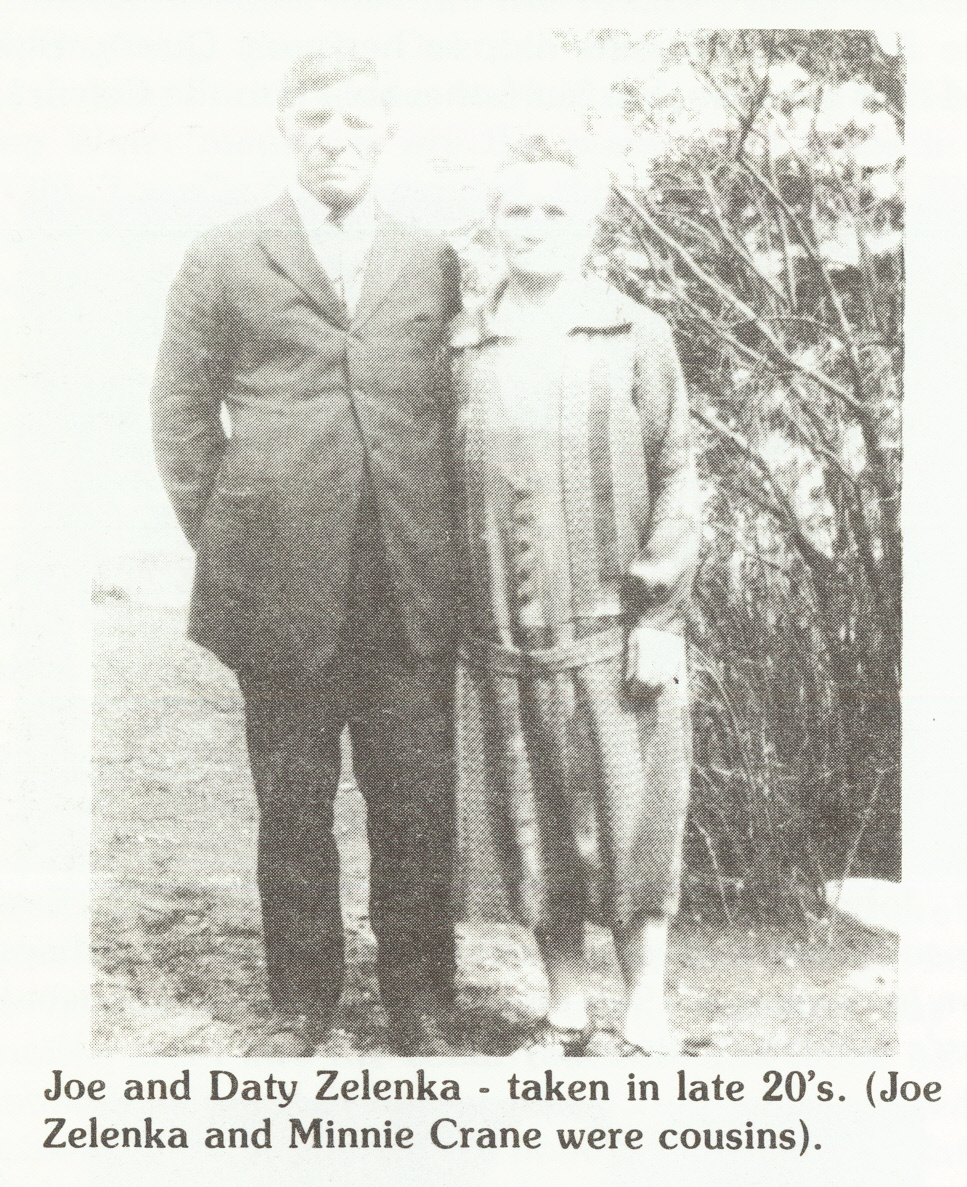
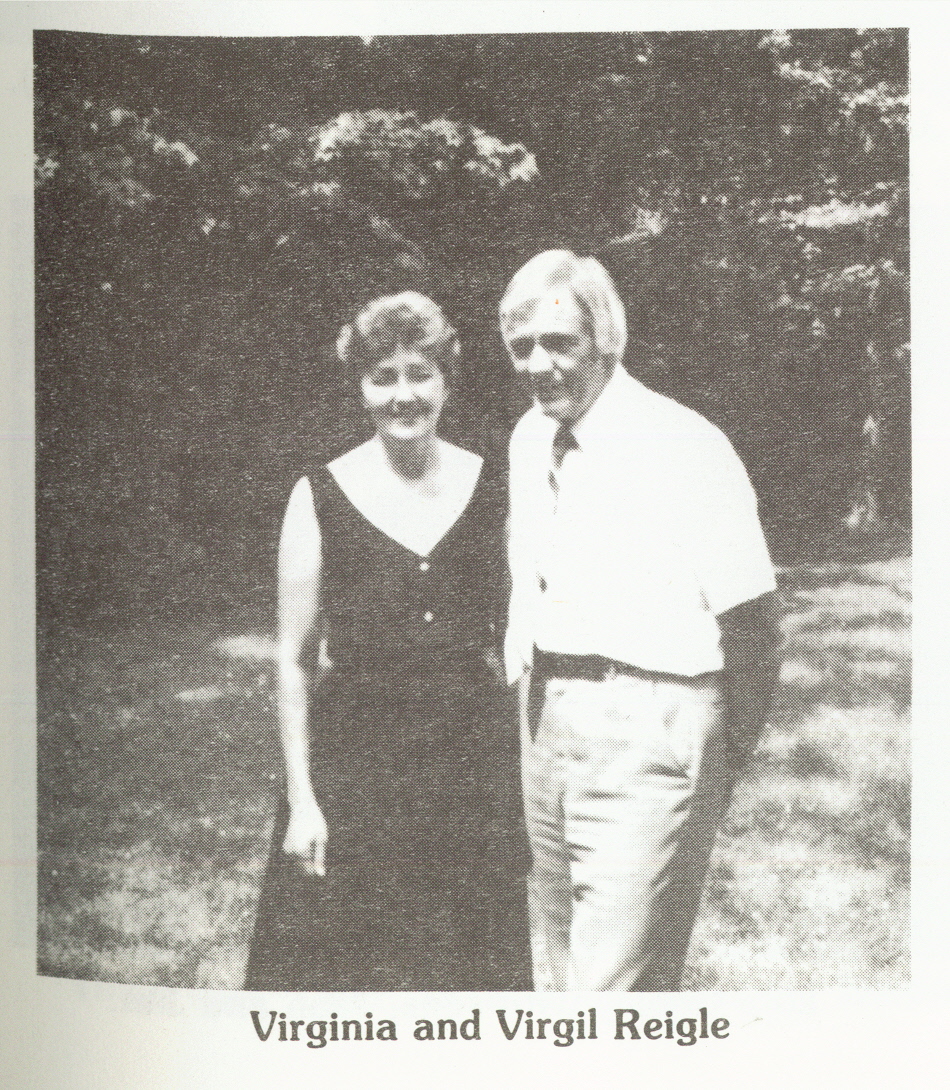
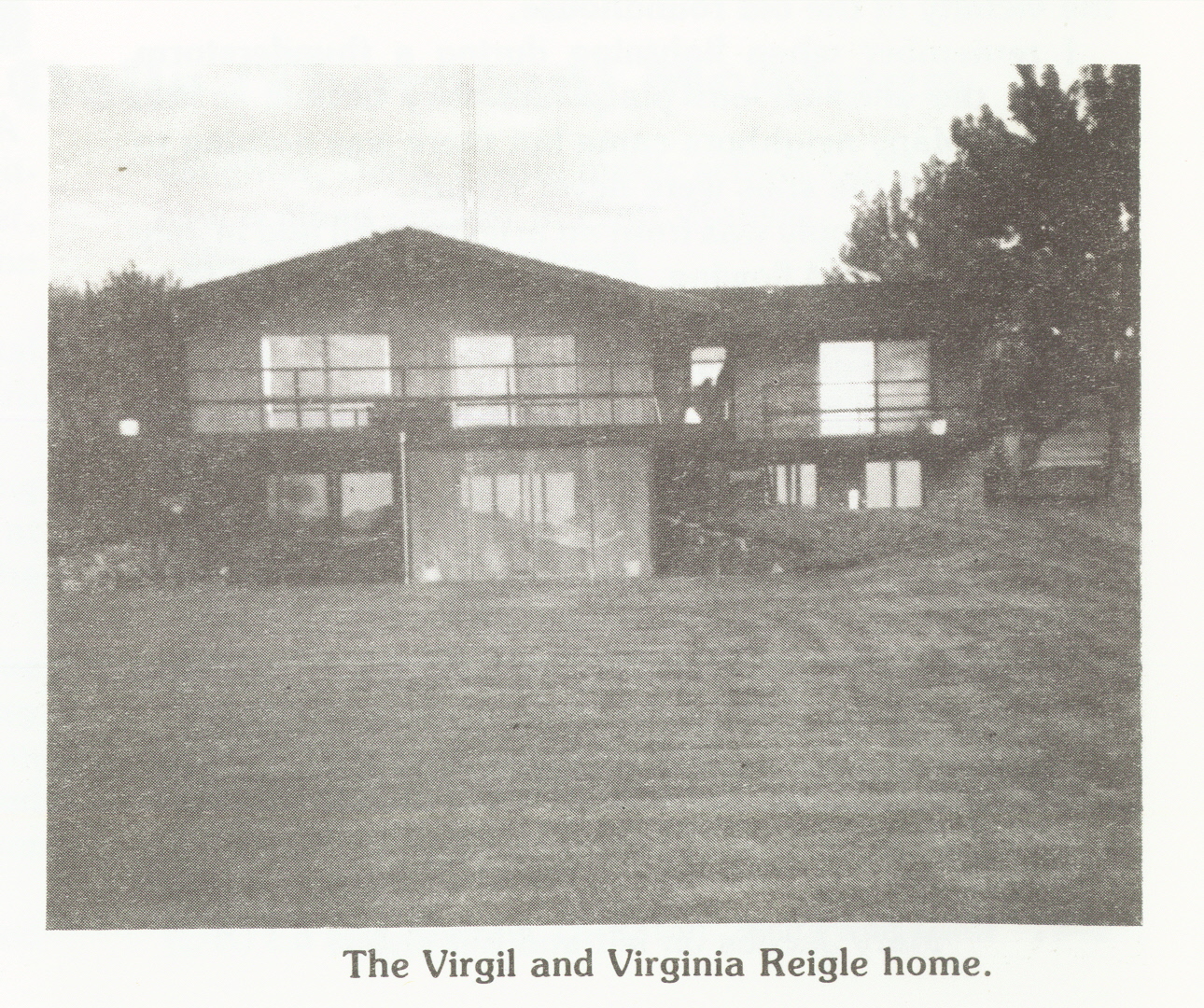
Our family had boated on the Missouri for years, and putting the boat into the water at the Niobrara landing always included a little run past Running Water, before heading upstream. One late summer afternoon in 1975, we drifted past Running Water as always and noticed a new cabin with shakes as siding, It's natural finish lending itself to the environment very nicely. We commented on how nice it looked and Virgil suggested we pull into the bank, walk up and tell the owner how we felt. We did just that and met the Dale Garris family for the first time. Later that fall, we drove across the dam at Gavins Point, and drove to Springfield, heading for Running Water. We took Highway 37 (not even being aware of the river road), and I can remember how confused we were, as we seemed to be heading away from the river. Well, we made it to Running Water and drove through the street, looking and thinking about how nice it would be to face the river, without facing the cold north winds, as we did on the Nebraska side. We saw Helder Tompson sitting on his porch and we stopped to visit. We asked if there was river front property available and he told us a retired naval officer, George Lee Banker, was the most prospective seller, and he was in California. Helder gave us Lee's address and that began the transaction of our purchase of Lee's trailer and lots, and also was the beginning of a friendship that has grown for three years. We purchased the property early in 1976, by telephone arrangement and we immediately drove up to the Springfield Bank to give Don Dwight a check for the property and guarantee our spot on the river. I think our anxiety to the close the deal was puzzling to Don Dwight, as he explained his access to his father's cabin, that had no appeal for him. The summer of 1976, we began to come up for weekends. We pulled the trailer over to the corner of the lot and Virgil dug a walk-in basement for our house. As we worked and played every weekend, we met our neighbors, Carl and Grace Einrem and their family, Otis and Ada Cogdill, Paul Henricksons and their family and all the weekenders like ourselves. As much as we love the river and the area, the people we've met and made our friends are as big a bonus as the spot. Maybe living and loving the river makes people more individualistic, but people like Carl Einrem, his fishing and his hands tied nets (one of which we are proud to own), Grace and her gardening and generosity, and the warmth of their family gatherings every weekend that they gladly shared with anyone dropping by are very special memories. "The Weekenders" became our good friends, Dale Garris' family, Clyde and Jeanne Watts, Tom Smith followed by Jim and Darlene Egli, followed by Harlan Ferwerda's family. On Monday mornings, Virgil would boat across to his pick-up and I closed the house, and took the car by ferry to the Nebraska side. Those are good memories, until the ferry was sold in 1984. In 1986 we made plans to retire here permanently and we began an addition to our home. That was completed in the fall, and by Christmas we had moved our household from Brunswick. We got our South Dakota drivers licenses, registered to vote and became officially, what we had been at heart for several years, South Dakota people. From the first summer, we attended the Emmanuel Reformed Church in Springfield. We've made strong ties there and appreciate all the people of the Springfield, Running Water area. We're glad you adopted us, we feel there just couldn't be a lovelier or a nicer place to live.
We purchased a house in October of 1985 from Mick May. We used it as a weekend hideaway until June of '88 when we moved down permanently. Jack had been looking for a place on the Missouri River. He learned of the house for sale from George Hopp's sons in Sioux Falls. We love the beauty of the area, the wildlife, etc. AFter extensive cleaning up and some remodeling it is a comfortable and peaceful place to retire to.
Our family consists of four sons, Steven and Ray in Chicago, Kelly in Brookings and Jim in Sioux Falls. One daughter, Mary, in St. Paul, Minnesota. They all enjoy visiting to hunt, fish, boat and just relax.
My parents, William and Mary Jacobs, moved to the Running Water area in 1921. They lived first on the bottom road at the place now owned by the Balfany family, and also the place where I was born in 1921. They lived there until the following spring, at which time we moved about a mile west to the place where they lived for 44 years. This place in earlier years was known as the Seaman Ranch. Prior to our moving there, my aunt and uncle, Maurice and Lola Cooley had lived there.
I went to grade school in Running Water. At that time, there was a school house, two churches, a general store, a post office and a dance hall in this small town. There was a roundhouse located below the town because at that time the train traveled from Running Water to Marion, South Dakota, up and back in the same day. The tracks ran through our property so the train was something we saw every day. Not too many years later, the train was discontinued between Running Water and Springfield and the tracks were removed. I can remember having end-of-the-year school picnics there in the vicinity of the old roundhouse.
I remember when the lightning during a thunderstorm struck the silos on our place and they burned to the ground. Many neighbors came but there was nothing to be done and the silos were never rebuilt.
Our water supply was from an artesian well and in July of 1936 it stopped flowing. A well digger was called from Yankton, and in digging down for old pipe they found small sections of broken pipe twisted and bent, some of them looking like corkscrews They never located 200 feet of the pipe. It was never known what happened but it seemed there must have been some subsurface disturbance or earth movement of some kind to have caused it.
My mother passed away in July of 1961. My father continued to live there alone until his death from a heart attack in February of 1966. In November of that same year the land was sold to the Ray Talsma family.
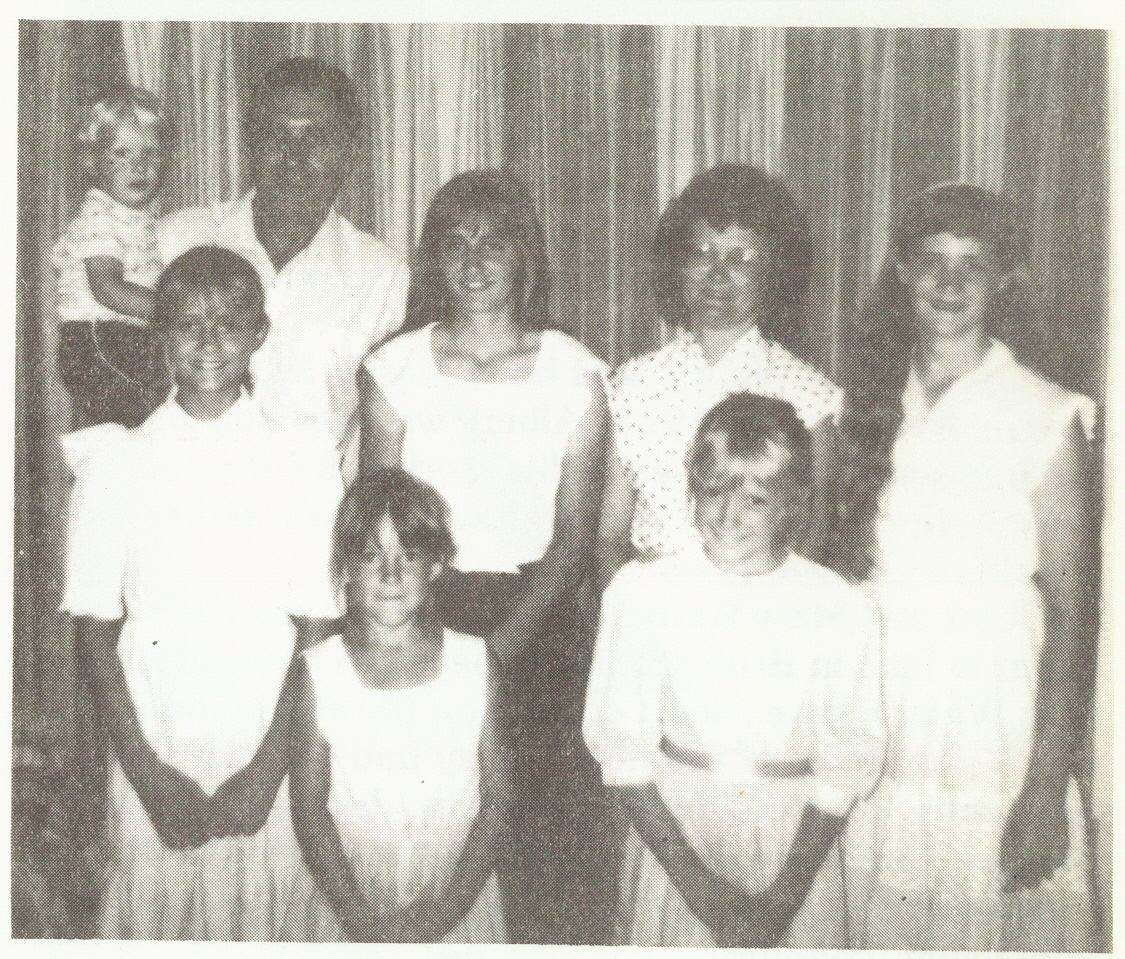
We moved on the William (Slim) Jacobs ranch in the fall of 1968. The ranch was purchased from Maurice and Mary Alice Swollom, in 1967.
Besides farming, John works as a correctional officer at Springfield Correctional Facility. We have 6 children: Sara, Lisa, Lora, Julia, Rebecca, and Jonathan.
from South Sioux City, Nebraska
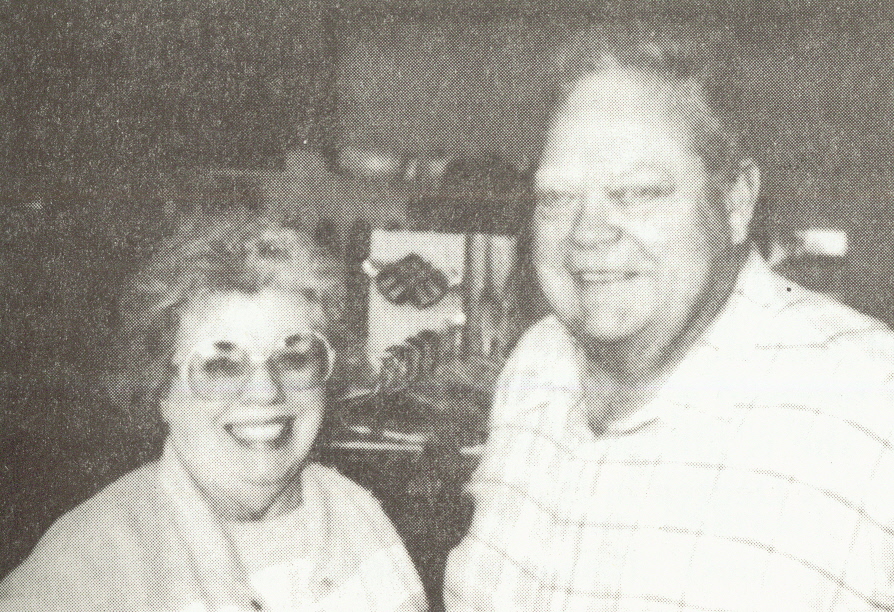
We bought our house at Running Water 6 years ago from Otis and Ada Cogdill of Running Water. We came to Running Water just by chance. We were looking for some place to hunt and fish and a get away from the everyday hectic life. We really enjoy it when we are there. It's a really nice place to be and wonderful people.
We are the parents of 4 children: Cynthia, Stephanie, Christine, and Brett. We have 9 grandchildren.
Edward and Audrew Thornton were married at Hutchinson, Kansas in 1920 and moved to Running Water, South Dakota, soon after. Ed worked as a mail clerk on the railroad and Audrew played piano at the church.
Their first child, Clair, was born at Yankton hospital on September 11, 1923, and daughter, Della, was born September 2, 1926, at home in Running Water.
My aunt, Hattie Thornton, taught school in Running Water about 1923-1925. She was teaching at Bridgewater, Iowa where she died in 1928 at age 23. She is buried in Iowa.
In 1927 my family moved back to Isabel, Kansas due to poor health of parents. Ed farmed and when not busy on the farm he was laying brick. He died of cancer in 1927 at age 62 and Audrew died in 1979. Both are buried in the Isabel Cemetery. They loved being near the river and living at Running Water.
Their son, Clair, is a brick layer in Wichita and daughter, Della, taught public school for 35 years and is now a piano teacher in Pratt, Kansas.
by Della (Thornton) McAhren
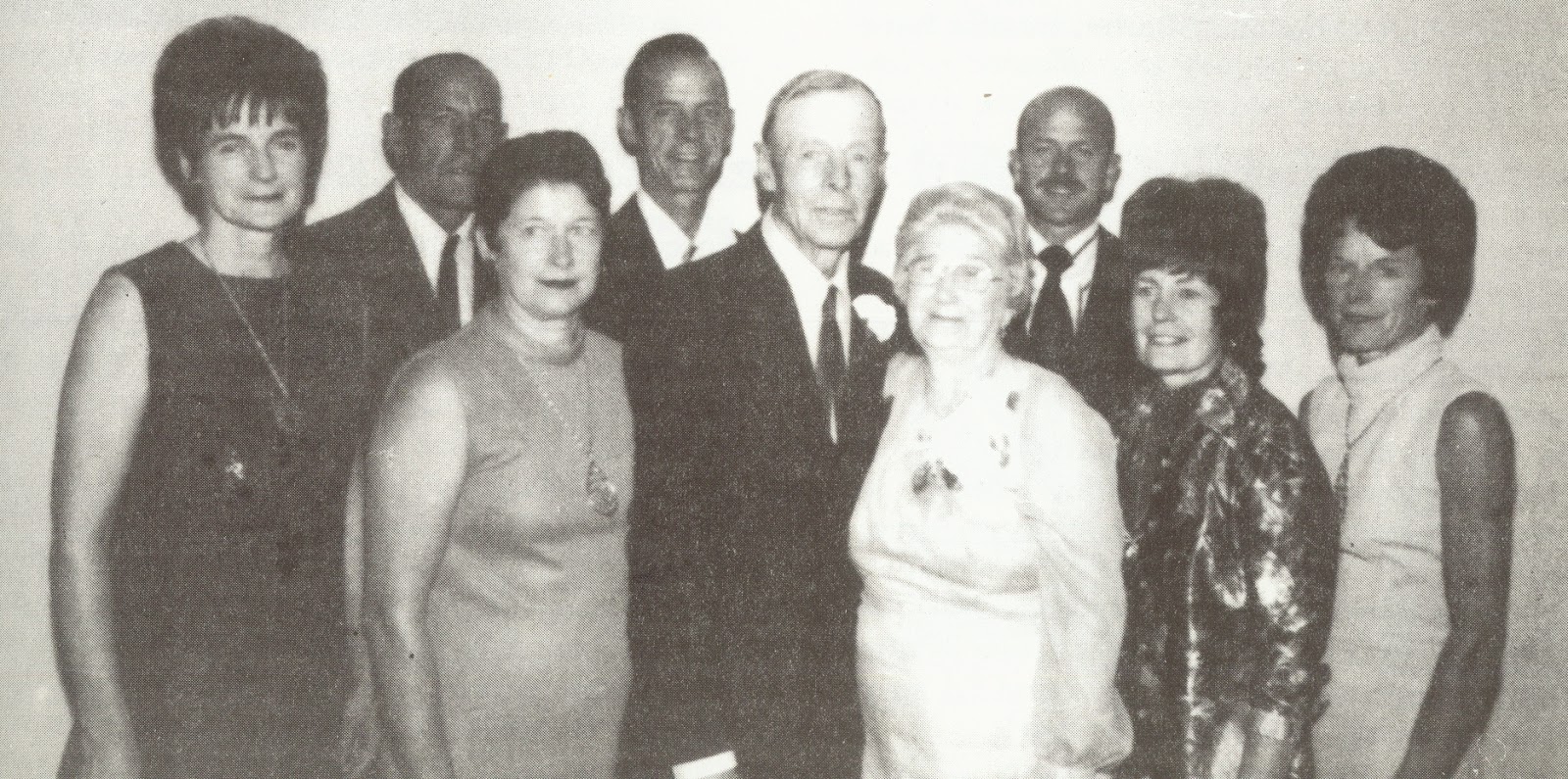
George & Maurine's 50th wedding anniversary ~ 1974
L-R: Helen, Mervin, Jana, Allan, George, Maurine, Don, Charlotte, Jean
George and Maurine Warrington moved to the Running Water community in 1934. George's father and mother once lived on this same farm 1 1/2 miles north of Running Water. George passed away in 1981 and his wife, Maurine, lives in Springfield.
This was a small town, with the school, post office, grocery store, two churches, dance hall and the ferry boat that crossed the Missouri River linking South Dakota and Nebraska tourists and business to and fro.
Our family of seven children all attended school and grew up in this community. There were four girls and three boys: Jana (Jelsma), Springfield; Charlotte (Welfl), Grand Island, Nebraska; Helen (Welfl), Omaha, Nebraska; Mervin, Springfield; Jean (Marker), Sauk Centre, Minnistoa; Allan (deceased); Don, Omaha, Nebraska.
Our close neighbors were the Pierre Eringa, Lawrence Malone and Peter Dykstra families. The town had about 13 or 14 families at the time we lived there in the neighborhood: Zelenkas, Williams, Fitchs, Hunts, Durfeys, DeRoos, Jacobs, Johnson, Craines, LaCrains, Schullers, Billmans, and (Bollingers and Malones) thru the summer months.
All our children have good memories of this little town and community.
Gerald Wynia married Tammy Johnke on April 3, 1987 and moved above Running Water at that time. Gerald was born on that place 28 years earlier and had lived around this area all his life. Gerald is the grandson of Carl and Grace Einrem, who lived in Running Water for quite some time. Gerald and Tammy have two children, Travis Carl, who is 7 years old and Tiffany Lillian, who is 4 months old.
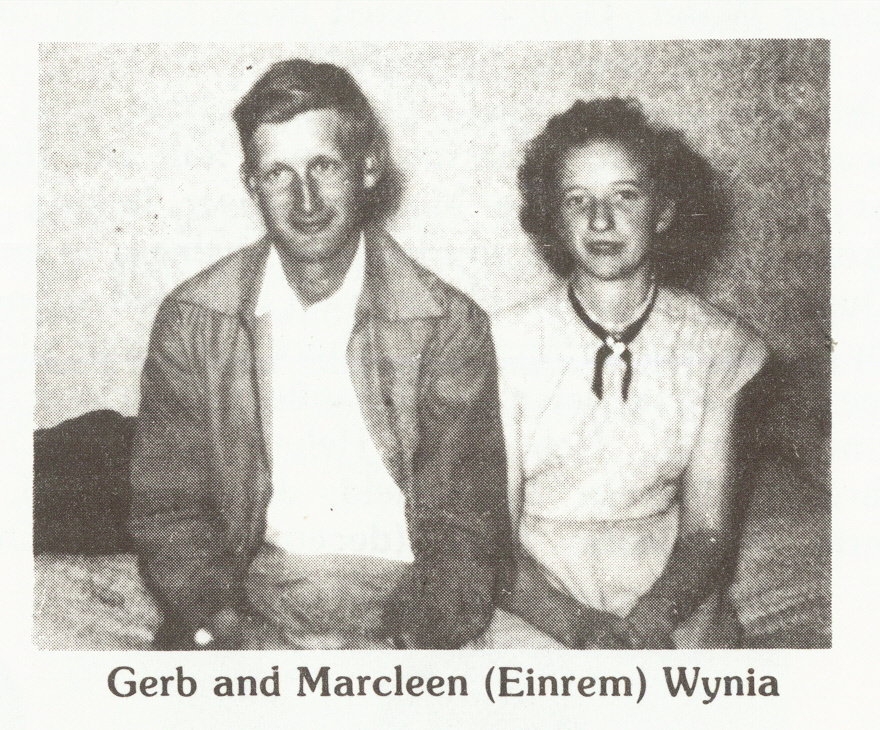
We moved to Running Water on March of 1974, my folks, Carl and Grace (Dykstra) Einrem, bought the McPeek place. My brother, Charlie, and my sister, Mary Lou, and I went to the Running Water School, my oldest sister, Joyce, was going to Springfield, I was in the 7th grade when we moved there. Betty Wynia was our teacher, the next year was Harold "Bud" Kibble. After graduating from 8th grade, I worked for my cousin, Walt and Lil Einrem, while Lil taught school.
I married Gerben Wynia in 1952. We purchased the farm at the top of the Running Water hill in 1952, we lived there for a few years then in the surrounding area. We have eight children: Gary (deceased), Denny, Kenny, Russ, Donna, Gerald, Debbie, and Sharon, we also have nine grandchildren.
by: Marcleen (Einrem) Wynia
Charles and Janet were married January 10, 1943, at Springfield, South Dakota. Janet is the daughter of Charles and Sue (Johnson) Porter. She was born in Running Water, South Dakota, March 9, 1919.
Charles and Janet are the parents of :
Charles R. Young, Jr., was born January 1, 1944, at Lakeland, Florida (Drew AF Base). Now resides in Missoula, Montana, with wife, Beth, and children, Laurie and Chris.
Susan K. (Young) Remar was born March 6, 1948, at Ellsworth AFB, Rapid City, South Dakota. Now resides in Omaha, Nebraska, with her "Men"; husband Ed, sons Jason (in AF England), Matthew and Chuck.
Charles and Janet both went to Southern (at Springfield) for 2 years and then Charles went into the Air Force and Janet into Nursing. They had 21 years in the Air Force and retired to Montana, where he worked in the Postal Service in Col. Falls until his death.
Janet's early memories of Running Water are school days, family and friends. She attended school through 3rd grade here, then her dad's job took them elsewhere. While in Running Water she and a cousin, Casey Johnson, were the town's "Holly Terrors", anyhow, they were always in hot water for something or other, the only trouble was she got punished; spanking, no supper and etc. (Casey never got punished.) When their folks would make them stay at home they would climb the big trees in each of the yards, (they lived across the street from each other) and then pretend they were sea captains of pirates and sail away.
Mrs. Tom Bray was their neighbor and what a cook! She would always set a beautiful table, she remembers she even had dishes for bones. She was wonderful! And always had doughnuts or cookies for us little neighbors, even though we had town shingles off of her chicken coop so we could watch them fly in the wind, needless to say Jan's dad had to do a repair job.
Jan also remembers the dance hall and how important she felt when she got to wind up the Victrola and select records for their dances.
When her grandpa, Hans Johnson, died (not very old) there was such a blizzard and so cold that only men went. They drove teams across country to the cemetery outside of Springfield, no roads usable, and drifts covered all the fences, etc. Can you imagine riding in open wagon in weather like that!!
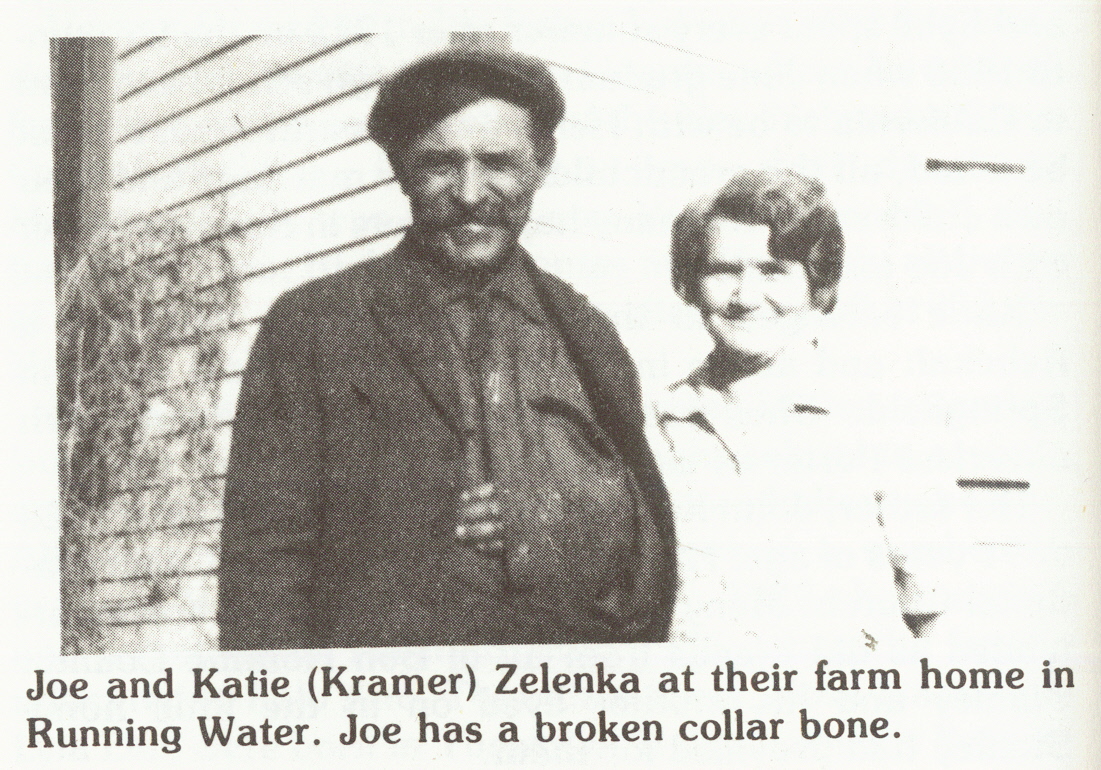
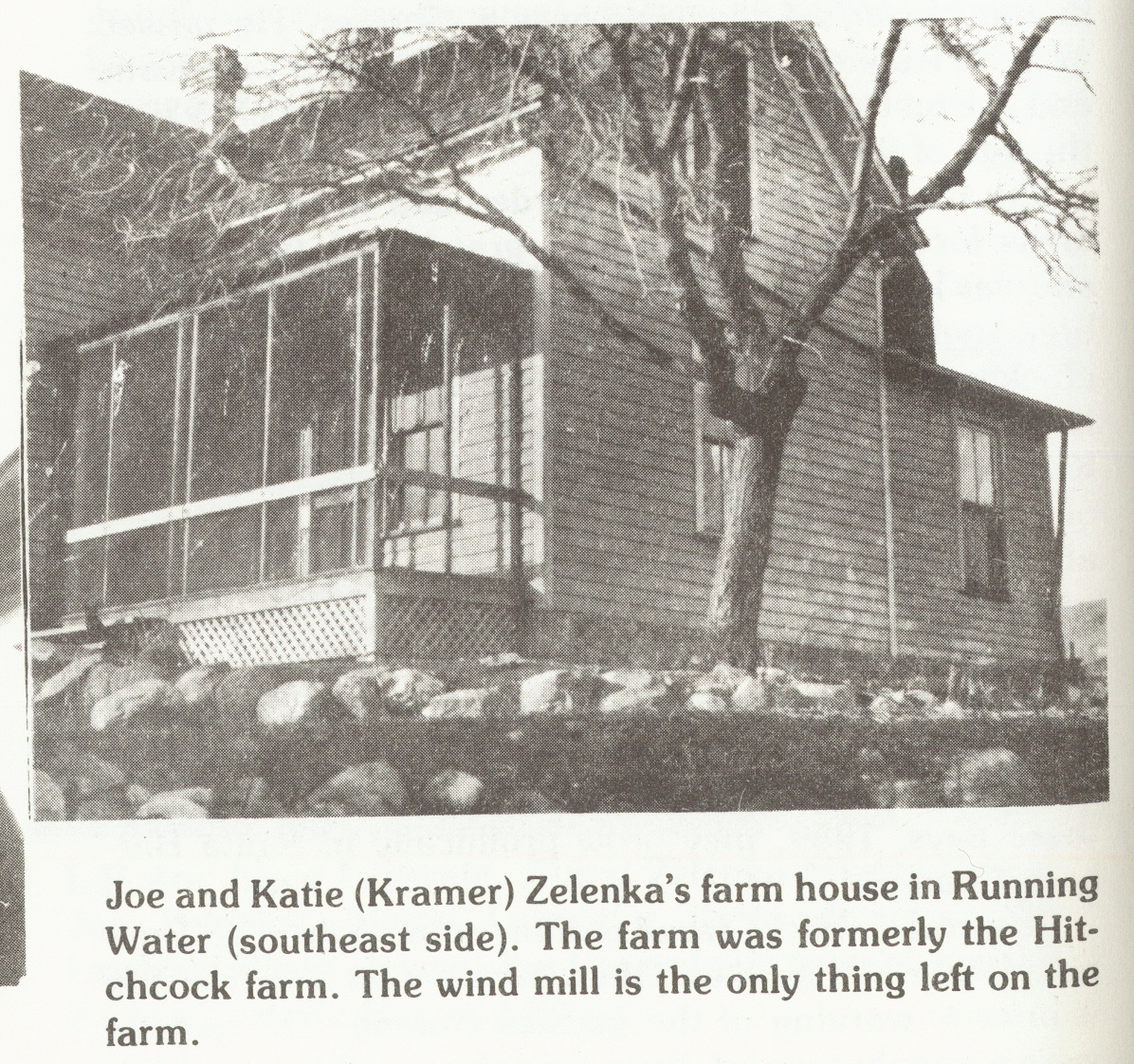
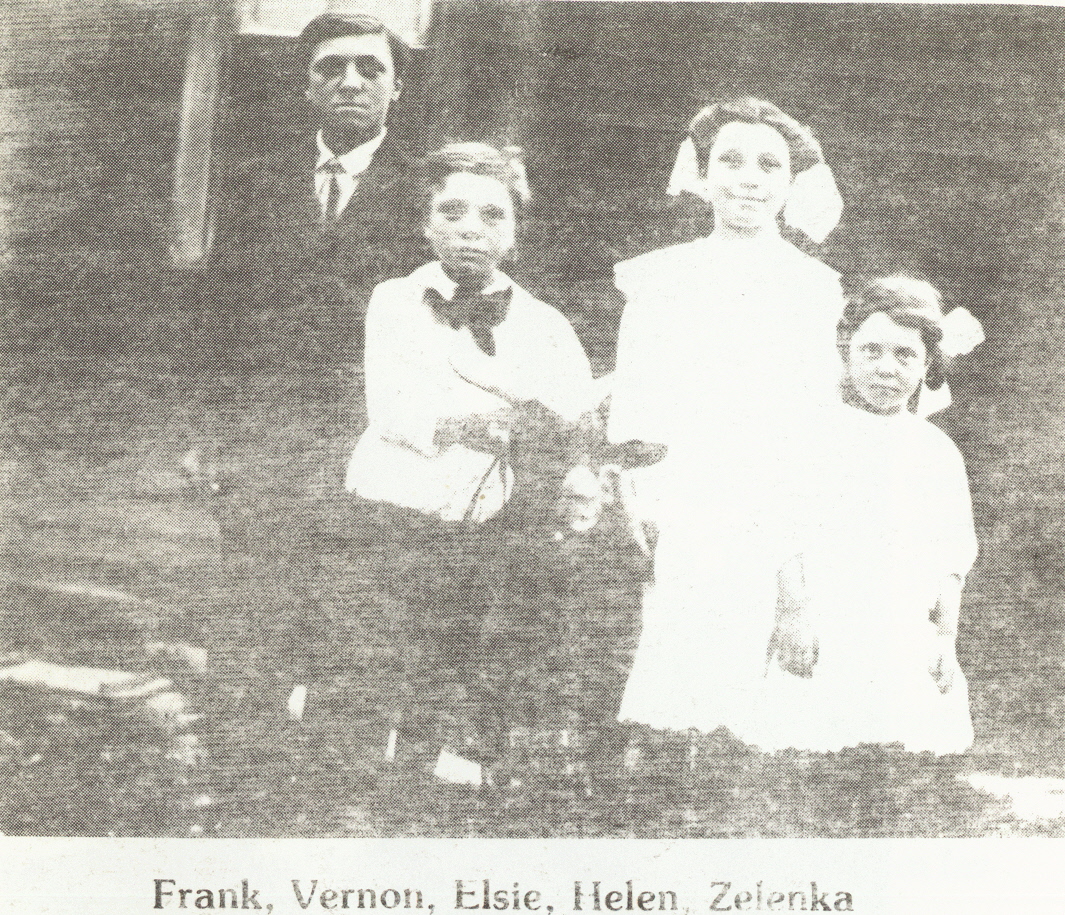
Joe and Katie Zelenka and their family moved to Running Water in 1914, and lived there the rest of their lives.
Joe was born on the Zelenka homestead in Table Rock, Nebraska, November 13, 1871. He was the second of nine children born to Frank and Mary Zelenka. He attended the county school in the area.
Katie (Kramar) Zelenka was born in Bohemia (Czechoslovakia now) November 20, 1873, the daughter of John and Catherine (Krasny) Kramar. She attended school in her native land and came with her parents and brothers to this country at the age of 13, in February of 1887. They settled in Nebraska, between Table Rock and Humboldt, on a farm. She worked as a domestic servant in St. Joseph, Missouri, for a time and learned the English language.
Joe and Katie married November 6, 1893, at Pawnee City, Nebraska. They made their home near Table Rock until 1898 when they moved to South Dakota. Their two older children, Frank, born August 31, 1895 and Elsie Lillian, born February 23, 1898, were born in Nebraska.
The family was accompanied to South Dakota by Katie's parents and her brothers, Frank and Stanley. John had married Anna Ninger in Humboldt, Nebraska, and they also came to South Dakota. Kramars lived on a farm near Perkins. In 1918, they moved to Running Water to the home purchased by their son, Stanley. Here all three: John, Catherine and son Stanley, lived out their lives on the banks of the Missouri.
In South Dakota, Joe and Katie became the parents of Vernon Stanley, born July 29, 1902 and Helen Marie, born August 29, 1905.
From their first home in Bon Homme County, the family moved to what was known as "The Daub Place", a farm about six miles south of Tyndall. Their next home was "The Snow Place", a farm in the hills northeast of Running Water, northeast of the Crane farm. From there they moved to a farm across the road from the school I've known as "The Crane School."
In 1914, Joe and Katie and family moved to Running Water where they had purchased the Hitchcock farm. They farmed here until 1939, when they retired and moved to the little Kramar place across the bottom road south of the farm.
Katie's brother, John, and family lived on a farm northeast of Springfield on Highway 50, near Tabor. Frank and his wife, the former Jessie Backwell, lived east of Springfield on a farm where they raised their family.
Stanley taught a Czech school for a time, (he had graduated high school in Humboldt, Nebraska, at age 15, with honors). He was a brilliant young man. He was handicapped from birth by a crippled left arm. There was no joint in his left elbow, however, it did not deter him. He became well known in Bon Homme County and held elective office in the county a number of years.
Joe and Katie were active in the Running Water community all the years they lived there. If anyone needed help, they were always there with a helping hand.
Joe and his son, Frank, helped build the Congregational Church, which in fairly recent years has been sold, and eventually was moved from the area. (This little church was dearly loved by many of us!)
Katie belonged to Ladies Air and all church activities. I recall the ice cream socials, especially. Katie's vanilla ice cream and her burned sugar cake were popular. I also recall Ella Fitch's chocolate ice cream.
The Running Water School, grades 1 through 8 sat in my grandpa's pasture. The land for the school had been given to the community by the Hitchcocks from whom Zelenkas bought the farm. During the school year 1916-17, the teacher was a young man (just out of high school and with 6 weeks summer school at the Normal), Alex Geist, of Tyndall. The Geist family had come from Russia and settled first in George, Iowa. They moved to Tyndall when the Reicherts moved (Rev. Reichert was the minister of the German Baptist Church). Alex's family was related to the Reicherts.
One of Alex's students was Helen Zelenka (8th grade). Through her, Alex met her sister, Elsie, who was a student at Southern Normal School in Springfield. Alex and Elsie were married in a ceremony at the Zelenka farm home with Rev. A. C. Warner officiating, September 29, 1917.
Frank had farmed with his father, Joe, and had worked on at the ranch as they needed extra help. When the United States entered World War I, Frank enlisted in the Army and served overseas in France. He was gassed during action. After his return and as he became older, he was in poor health as a result of his military service during the war.
He left Running Water and went to Lincoln, Nebraska, where he worked for some time. Here he met Grace Bacon, a registered nurse, who was to become his wife. He moved to California to Petaluma, and later to Los Angeles, where he and Grace were married about 1927. They lived in the Los Angeles area the rest of their lives. Frank passed away at the Long Beach VA Hospital, January 1965, at the age of seventy.
Elsie and Alex worked in Lake Andes at the Court House for time. Alex enlisted in the Army along with several other Bon Homme county young men and was stationed at Camp Fremont, California, near Menlo Park. During that time, Elsie lived in Running Water with her parents. Their first daughter, June Maxine was born August 26, 1918, on the farm while Alex was in the army. June was 6 months old when Alex returned.
Elsie and Alex lived in Tyndall after the war. Alex worked in the Court House. Their daughter, Sybil Elaine, was born in Tyndall, August 25, 1920. soon after, they moved to the Cooley Ranch in Running Water, where they lived about a year. The ranch was later known as the Jacobs Ranch. About 1922, the family moved to Lincoln, where Alex worked for the Lincoln Tel Company, until he retired in 1962. Their other four children were born in Nebraska: Joseph Conrad, Kathryn Marie, James Eugene and jack Herbert. Elsie lives in Arkansas, she is 91 and lives alone. Alex died in 1969.
Vernon farmed with his father but soon after his marriage he and his wife moved to Lincoln, where he worked for a time on the construction of the New Nebraska State Capital Building. During this time, their daughter, Margaret Faye, was born. Later Vernon remarried and had three sons: Richard, Thomas and Kenneth, all living at present in California. Vernon died May 17, 1972 in Hanford, California.
Helen, after grade school in Running Water, attended Southern Normal School. She taught school in several communities in South Dakota and at an Indian school in Albuquerque, New Mexico. She worked a number of years in Yosemite National Park. In 1929 she married and remained in Yosemite until 1936, when the family relocated to Palo Alto. Their daughters, Rose Marie and Lyla Lee, were born in Yosemite. Helen presently lives in Loguna Beach, California and her daughters and her grandchildren are frequent visitors. Rose Marie lives in Lewiston, New York, and she and her husband plan to retire to Oregon next year. Lyla lives in Virginia, near her children in Norfolk.
Katie was an accomplished seamstress, and an excellent cook. Sunday dinners at the Zelenka's were a "delicious" occasion. There were invited guests, and often those who dropped by. All were equally welcome. Joe's cousin, Minnie Crane and family, who lived northeast of Running Water and north of the Jacob's ranch, were frequent visitors of the Cranes.
With her knitting and crocheting, Katie created many very beautiful items, still cherished by those fortunate enough to have acquired them, mostly as gifts from Katie.
Katie and Joe were two very patient individuals, which I'm sure all the grandchildren will agree. They taught us cooking, how to sew, how to clean a chicken, how to milk a cow and so many things and always with the patience of God!
Joe and Katie spent many happy years in Running Water, needless to say so did their grandchildren! June and Sybil spent every summer after 1922 on the farm until 1936 when June graduated from high school and went to California to be with Helen and to work. Also, it must be noted, all the grandchildren, after marriage and their own children, spent many happy hours in Running Water with Joe and Katie.
Katie belonged to the Extension Club. she was a Rebekah and active in Eastern Star for many years in Springfield. She was worthy Matron, serving with cheerless Porter as worthy Patron.
Her father, John Kramar, passed away in May of 1928 at 91 years of age. His funeral was held in the Congregational Church. Many family members from Nebraska attended as did friends from all of Bon Homme County. Stanley and his mother lived on in the little home Stanley had provided for them.
Stanley was in ill health for some time. He was active in the Mason's Lodge and was a Shriner. He passed away in August of 1930. His mother lived on with Katie and Joe on the farm until her death in October of 1939 at the age of 91.
The Kramars had a nice garden and when we would arrive for a visit from Nebraska, Grandma K. (Bobicka as she was known to us grandchildren) had warm, fresh rye bread with fresh butter and a pot of her wonderful chicken noodle soup on the back of the stove. She made her own noodles and they were cut so fine! Grandpa Kramar had been a shoemaker in Bohemia. At the back of the Running Water house was an attached shed where all his shoe equipment was located. Also house in winter were two tubbed oleanders, one pink and one white. They were put out in the sun in the spring and brought in before frost in the fall. I've often wondered now, just how old they were and whatever happened to them and how they obtained them. "Here in California in these days, 1989, they grow prolifically in Santa Barbara County!)
As a small child, I recall Indians coming through Running Water and gypsies! Often there would be a line ring- someone warning of the gypsies coming. The gypsies were a treacherous lot. Even though everything would be stashed away and everything secured as much as possible they managed to make off with plenty!
I was not afraid of the Indians. Grandpa Joe had spent time on the Rosebud helping to teach the Indians to farm.
Joe and Katie had milked cows. Sybil and I loved to trod the hills, the pastures to bring in the cows for milking. Then there was the separator, it was always great to turn the handle! Then the monumental task of washing the separator.
For many years Joe had pigs. A litter of new born "pink" pigs was a sight of behold for the grandchildren.
Joe had horses, a team, Mike and Bess, a team of mules, Peggy and ? (memory fails me). And there was "Ribbons" a high spirited beautiful horse, never broke to ride nor for anything but to romp in the beautiful hills on the farm.
And how we loved the gather eggs, usually with Grandma Katie until we were old enough to do it on our own.
There was always a big garden on the farm and water to carry by the bucket to provide moisture when there was no rain.
Many times, during the summer's heat or winter's cold, folks from Running Water would walk to the farm. Mrs. Durfee, maybe Mrs. Hunt and Mona Walker were some of their good friends. They might come just to visit or to help with some sewing.
There were always full fledged meals served, breakfast, lunch and supper. I guess lunch was dinner in those days! Breakfast often was chops, fried potatoes, maybe eggs, toast and coffee. Sometimes pancakes, bacon or sausage and eggs. Dinner at noon might consist of fried chicken (none was better than Katie's), mashed potatoes and gravy, cottage cheese, green beans, home baked bread and dessert perhaps pie or cake. The evening meal might be steak and a near duplicate (in the amount at least) of the noon meal. Why such big meals? - To provide energy for the men working from dawn til late afternoon or dusk.
When the whistled in for the last time, it was a sad time. Running Water was never the same! All the railroad people were friends. The social life was much curtailed. The "Hall" across the street, east of the Billman General Store, and owned by Billmans, was the scene of many social gatherings, perhaps dances, traveling entertainment or a Box Social! There were fun, watching as the boxes were decorated, beautifully and then generously packed with delicious food. Everyone was sworn to secrecy as to the appearance and contents of the box, there was always someone "they" hoped wouldn't get the box and perhaps someone "they" hoped would get the box!
By the way, Joe and Katie, for many years served on the Running Water Election Board. Voting, for many years, was in the school house and other times in the hall.
Katie and Joe always had a helping hand for anyone in need.
I remember attending Sunday evening services with them at the Congregational Church with both Rev. Isaac and later with Rev. Warner conducting services. Even though, the railroad left and so did the employees and most of the houses were sold because others moved to different communities, those who continued to live in the area and those who were late comers managed to keep the spirit of Running Water alive.
In 1939, after battling the depression and the grasshoppers, Joe and Katie retired and moved to the home on the bottom road left to them by Katie's brother Stanley.
In retirement, they gardened, entertained family and friends, and continued to be good neighbors. They were not affluent, but continued to be grateful and happy with what they had. They both were very caring folks. They each had a tremendous sense of humor.
In 1943, they celebrated their Golden Wedding Anniversary with many family members and many friends helping them celebrate.
In 1953, they celebrated their 60th Wedding Anniversary with family and friends both local and those from far places in the United States.
Katie became ill in the spring of 1958. She passed away at Sacred Heart Hospital in Yankton on October 2, 1958.
Joe became ill in 1961 and Elsie and Alex took him to Lincoln to care for him. He passed away on February 19, 1962 at the age of 91 in the Bryan Memorial Hospital in Lincoln. He had stayed on in Running Water until he became ill. His grandchildren and great grandchildren were happy to have him in Lincoln where they could help care for him.
Katie and Joe were special and they still live in the hearts of those who loved them so much.
Their granddaughter, June, married Virgil Henderson of Springfield on February 20, 1943! (I am the only grandchild to marry someone of Bon Homme County). We have two sons, Virgil Stephen and Michael James, both were privileged to know Joe and Katie well enough and long enough to keep them in their hearts forever. Steve has one daughter, Aimee Lynn (16). They are in Denver and Michael is in Los Angeles. We are all life members of the Springfield Historical Society as is Steve's wife, Gloria.
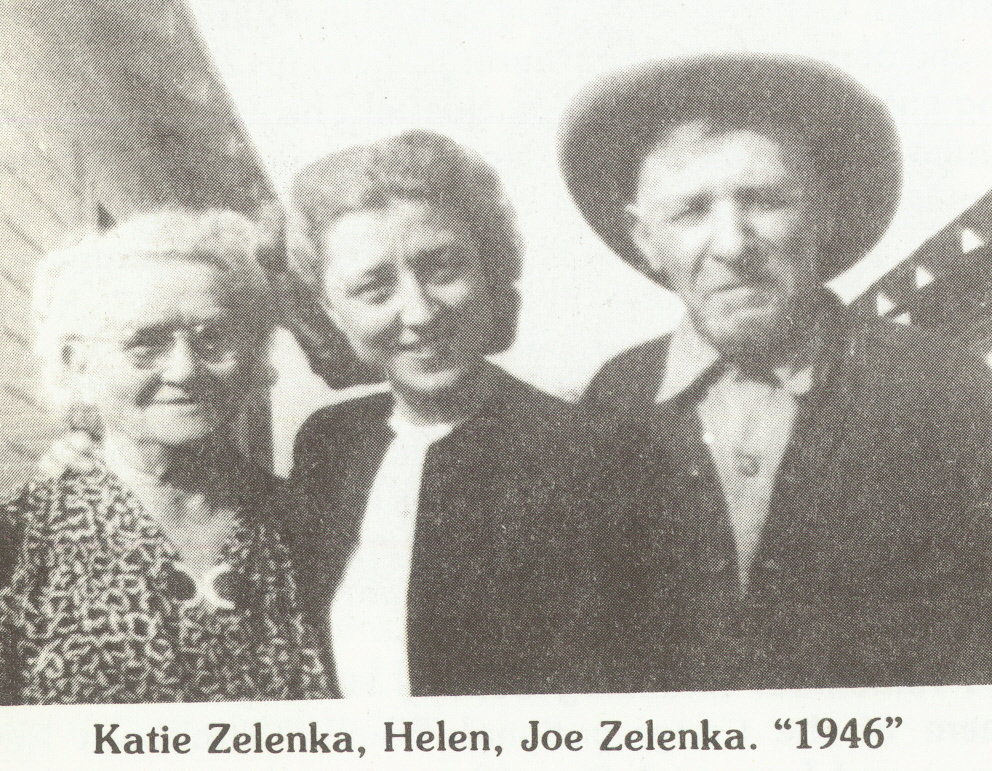
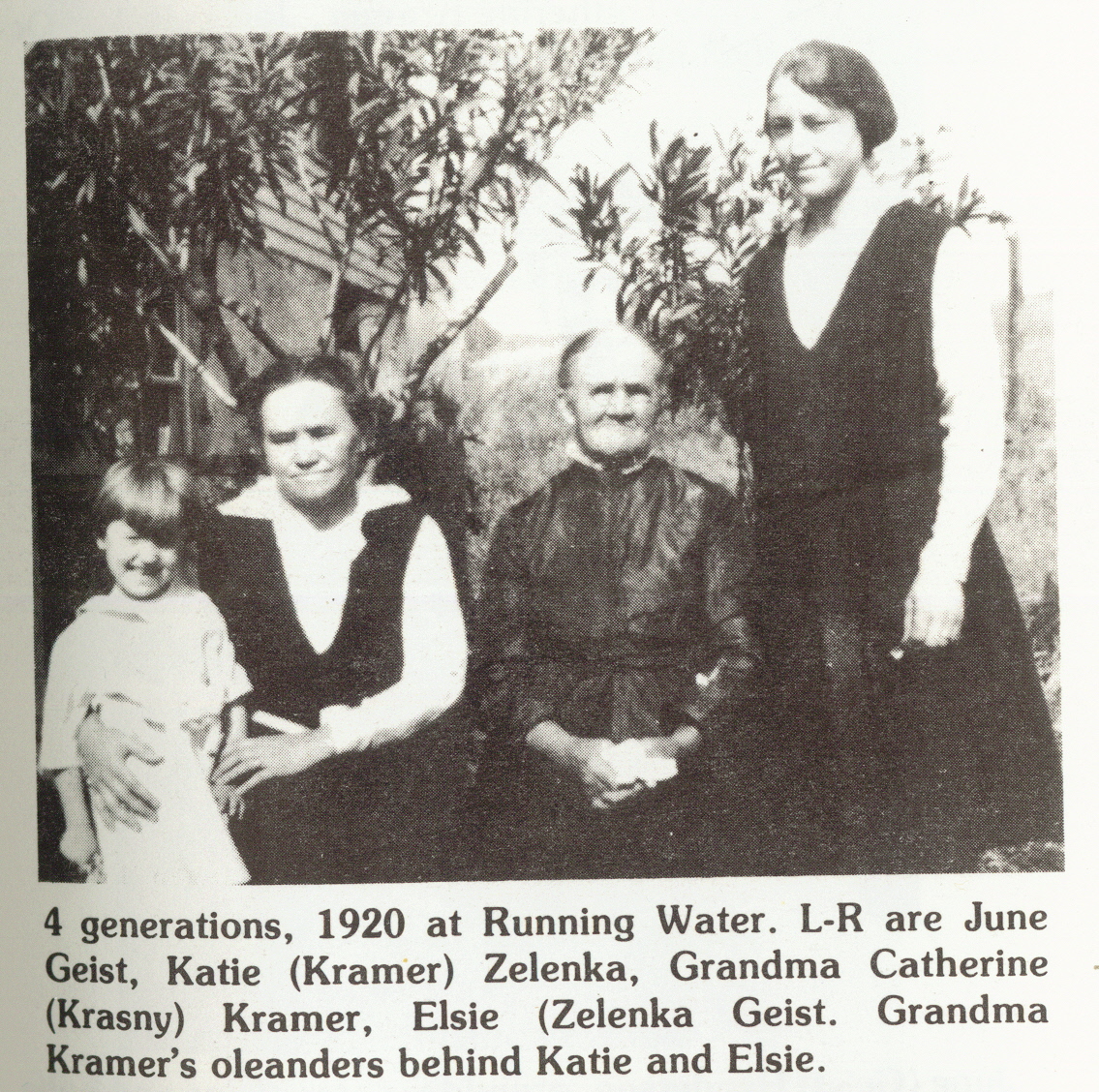
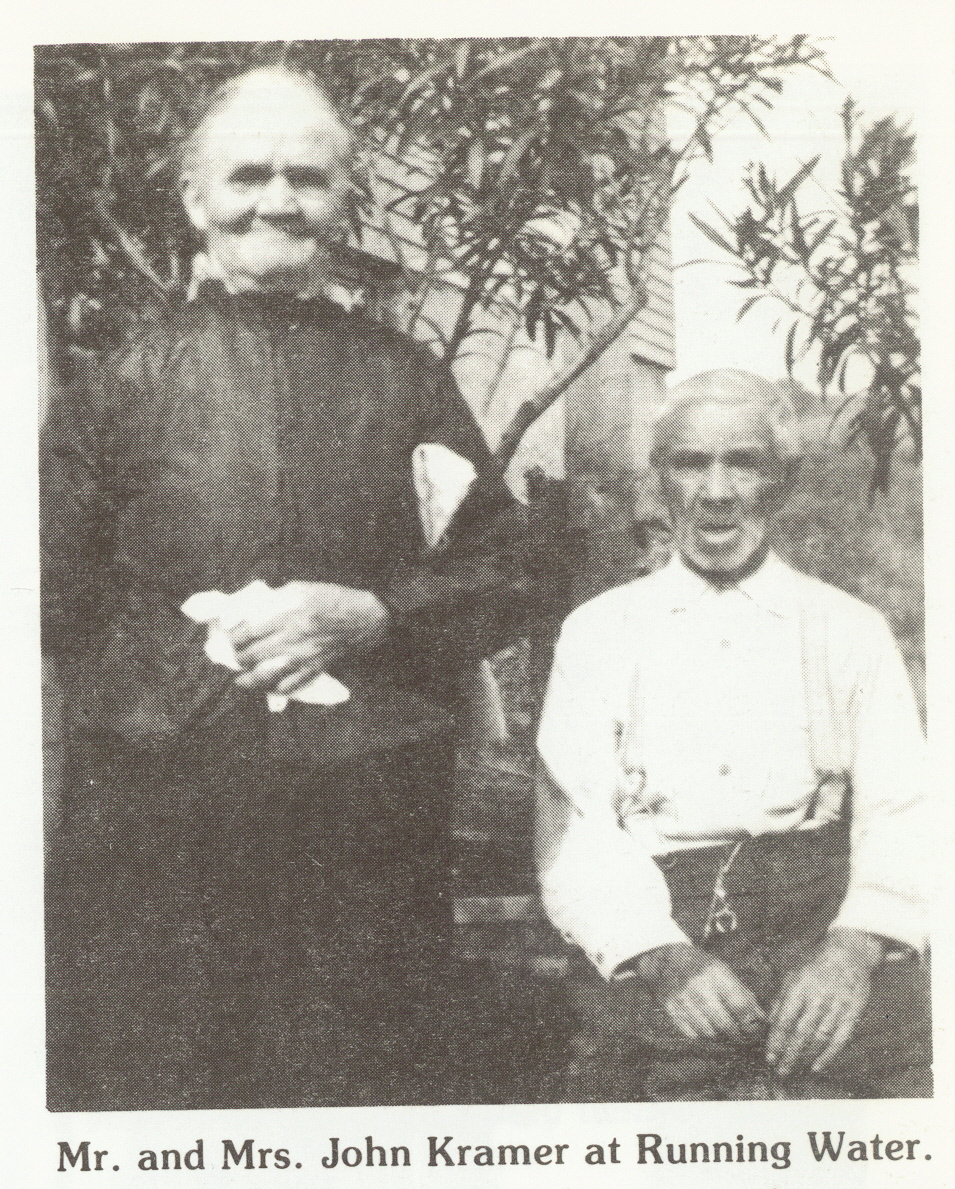
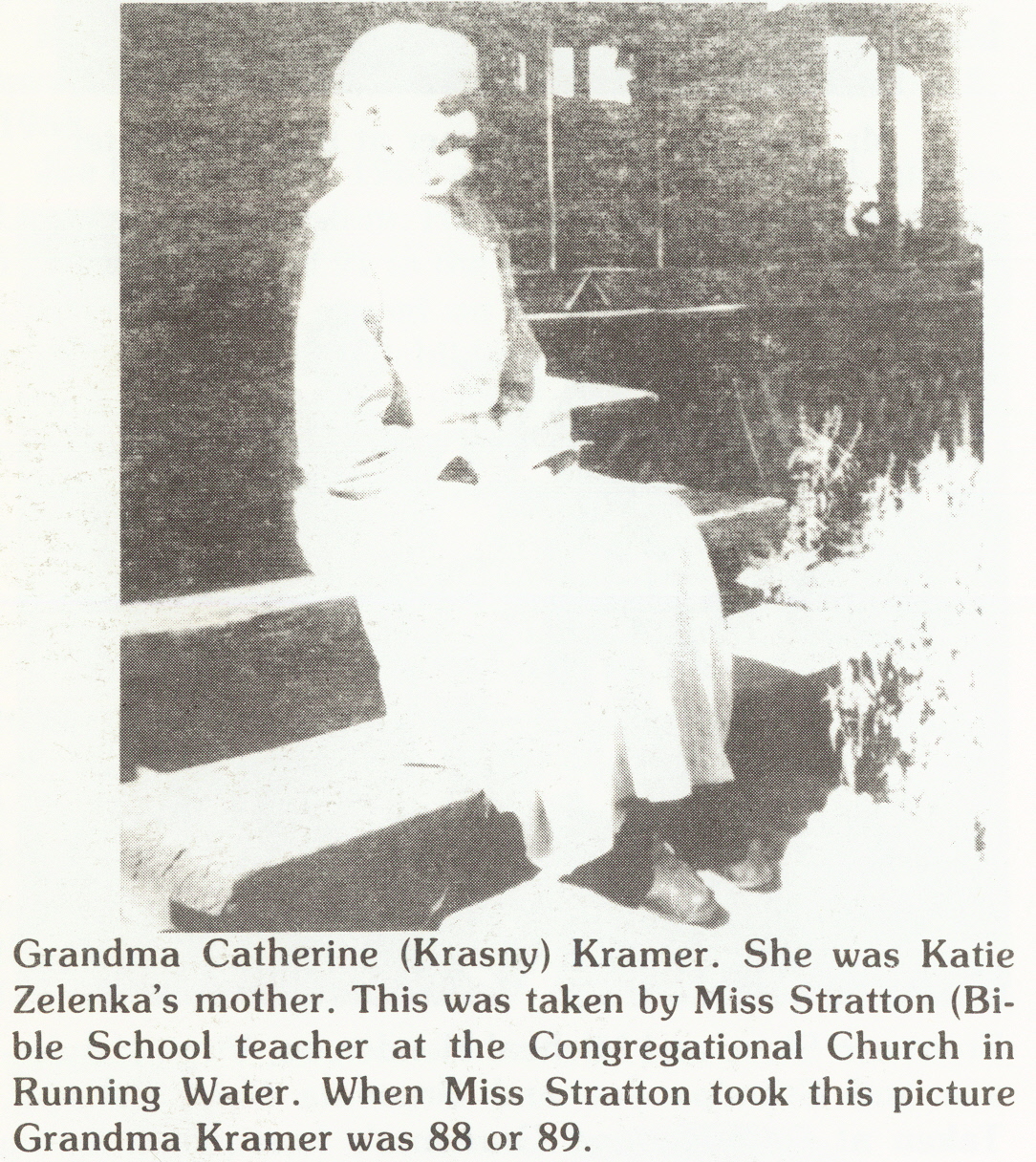
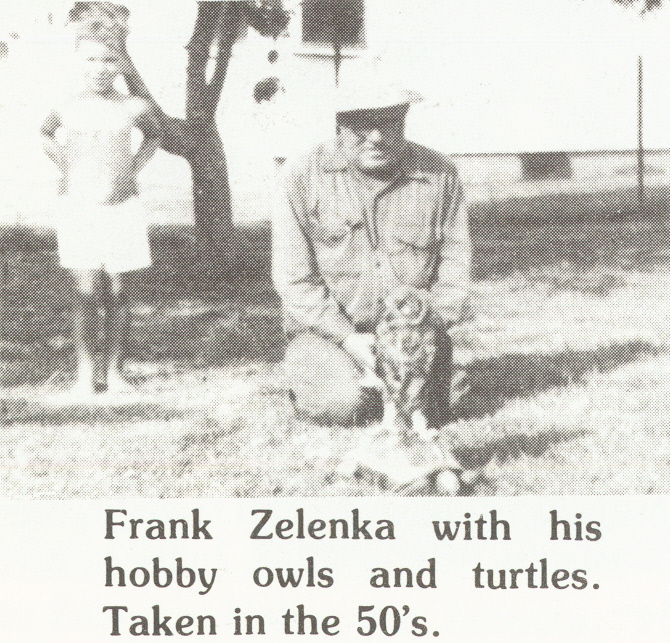
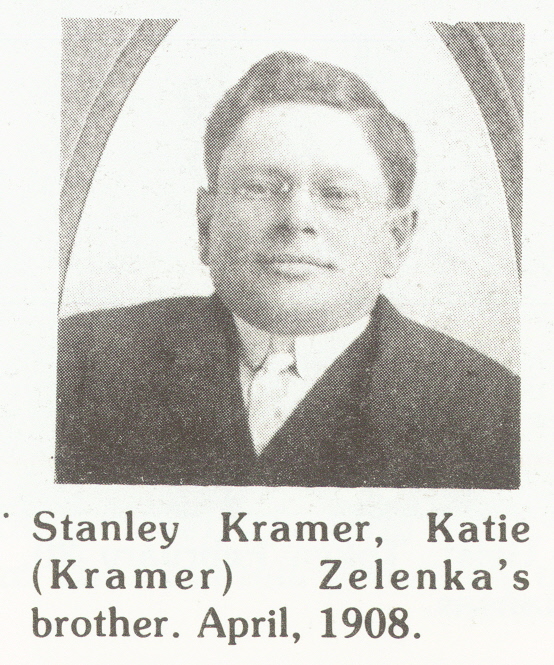
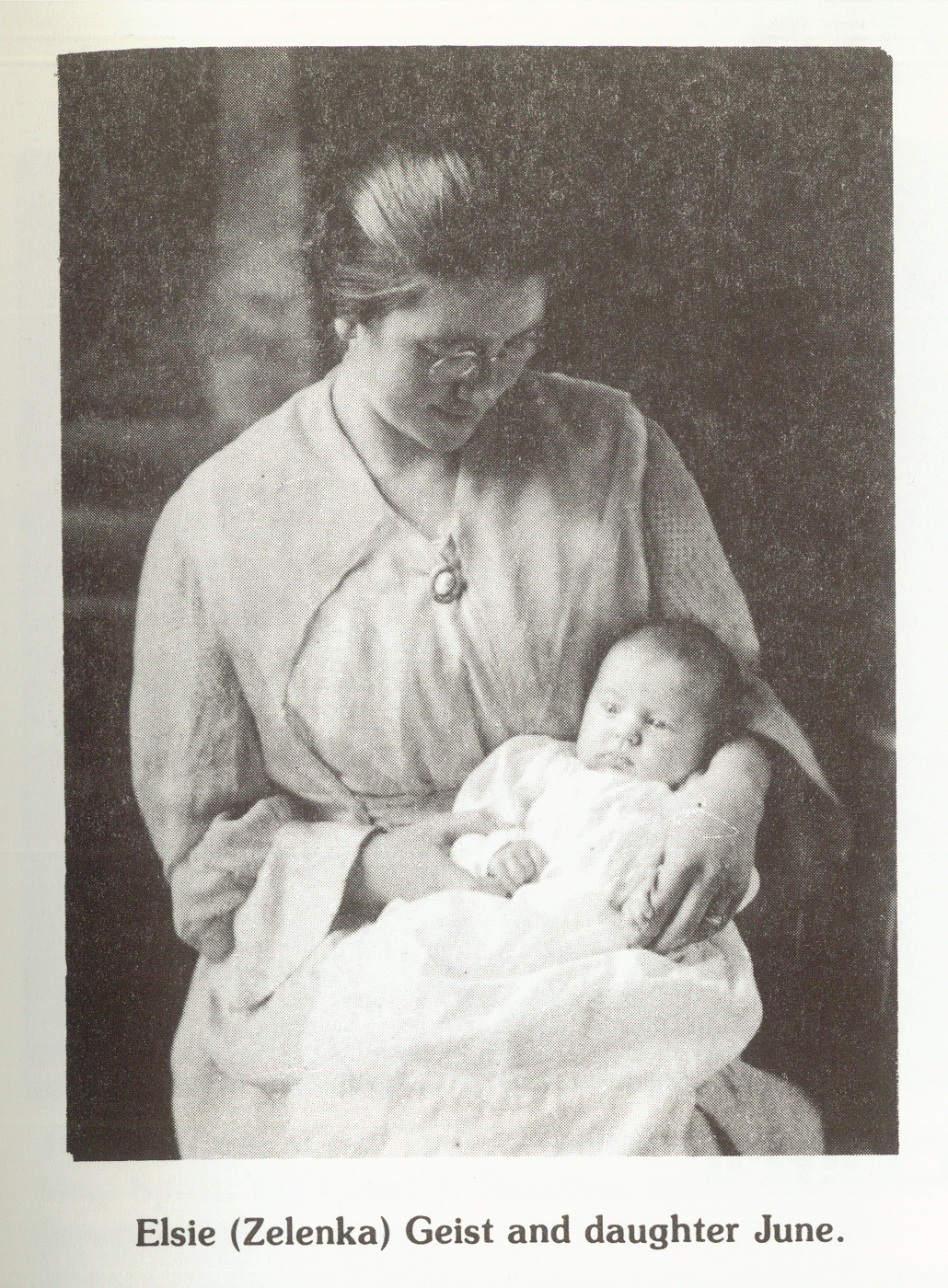
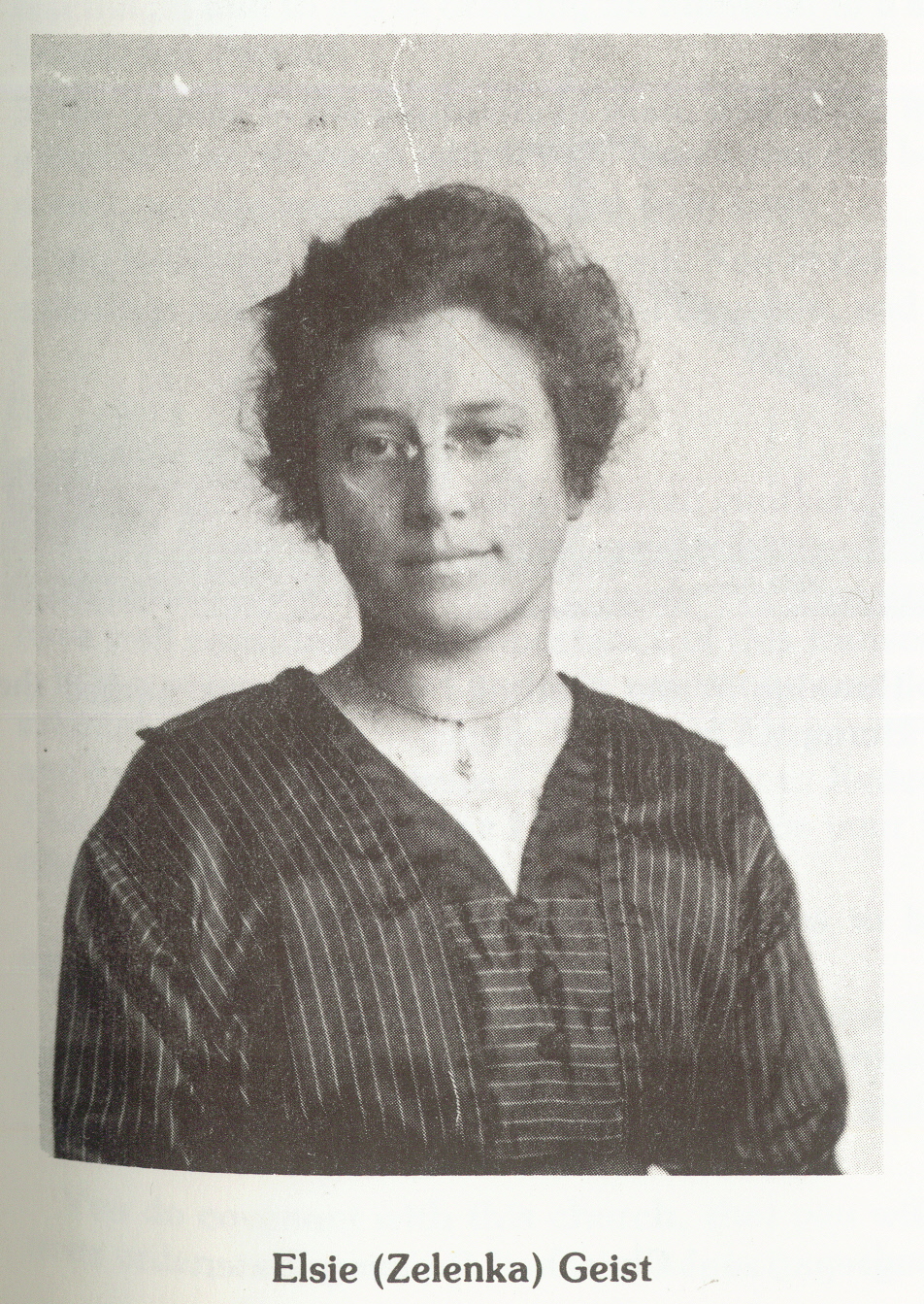
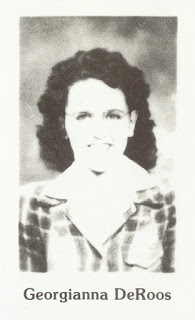
In the fall of 1944, after attending school at Southern State Teachers College in Springfield, I accepted a teaching position at Running Water. The school was located about 2 blocks east and half block north of Highway 37, it was an interesting year. I had only one evening I had to stay at the Peter Dykstra home because it was stormy weather.
This school had a large pot belly stove to heat it. We scooped several ton of coal that year. That year we had a very nice Christmas program that was enjoyed by the parents and friends. In good weather we spent many recesses playing kitten ball. I would like to list the students for that year, we had 15 students and 7 grades; Tiena Gelling, Janette Gelling, Annie Gelling, Wilma Gelling, Jean Warrington, James Lancrain, Erwin Eringa, Betty Homer, Darlene Homer, Donnie Homer, Arlene Millian, Joyce Lancrain, Allen Warrington, Donald Dykstra and Darwin Dykstra. At the time of teaching in 1944-1945, I was Georgianna DeRoos, I am now Mrs. Burnell Odens and I live in Springfield.
My parents were Mr. and Mrs. Jacob DeRoos, they lived on the ranch now known as the Waoka Club. This was located across the river from Niobrara, Nebraska. When we were growing up my brother, Gelvin, and I remember going to Running Water to enjoy seeing the ferry boat come from the Nebraska side. Also in the 30's I remember going to the grocery store there. My father took the grain elevator down for the lumber in about 1937. In about 1956 my father sold the Congregational Church and the school to Paul Howell of Sioux City, Iowa.
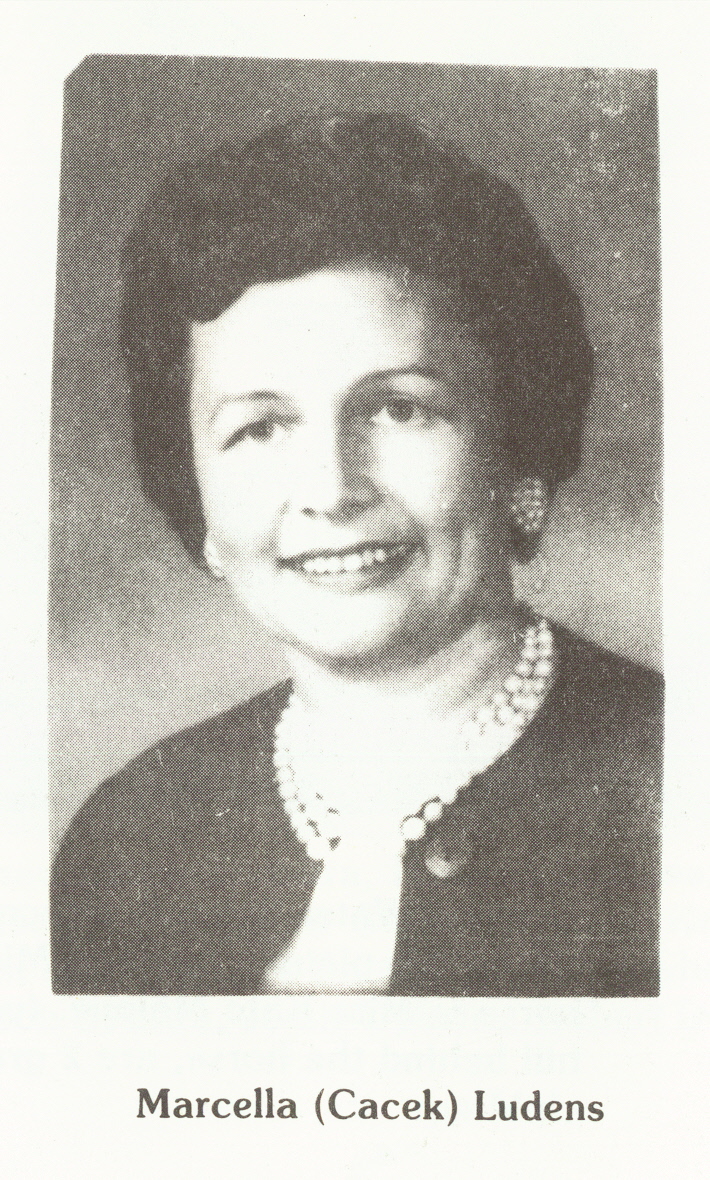
Mr. and Mrs. John C. (Marcella) Ludens and 5-year old son, Rennie Merrit, lived in the Running Water area three years (March 1953-March 1956) on a farm approximately 3 miles north of the town, known as the Donnelly place. It is now unoccupied. John grew up in the rural area west of Springfield, but Marcella (Cacek) Ludens was first introduced to Running Water in 1938.
She worked in Springfield that summer and would ride with the Gaynor families to visit the Larney Malones who lived on the farm now occupied by the Jody Genant family. Mrs. Lillie Gaynor and Mrs. Malone were sisters. The group would drive to Billman's General Store in Running Water to make a few purchases now and then, sometimes only a candy bar or gasoline.
In the fall of 1953, Mrs. Delmer (Juanita) Thompson was teaching at the rural school located in the town of Running Water, when her husband was instantly killed in an automobile accident. Because of this tragedy, Marcella Ludens took over the teaching duties on a temporary basis, and was there when the school doors closed for the very last time at the end of that semester. The 4 or 5 pupils were sent to other schools in the area, and the Ludens welcomed a new son, Merle Richard, into their family on January 31, 1954.
The school building was used for Running Water township election.
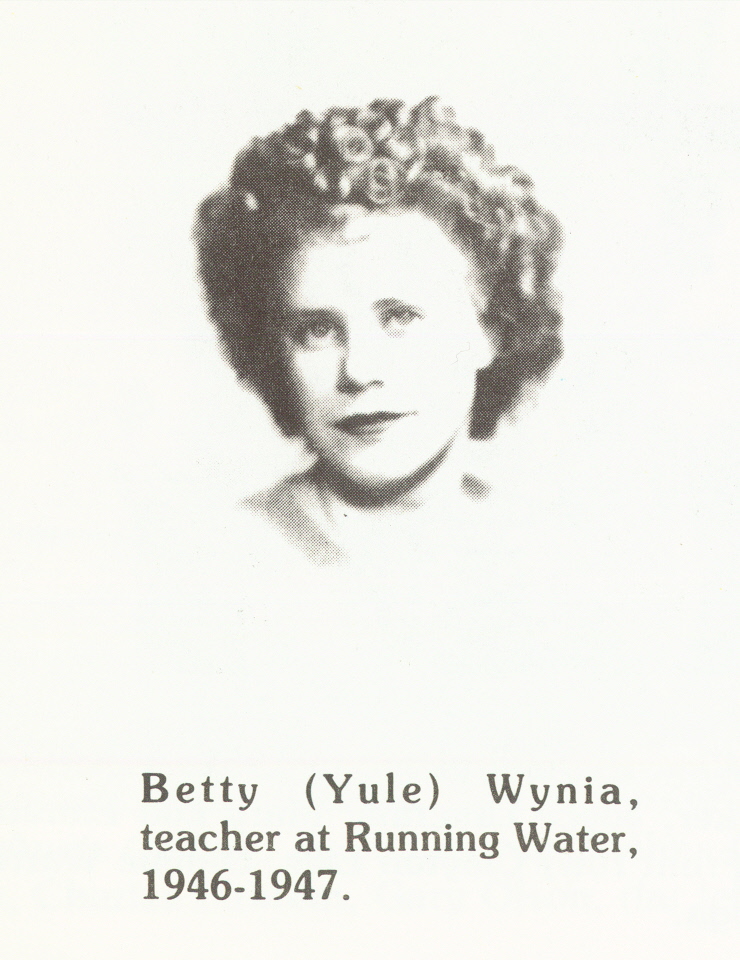
Betty Wynia taught Running Water School from September of 1946 to May of 1947. Teaching school in a one room rural school is quite an experience and a challenge.
One of the most memorable events of the year was the Christmas program, there was no lack of talent in those small school. The ferry boat ride and trips to Niobrara Park was a great field day.
